inbox and environment news: Issue 554
September 11 - 17, 2022: Issue 554
THE KING PARROT
When the wattle curls are browning,
When the blackwood's bloom is done,
When the gloom of Winter's frowning,
Flees before the waxing sun.
When the forest's tears have ended.
Regally arrayed and splendid.
Come I, like a gem afloat
In my Royal scarlet trousers
And my green tail-coat
Few among the singing gentry
Note my royal presence there.
Quietly I make my entry
With an unassuming air;
Till, on some hot noonday dreaming
'Mid the ripening grasses gleaming.
With surprised delight you note
My official scarlet trousers
And my green tail-coat
When the royal feast is over —
Kingly fare in bounty spread,
'Mid the cocksfoot and the clover —
I would seek the royal bed,
Then, my retinue attending,
Thro' the gums I flash, ascending
To my trumpet's piercing note,
In my gorgeous scarlet trousers
And my green tail-coat
— From 'The Singing Garden,' by C. J. Dennis.
THE KING PARROT (1936, August 20). Maryborough Chronicle, Wide Bay and Burnett Advertiser (Qld. : 1860 - 1947), p. 3. Retrieved from http://nla.gov.au/nla.news-article149994009
Dogs Off-Leash On Beaches Open For Feedback
- Do You Want Pittwater Leashed? Let The Council Know Why!
- Calls For Council To Address Dogs Offleash Everywhere After Two Serious Dog Attacks On Local Beaches In Same Week - owner has still not come forward or been identified as of Saturday August 6, 2022
- Sydney Dog Attack Victim Awarded $225, 000: July 2022
- Council Push For Dogs Off Leash On Family Beaches Among Wildlife Habitat - delves into 2022 Central Coast Council report that found 'Dog owners who are of the opinion that they and their dogs have priority access to the space, and other people are a secondary user' (on/of public beaches)
White faced heron landing at north Palm Beach, March 7th, 2022 during storm event. All native birds, reptiles, amphibians and mammals (except the dingo) are protected in New South Wales by the Biodiversity Conservation Act 2016 (BC Act).
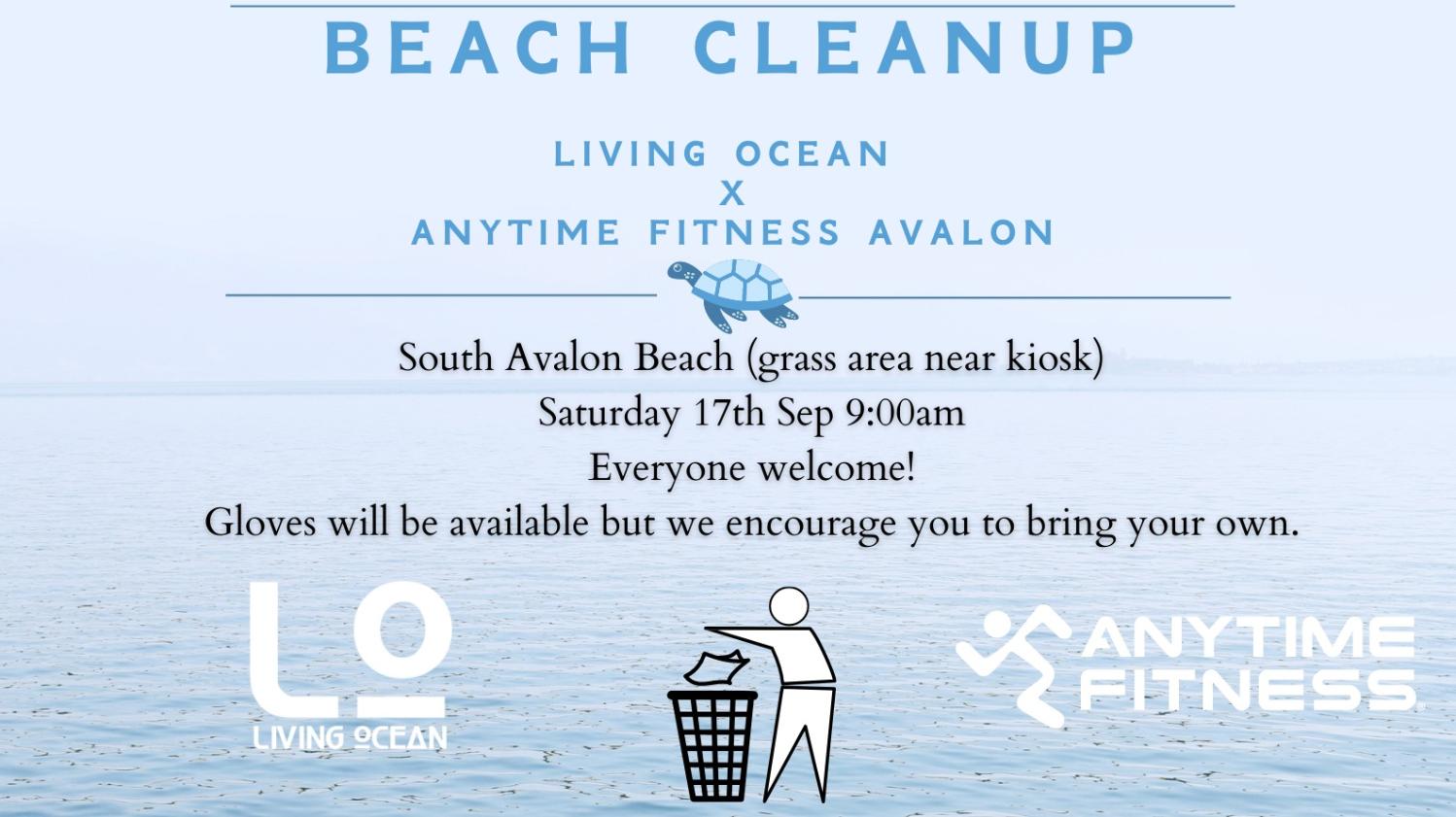
PNHA's Spring Nature Walks 2022
Pittwater Natural Heritage Association's (PNHA) next Nature Walk is on Sunday September 18 to see Grevillea caleyi, Waratahs and lots more +birds. Meet 9.30 at corner of Bulara st and Mallawa rd Duffys Forest. An easy stroll on a wide firetrack. RSVP to pnhainfo@gmail.com with your phone number if you’d like to come.September is Biodiversity Month — a month to appreciate the extraordinary web of life we are part of and to encourage the protection, conservation and growth of biodiversity within Australia and worldwide.
We celebrate Biodiversity Month every September, the first month of Spring, and promote the importance of:
- connecting with nature and
- caring for nature in all its diversity – its biodiversity!
The grevillea caleyi is listed as "critically endangered" under the Australian Government Environment Protection and Biodiversity Conservation Act 1999 and the New South Wales Government Biodiversity Conservation Act 2016.
More in: Saving Grevillea Caleyi: Join The Baha’i Temple Bushcare Group
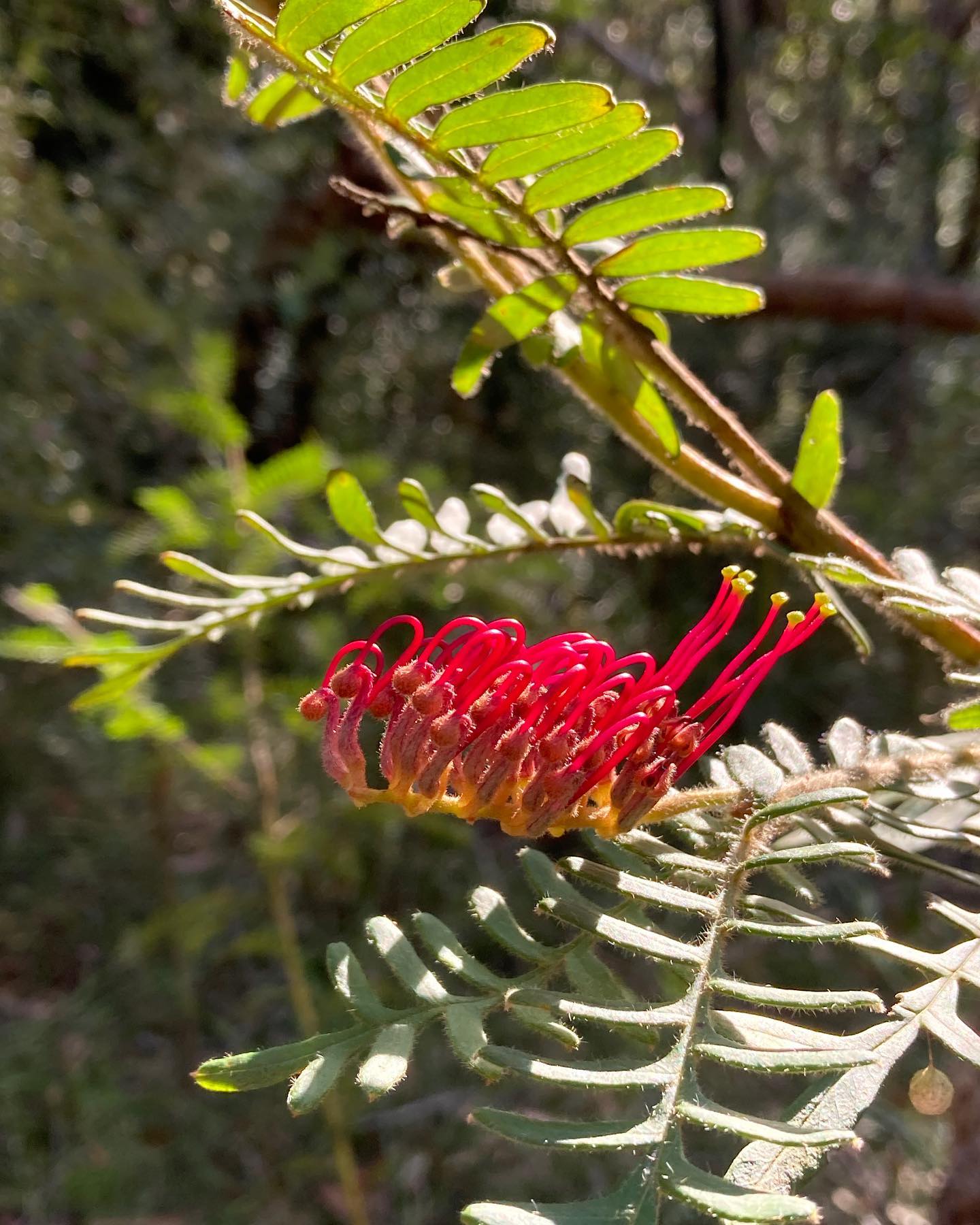
Grevillea caleyi. Photo: PHNA
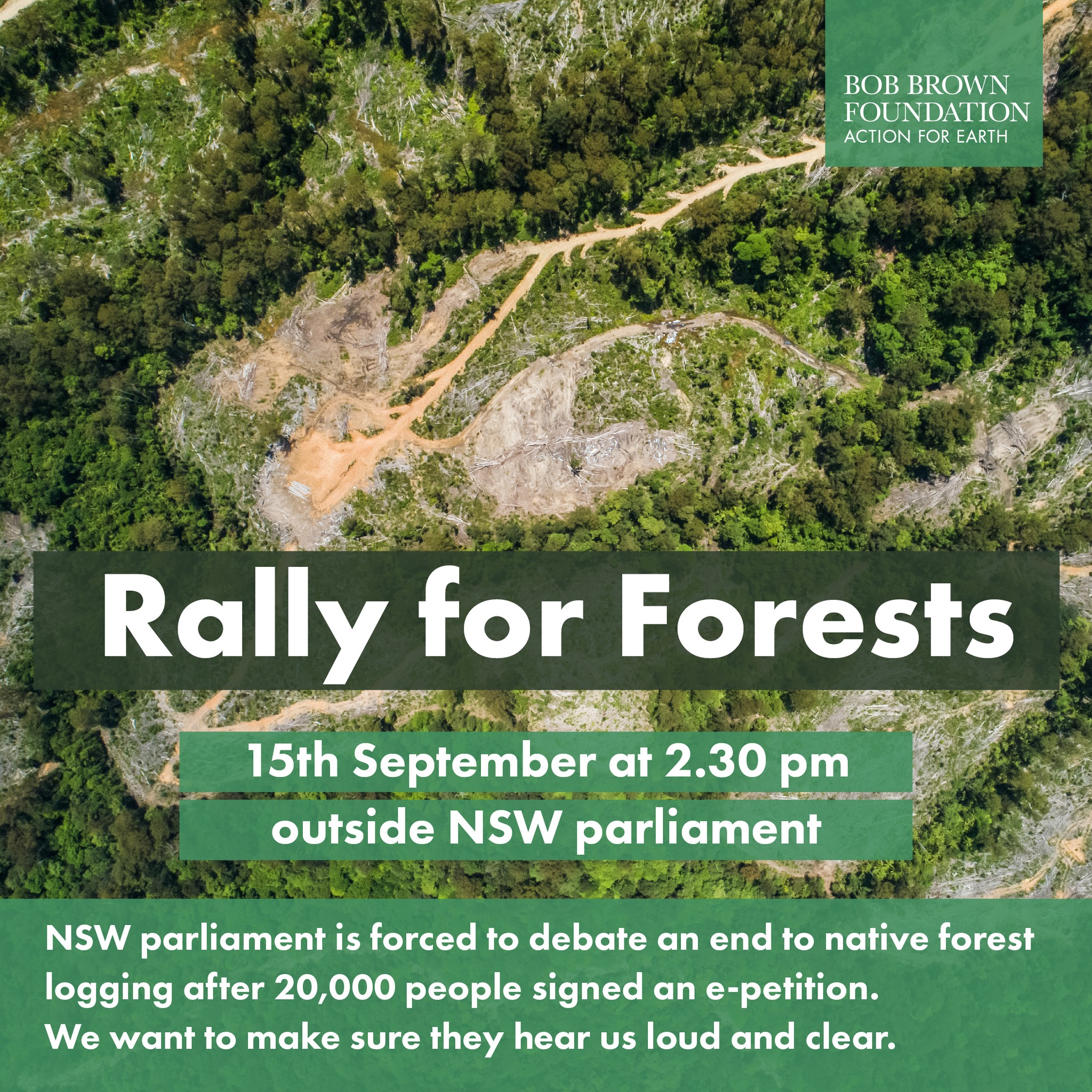
Katandra Bushland Sanctuary Open
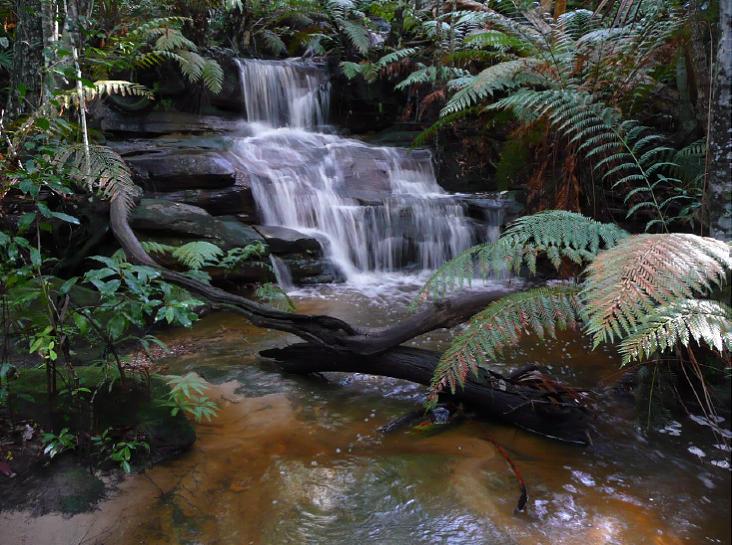
Ku-Ring-Gai Sculpture Trail For 2022 Eco Festival


Dust Off Your Picnic Blankets For The First Ever Statewide Picnic For Nature
Echidna 'Love Train' Season Commences
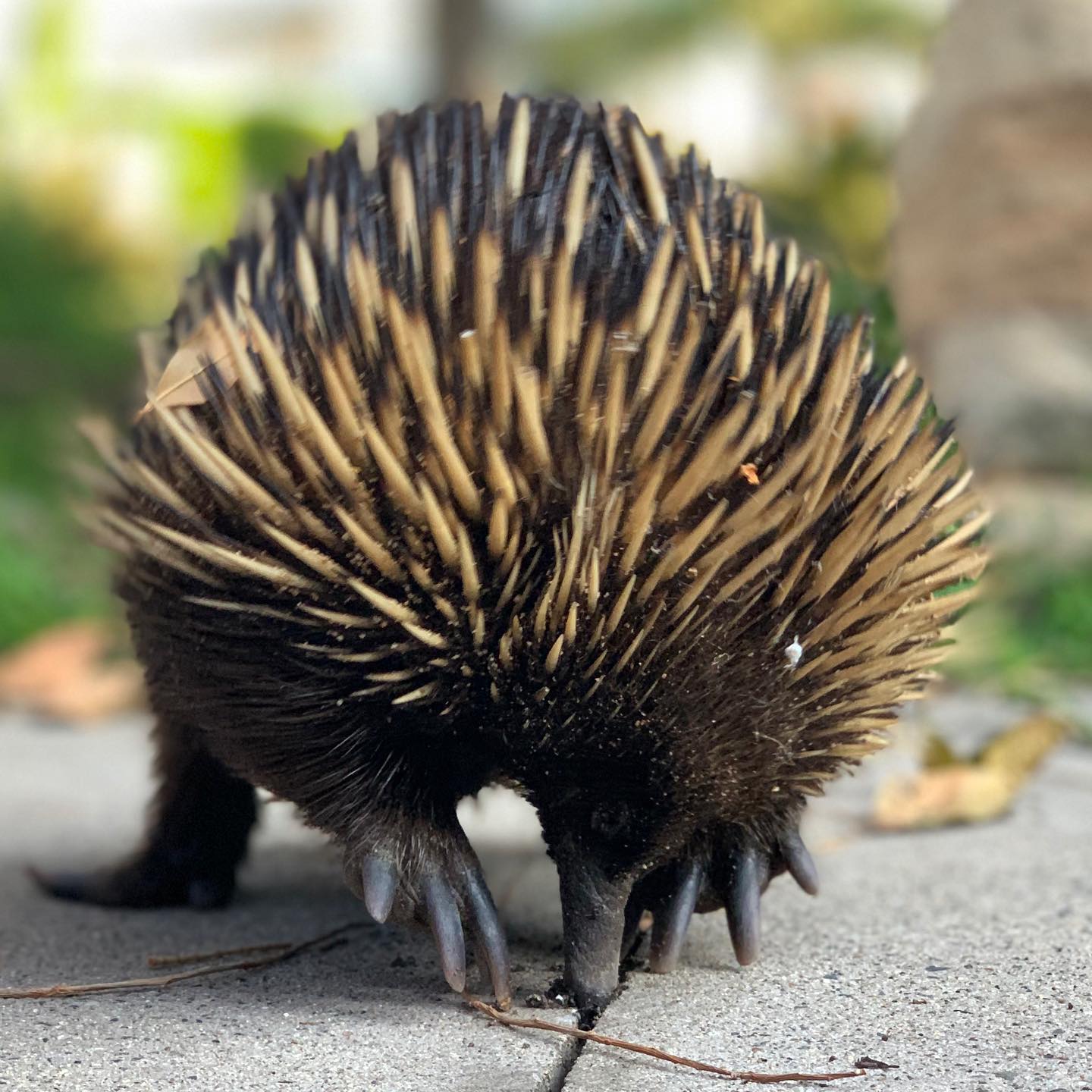
EPA Releases Climate Change Policy And Action Plan
September 8, 2022
The NSW Environment Protection Authority (EPA) is taking action to protect the environment and community from the impacts of climate change, today releasing its new draft Climate Change Policy and Action Plan which works with industry, experts and the community to reduce greenhouse gas emissions and support resilience.
NSW EPA Chief Executive Officer Tony Chappel said the EPA has proposed a set of robust actions to achieve a 50 per cent reduction in carbon emissions by 2030 (from 2005 levels), ensure net zero emissions by 2050, and improve resilience to climate change impacts.
“NSW has ambitious targets that align with the world’s best scientific advice and the Paris commitments, to limit global warming to an average of 1.5 degrees in order to avoid severe impacts on ecosystems,” Mr Chappel said.
“Over the past few years we have seen first-hand just how destructive the impacts of climate change are becoming, not only for our environment, but for NSW communities too.
“We know the EPA has a critical role to play in achieving the NSW Government’s net-zero targets and responding to the increasing threat of climate change induced weather events.
“Equally, acting on climate presents major economic opportunities for NSW in new industries such as clean energy, hydrogen, green metals, circular manufacturing, natural capital and regenerative agriculture.
“This draft Policy sends a clear signal to regulated industries that we will be working with them to support and drive cost-effective decarbonisation while implementing adaptation initiatives that build resilience to climate change risks.
“Our draft plan proposes a staged approach that ensures the actions the EPA takes are deliberate, well informed and complement government and industry actions on climate change. These actions will support industry and allow reasonable time for businesses to plan for and meet any new targets or requirements.
“Climate change is an issue that we all face so it’s important that we take this journey together and all play our part in protecting our environment and communities for generations to come.”
Actions include:
- working with industry, government and experts to improve the evidence base on climate change
- supporting licensees prepare, implement and report on climate change mitigation and adaptation plans
- partnering with NSW Government agencies to address climate change during the planning and assessment process for activities the EPA regulates
- establishing cost-effective emission reduction targets for key industry sectors
- providing industry best-practice guidelines to support them to reduce their greenhouse gas emissions
- phasing in the introduction of greenhouse gas emission limits on environment protection licences for key industry sectors
- developing and implementing resilience programs, best-practice adaptation guidance and harnessing citizen science and education programs
- working with EPA Aboriginal and Youth Advisory Committees to improve the EPA’s evolving climate change response
EPA Acting Chair Carolyn Walsh said the EPA is a partner in supporting and building on the NSW Government’s work to address climate change for the people of NSW.
“The draft Policy and Action Plan adopts, supports and builds on the strong foundations that have been set by the NSW Government through the NSW Climate Change Policy Framework, Net Zero Plan and Climate Change Adaptation Strategy,” Ms Walsh said.
The EPA will work with stakeholders, including licensees, councils, other government agencies, and the community to help implement the actions.
The draft EPA Climate Change Policy and Action Plan is available at https://yoursay.epa.nsw.gov.au/ and comments are open until 3 November 2022.
Magpie Breeding Season: Avoid The Swoop!
- Try to avoid the area. Do not go back after being swooped. Australian magpies are very intelligent and have a great memory. They will target the same people if you persist on entering their nesting area.
- Be aware of where the bird is. Most will usually swoop from behind. They are much less likely to target you if they think they are being watched. Try drawing eyes on the back of a helmet or hat. You can also hold a long stick in the air to deter swooping.
- Keep calm and do not panic. Walk away quickly but do not run. Running seems to make birds swoop more. Be careful to keep a look out for swooping birds and if you are really concerned, place your folded arms above your head to protect your head and eyes.
- If you are on your bicycle or horse, dismount. Bicycles can irritate the birds and the major cause of accidents following an encounter with a swooping bird, is falling from a bicycle. Calmly walk your bike/horse out of the nesting territory.
- Never harass or provoke nesting birds. A harassed bird will distrust you and as they have a great memory this will ultimately make you a bigger target in future. Do not throw anything at a bird or nest, and never climb a tree and try to remove eggs or chicks.
- Teach children what to do. It is important that children understand and respect native birds. Educating them about the birds and what they can do to avoid being swooped will help them keep calm if they are targeted. Its important children learn to protect their face.
Wanted: Photos Of Flies Feeding On Frogs (For Frog Conservation)
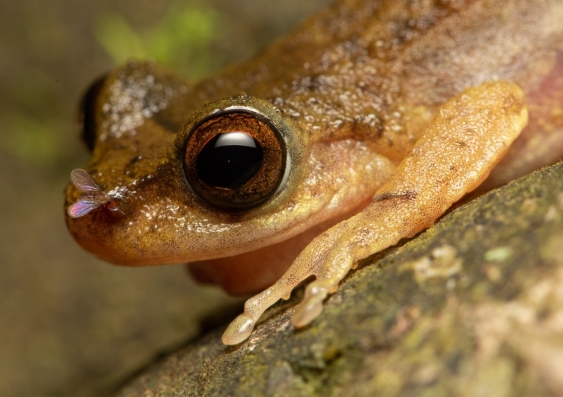
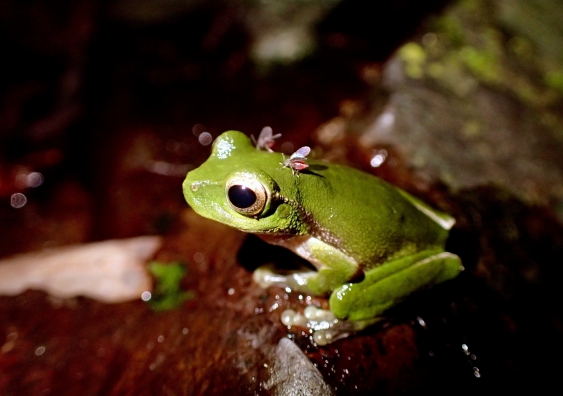
Possums In Your Roof?: Do The Right Thing

Local Wildlife Rescuers And Carers State That Ongoing Heavy Rains Are Tough For Us But Can Be Tougher For Our Wildlife:
- Birds and possums can be washed out of trees, or the tree comes down, nests can disintegrate or hollows fill with water
- Ground dwelling animals can be flooded out of their burrows or hiding places and they need to seek higher ground
- They are at risk crossing roads as people can't see them and sudden braking causes accidents
- The food may disappear - insects, seeds and pollens are washed away, nectar is diluted and animals can be starving
- They are vulnerable in open areas to predators, including our pets
- They can't dry out and may get hypothermia or pneumonia
- Animals may seek shelter in your home or garage.
You can help by:
- Keeping your pets indoors
- Assessing for wounds or parasites
- Putting out towels or shelters like boxes to provide a place to hide
- Drive to conditions and call a rescue group if you see an animal hit (or do a pouch check or get to a vet if you can stop)
- If you are concerned take a photo and talk to a rescue group or wildlife carer
There are 2 rescue groups in the Northern Beaches:
Sydney Wildlife: 9413 4300
WIRES: 1300 094 737
Please be patient as there could be a few enquiries regarding the wildlife.
Generally Sydney Wildlife do not recommend offering food but it may help in some cases. Please ensure you know what they generally eat and any offerings will not make them sick. You can read more on feeding wildlife here
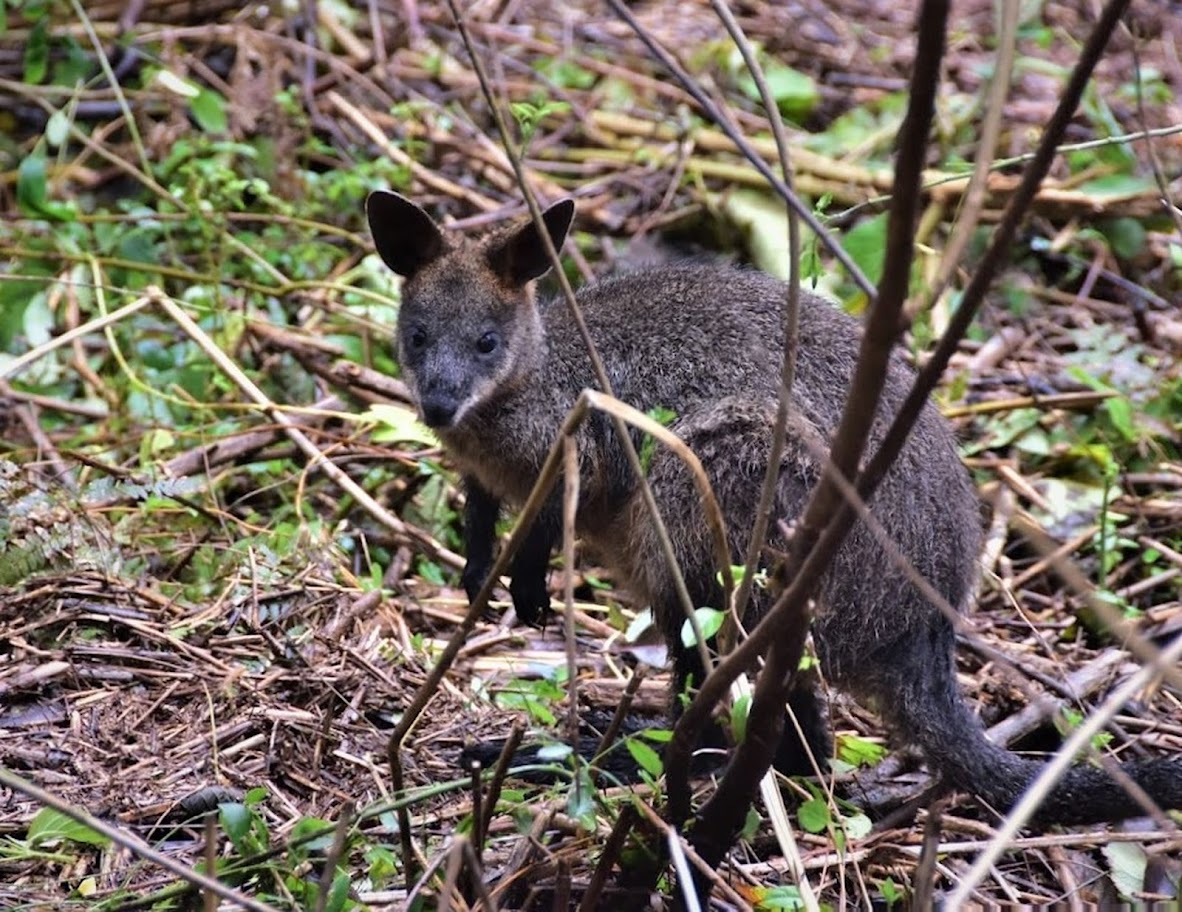
Information courtesy Ed Laginestra, Sydney Wildlife volunteer. Photo: Warriewood Wetlands Wallaby by Kevin Murray, March 2022.
Aviaries + Possum Release Sites Needed

Sydney Wildlife Rescue: Helpers Needed

Bushcare In Pittwater
Where we work Which day What time
Avalon
Angophora Reserve 3rd Sunday 8:30 - 11:30am
Avalon Dunes 1st Sunday 8:30 - 11:30am
Avalon Golf Course 2nd Wednesday 3 - 5:30pm
Careel Creek 4th Saturday 8:30 - 11:30am
Toongari Reserve 3rd Saturday 9 - 12noon (8 - 11am in summer)
Bangalley Headland 2nd Sunday 9 to 12noon
Bayview
Winnererremy Bay 4th Sunday 9 to 12noon
Bilgola
North Bilgola Beach 3rd Monday 9 - 12noon
Algona Reserve 1st Saturday 9 - 12noon
Plateau Park 1st Friday 8:30 - 11:30am
Church Point
Browns Bay Reserve 1st Tuesday 9 - 12noon
McCarrs Creek Reserve Contact Bushcare Officer To be confirmed
Clareville
Old Wharf Reserve 3rd Saturday 8 - 11am
Elanora
Kundibah Reserve 4th Sunday 8:30 - 11:30am
 Mona Vale
Mona Vale Mona Vale Beach Basin 1st Saturday 8 - 11am
Mona Vale Dunes 2nd Saturday +3rd Thursday 8:30 - 11:30am
Newport
Bungan Beach 4th Sunday 9 - 12noon
Crescent Reserve 3rd Sunday 9 - 12noon
North Newport Beach 4th Saturday 8:30 - 11:30am
Porter Reserve 2nd Saturday 8 - 11am
North Narrabeen
Irrawong Reserve 2nd Saturday 2 - 5pm
Palm Beach
North Palm Beach Dunes 3rd Saturday 9 - 12noon
Scotland Island
Catherine Park 2nd Sunday 10 - 12:30pm
Elizabeth Park 1st Saturday 9 - 12noon
Pathilda Reserve 3rd Saturday 9 - 12noon
Warriewood
Warriewood Wetlands 1st Sunday 8:30 - 11:30am
Whale Beach
Norma Park 1st Friday 9 - 12noon
Western Foreshores
Coopers Point, Elvina Bay 2nd Sunday 10 - 1pm
Rocky Point, Elvina Bay 1st Monday 9 - 12noon
Gardens And Environment Groups And Organisations In Pittwater
The Impact Of Megafires On Estuaries From Australia's 'Black Summer'
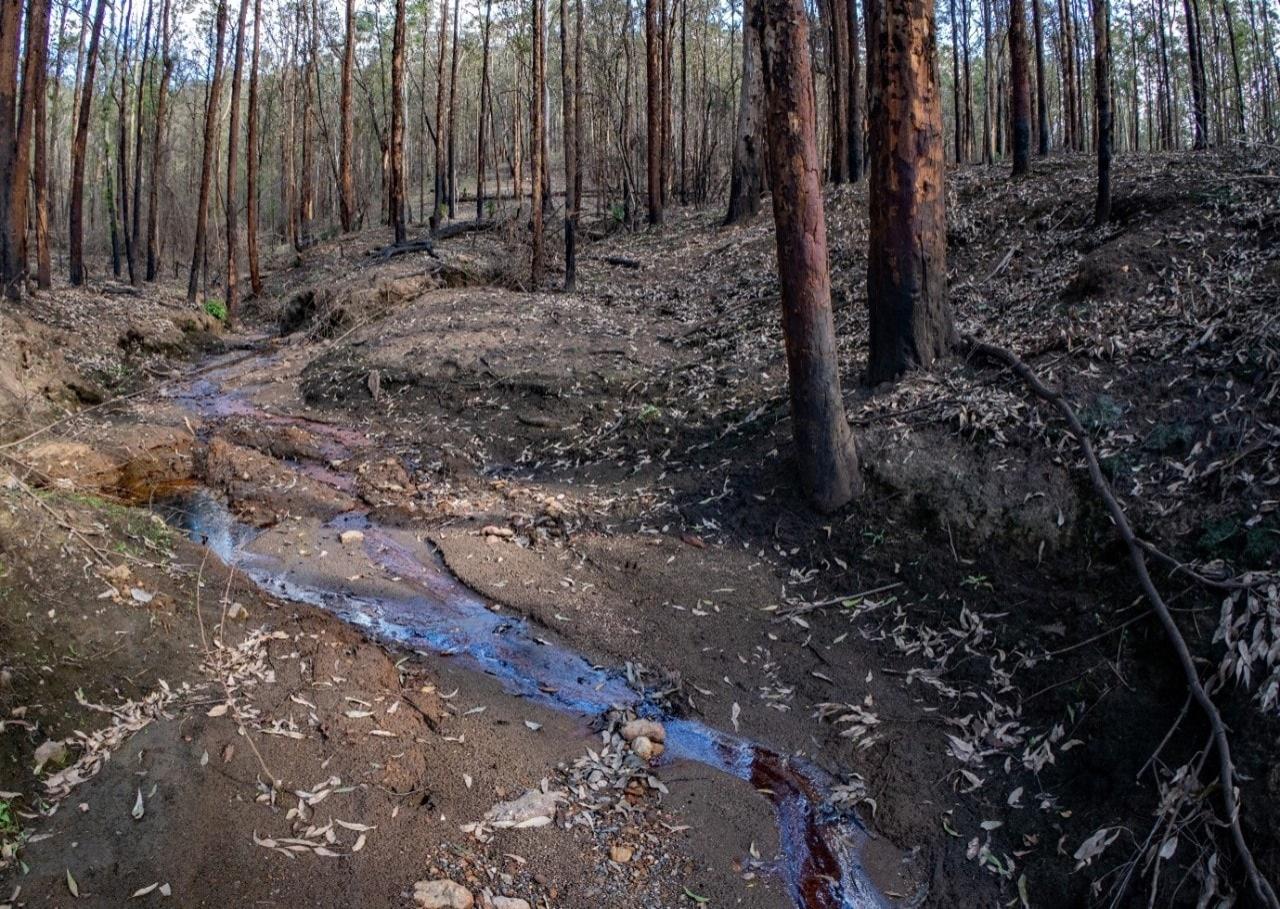
September 2022
Australian researchers have explored the impact of bushfires on estuaries in New South Wales, Australia's largest state, finding fires can increase the load of fire-derived pollutants with potentially profound environmental effects.
Estuaries (where the river meets the sea) are some of the most valuable habitats on earth. As well as being biologically diverse and productive places, they are where ports are located, and a significant portion of the world's population is concentrated.
Published in Environmental Pollution, the researchers say their findings prompt a call for riverside vegetation to be prioritised for protection in fire management plans, and for bushfires to be considered in catchment management plans. These plans are developed to protect the environment and regulate resources, such as fish and water, from the whole catchment area (from tributaries to estuaries).
Unlike regular bushfires, megafires such as those that occurred during Australia's 2019-2020 'Black Summer', can surround estuaries.
Following the Black Summer fires, the research team measured a rapid increase in the concentration of nutrients, metals and pyrogenic carbon (carbon formed by fires) in nearshore areas that could affect the behaviour, survival and reproduction of estuarine species.
"In some catchments, more than 90 percent of the vegetation was burnt, and the fire went right down to the waters edge, leading to a massive amount of pollution in the form of sediment, metals and nutrients entering our waterways," said senior author Professor Emma Johnston, a marine ecosystems expert and the Deputy Vice-Chancellor (Research) at the University of Sydney.
The researchers found that the material from the Black Summer fires contained traces of metals including copper and zinc, and nutrients such as nitrogen and phosphorus that sunk onto estuarine sediments.
"If there is consistent flushing of the estuary then these trace elements will prime them for productivity. However, if water flow is low and flushing is minimal, they can cause microalgae to breed exponentially, leading to plankton blooms that deplete oxygen supplies and kill fish, with a domino effect on the entire ecosystem," said Professor Johnston.
Fire Carbon
The study also revealed how much pyrogenic carbon was deposited in estuaries -- the bushfires' calling card.
"We've not been concerned about pyrogenic-carbon in these waters before, but now that climate change is increasing the extent and severity of wildfires around the world, we suddenly need to know what concentrations of pyrogenic carbon cause harm. That should be the subject of further study," Professor Johnston said.
Impact and Actions
With current climate projections suggesting megafires like Black Summer will occur more frequently in Australia and around the world, the authors say governments must factor our vital estuary habitats into their fire prevention and management plans.
"Considering that excessive nutrient input is one of the main stressors on estuaries, the changes found in our study might have serious implications due to its potential to alter ecological and physico-chemical processes," said lead author Thayanne Barros, PhD candidate from the University of New South Wales.
Among the actions the authors propose are maintaining natural vegetation buffers to prevent fires from reaching the edge of estuaries, and ecotoxicological assessments of wildfire impacts on estuarine areas.
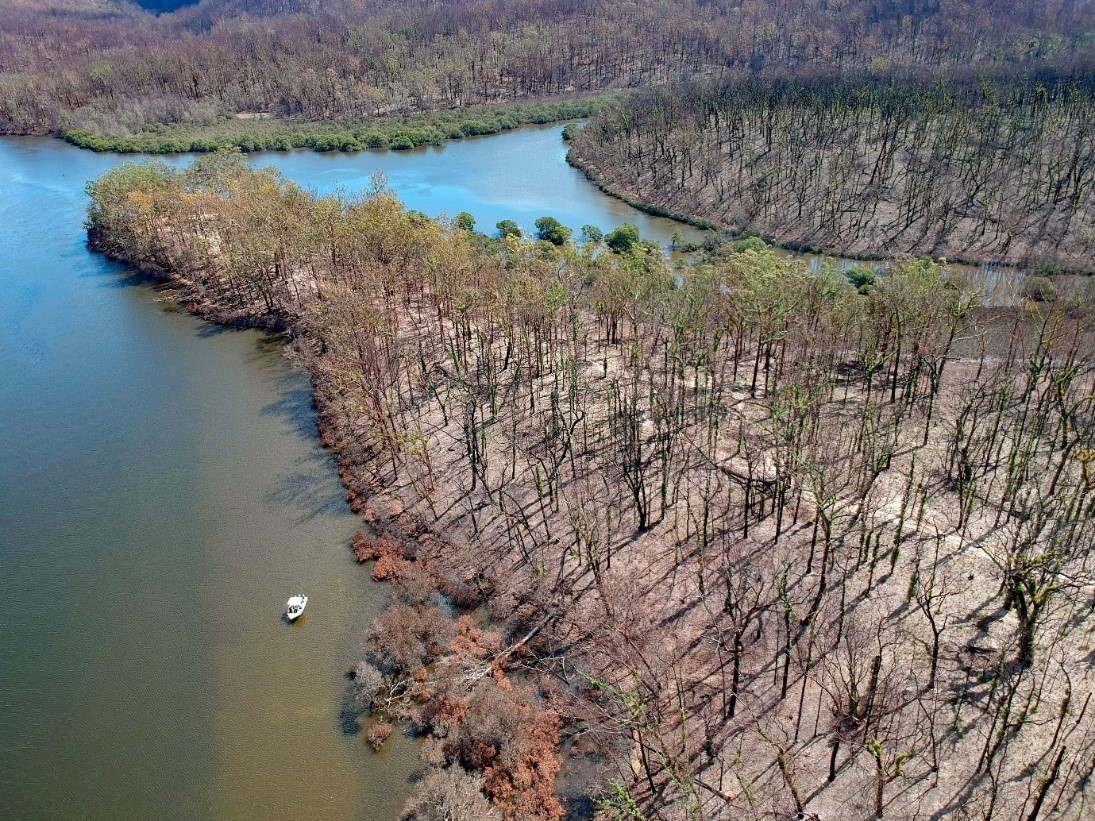
The burnt zone reaches all the way to the edge of the water at Clyde River/Batemans Bay. Photo credit: John Turnbull
The author's concern about the impact of fires on waterways is shared by an international research consortium, of which Professor Johnston is a member. The consortium's new paper names wildfires as one of 15 emerging threats to ocean biodiversity.
About the study
The researchers studied six estuaries on the New South Wales coast, at the mouths of the rivers Hastings; Karuah; Georges; Shoalhaven; Clyde; and Moruya immediately before the fires.
Ms Barros said: "We had just finished collecting samples for a different project when the fires started, so we saw a unique opportunity to conduct a Before-After-Control-Impact study in these areas. The initial samples became our 'before the fires' dataset and when the fires ceased we collected the samples for our 'after the fires dataset'."
To investigate the potential impacts of bushfires on estuaries, the researchers decided to focus on the soft sandy bottom of the estuaries since this habitat is an important source and sink of elements and plays a major role in global biogeochemical cycles, simultaneously supporting high biodiversity and productivity.
They analysed the sediments to check for changes in nutrient concentrations, sediment silt content, metals, and different forms of carbon, including pyrogenic carbon (formed by fires) in order to directly link changes in carbon concentration to the bushfires.
Estuaries were categorised according to the percentage of the catchment vegetation that was burnt and the proximity of the burnt zone to the waterway.
The study shows that in those estuaries with a large proportion of the catchment burnt and little gap between the fire and the waterway, the concentration of different forms of carbon, nutrients, metals and silt content significantly increased after the fires. While no significant changes were detected in the unburnt estuaries or those that retained a buffer zone.
The study was a collaboration between researchers at the University of Sydney, CSIRO, Macquarie University, University of New South Wales and received funding support from the World Wide Fund for Nature (WWF).
Thayanne L. Barros, Sally A. Bracewell, Mariana Mayer-Pinto, Katherine A. Dafforn, Stuart L. Simpson, Mark Farrell, Emma L. Johnston. Wildfires cause rapid changes to estuarine benthic habitat. Environmental Pollution, 2022; 308: 119571 DOI: 10.1016/j.envpol.2022.119571
We pay billions to subsidise Australia’s fossil fuel industry. This makes absolutely no economic sense

Fossil fuel subsidies from major economies including Australia reached close to US$700 billion in 2021, almost doubling from 2020, according to new analysis by the International Energy Agency and OECD.
These subsidies are expected to keep rising in 2022 as governments worldwide attempt to use fossil fuel subsidies to shield customers from the high energy prices caused by Russia’s invasion of Ukraine.
Australia spends billions each year giving subsidies to the fossil fuel industry, despite our climate change commitments. The Australia Institute estimates that in the 2021-22 budget period, Australian federal and state governments’ total fossil fuel subsidies cost A$11.6 billion. That’s up $1.3 billion on the previous year.
Subsidies play an important role in economies like Australia. By pushing the prices of things down below the cost of producing them, subsidies make everything from schools and hospitals to the ABC and childcare much cheaper and more widely available than they would otherwise be.
But it makes absolutely no economic sense to provide subsidies to things that a government is, or should be, trying to discourage.
Australia Is A Top Emitter
Back in 2009 Australia and the other major economies that make up the G20 all promised to phase out “inefficient fossil fuel subsidies”.
But as the new report makes clear, the policy reality of many countries doesn’t come close to matching their ambitious rhetoric of reining in public funding for the major cause of climate change.
Australia is one of the largest emitters of greenhouse gasses in the world. Despite our relatively low population, we come in 15th for total emissions and 8th for per capita emissions. Only major fossil fuel-producing nations rank higher, such as Qatar and the United Arab Emirates.
We are even more “successful” at exporting fossil fuels than burning them, ranking third in the world behind only Saudi Arabia and Russia.
Despite Labor’s improved target to cut 43% of Australia’s emissions by 2030, Australia is still looking to open up huge new coal and gas projects.
Australia is failing at transitioning away from fossil fuels. Emissions from burning fossil fuels in transport, electricity and industry are all much higher now than they were back in 1997 when Australia signed on to the Kyoto Protocol.
Our fossil fuel exports have risen strongly since then as well, with 114 new fossil fuel projects awaiting approval in Australia, many for the export market.
Subsidies Play A Major Role In This
The federal government subsidises the cost of exploring for coal, oil and gas in Australia, the infrastructure needed to extract and transport those fossil fuels, and then subsidises the use of them as well.
Of the $11.6 billion Australian governments spent on this in 2021-2022, $10.5 billion is accounted for by the federal government alone.
By far the largest of the federal subsidy is the $8 billion Fuel Tax Credit Scheme. This refunds the cost of diesel fuel excise to select industries, with around half going to mining industries.
The cost of these diesel excise refunds is greater than the annual $7.5 billion budget for the Australian Army.
Subsidies work, but only if we are subsidising things we want more of. It’s important we subsidised vaccines to help manage the COVID crisis, and that the previous and current federal governments subsidise renewable energy.
But subsidising fossil fuels when you are trying to transition away from them is like subsidising cigarettes when you are trying to encourage people to quit.
So far, the new government hasn’t indicated it has any plans to cease subsidising fossil fuels.
Economists call subsidies for things governments are ostensibly trying to discourage, “perverse”. So why would the Albanese government continue to spend billions on fossil fuel subsidies, and delay the transition away from coal and gas that voters and climate scientists want to see the back of?
Reasoning Is Numerous And Bizarre
The arguments for keeping Australia’s perverse subsidies are as numerous as they are bizarre.
One argument is that subsidies will help people manage rising energy costs. But direct cash payments to low income earners would be a far cheaper and more equitable solution. Subsidies lock in the status quo, while cash supports help smooth the transition away from climate-wrecking industries.
Back in 2011, after signing on to the G20 pledge to phase out fossil fuel subsidies, the Gillard government declared it had no subsidies to phase out.
But documents released under the freedom of information act showed the treasury had, in fact, identified 17 fossil fuel subsidies that should have been declared and phased out.
At the other end of the spectrum, Senator Matt Canavan argued in 2016 that because all previous coal mines in Australia have benefited from subsidies, it would have been unfair to not subsidise the Adani mine as well.
Labor’s Minister for Resources Madeleine King stated to the Guardian last month: “projects involving these traditional [fossil fuel] energy sources stack up environmentally, economically, and socially, we will support them.”
But if they need expensive subsidies to “stack up”, then they clearly aren’t economically viable. And if the fossil fuel industry doesn’t need the subsidies, then why would any government keep providing them?
Removing fossil fuel subsidies should be the first step taken by any government serious about reducing greenhouse gas emissions. What the latest data makes clear is that its not just Australian governments that are yet to muster the political courage to do something so simple.![]()
Richard Denniss, Adjunct Professor, Crawford School of Public Policy, Australian National University
This article is republished from The Conversation under a Creative Commons license. Read the original article.
‘Untenable’: even companies profiting from Australia’s carbon market say the system must change
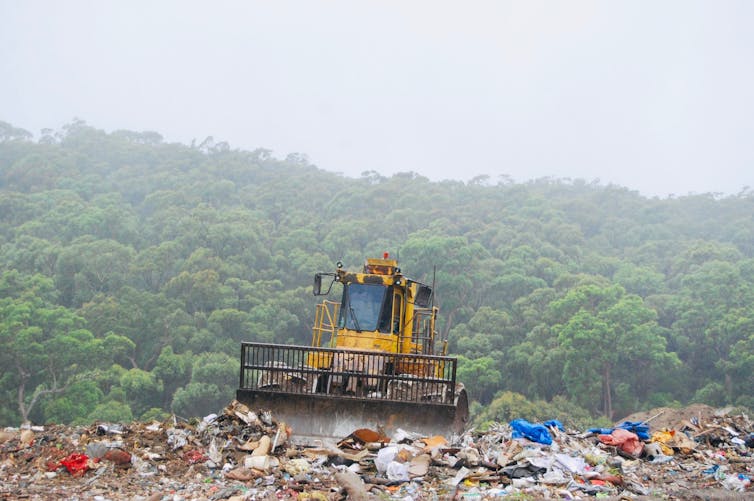
This week, several of the largest companies that profit from Australia’s carbon market called for changes to the system. They said the rules that govern the issuing of carbon credits to some projects were too lax and the market’s integrity should be improved.
The companies operate projects under what are known as “landfill gas methods”. Using these methods, landfill gas companies capture and burn methane generated by decomposing rubbish, turning it into carbon dioxide – a less potent greenhouse gas. In return, they receive carbon credits.
The industry’s decision to speak out is an important development. It shows a significant proportion of the carbon market is willing to work constructively to improve the system.
Australia’s carbon credit system is now being reviewed. The federal government must seize this opportunity to ensure the system performs well for taxpayers and the environment.

What’s This All About?
Under the Emissions Reduction Fund, projects that reduce greenhouse gas emissions are granted carbon credits. These credits can be sold to the federal government or to private entities that are required, or voluntarily choose, to offset their emissions.
The fund, which began operating in 2014, was the centrepiece of the Coalition government’s climate policy and will continue under Labor.
I’m a former chair of the Emissions Reduction Assurance Committee, the government-appointed body that oversees the fund’s methods. Earlier this year, my colleagues and I went public with details of serious integrity issues with the scheme, including landfill gas projects.
More than 100 landfill projects currently claim carbon credits for destroying landfill gas. They account for almost 30% of carbon credits issued under the fund.
These projects are registered under four separate methods, including one established late last year for projects that use methane to generate electricity. The concerns about landfill projects centre on this method.

What’s Wrong With The New Method?
A key principle that underpins the integrity of carbon offset markets around the world is the concept of “additionality”. It means that the carbon abatement for which companies receive credits must be additional to what would have happened otherwise, without the incentive provided by the scheme.
In the case of landfill gas projects, additionality problems arise because most landfills would destroy methane even without the incentive provided by carbon credits. That’s because they’re required to do this under state laws governing air pollution and safety. These legal requirements mean not all carbon abatement at landfills is additional to what would have occurred anyway.
The landfill methods seek to address this issue using something known as a “baseline”, which is a prescribed proportion of the methane combusted at landfill sites. This baseline is deducted when calculating carbon credits. So for example, if a project has a 30% baseline and destroys 100 tonnes of greenhouse gases, it will be credited only for 70 tonnes.
To be conservative, the baseline proportion should at least represent what operators are legally required to destroy. This is made challenging by the fact that the state regulatory conditions are often drafted in imprecise terms. This makes it hard to set baselines that accurately reflect the regulatory requirements.
In 2011-12, when the original landfill gas methods were being devised, the government and industry agreed on a default minimum baseline of 30%. But most of the biggest landfill gas projects were allowed to use baselines below 30%, and roughly ten projects were given 0% baselines.
This was a product of a deal that allowed operators to use baselines that applied under older offset schemes.
These concessions were meant to expire around now. But the new landfill gas method extended the concessional arrangements, allowing the larger landfill projects to keep using their low baselines for another five years.
And there’s another problem.
Carbon credits are not the only means through which large landfill sites can profit from destroying methane. Using generators, they can harness the heat from burning methane to produce electricity. They can then sell this electricity, as well as earn and sell renewable energy certificates. So even if they don’t receive carbon credits, the sites with generators will often destroy more methane than they are legally required to.
The baselines should account for this fact, but they don’t. They assume that, in the absence of carbon credits, landfills would only ever destroy what they are required to by law. This assumption is not true, particularly at larger landfills.
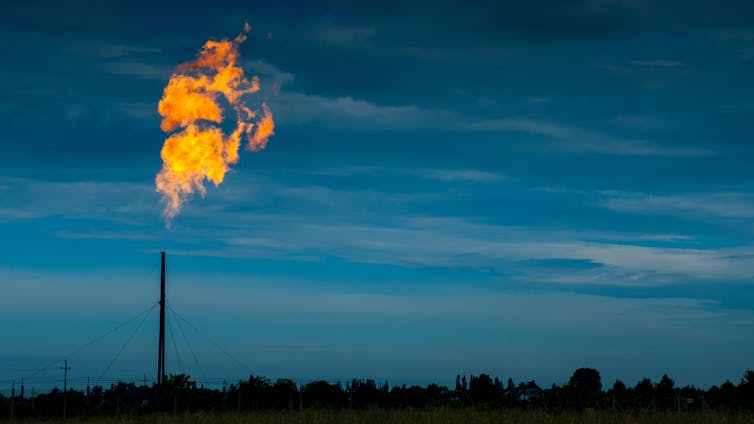
Way Forward
The Clean Energy Regulator and the Emissions Reduction Assurance Committee deny any problems with the new landfill gas method. But the industry’s statements this week have made their position untenable.
John Falzon, chair of LMS Energy, is among those calling for a change to the way credits are calculated. He told the ABC:
If the market doesn’t have integrity it’ll crash, so the business itself will collapse with that […] We would forgo some short-term revenue for the opportunity to participate in a market that is more robust and has more credibility and that provides a future.
The actions taken by the industry have created a unique opportunity to fix the landfill gas method and, in the process, showcase how to put Australia’s carbon credit system back on the rails.
The Clean Energy Regulator, which oversees Australia’s carbon credit system, provided the following response:
As has always been our practice, the Clean Energy Regulator welcomes genuine feedback and scrutiny. The independent Review of Australian Carbon Credit Units (ACCUs), led by Professor Ian Chubb, is underway. The landfill gas method is within their terms of reference. The Clean Energy Regulator is actively assisting this review and is currently considering the new information on the method that has been reported in the last few days.![]()
Andrew Macintosh, Professor and Director of Research, ANU Law School, Australian National University
This article is republished from The Conversation under a Creative Commons license. Read the original article.
Miniscule Fine Handed To Fracking Company Origin Energy Over Major Contamination Spill
September 7, 2022
Activist organisation Lock the Gate Alliance says a $60,000 fine handed to fracking company Origin Energy for releasing 800,000 litres of contaminated coal seam gas waste water onto Queensland farms and rivers will do nothing to deter similar behaviour in the future.
Origin recently posted a profit of $407 million - up 30 percent from the previous year.
Lock the Gate Alliance also says the Queensland Palaszczuk Government needs to explain why the fine was not immediately made public when it was handed to Origin in July and was only this morning reported by the media, given the Environment Department issued four press releases – detailing lesser offences by smaller entities – within days of the Origin court case.
Similarly, Environment Minister Meaghan Scanlon issued three media statements on July 15 - the day Origin received its penalty - none of which had anything to do with the court case.
“This laughable fine and lack of transparency by the Palaszczuk Government once again exposes the uncomfortably close relationship the coal seam gas industry has with decision makers in Queensland,” said Lock the Gate Alliance spokesperson Carmel Flint.
“A fine of $60,000 is pocket change for a company like Origin and will do nothing to dissuade it or similar companies polluting like this again in the future.
“This sorry incident also exposes Queensland’s insufficient coal seam gas waste management laws - the government has acknowledged there is no long term solution to deal with the many millions of tonnes of toxic brine waste the coal seam gas industry produces.
“Instead, this waste is, for the moment, left to stew in holding ponds which poses a major risk, potentially leading to events like this one where waste escapes into creeks and onto neighbouring land.
“The weather forecast is for another wet summer in Queensland and we hold grave fears that we will see another, perhaps even worse, contamination event such as this.”
NSW Approves Most Greenhouse Gas Intensive Coal Project Since Paris Agreement
September 6, 2022
The Independent Planning Commission’s reckless and irresponsible approval of a coal mine expansion that will be responsible for nearly one billion tonnes of carbon emissions shows the desperate need for a national approach to assessing major polluting projects that considers their climate change impacts, says Lock the Gate Alliance.
The Alliance is now calling on Federal Environment Minister Tanya Plibersek to refuse the Mount Pleasant expansion project, given she has the final say on its future.
As well, the decision to approve the project comes less than two months after a legless lizard living within the expansion’s footprint was confirmed to be an entirely new species.
The expansion will also threaten Wonnarua cultural heritage sites, and worsen air quality for Muswellbrook residents.
Lock the Gate Alliance NSW coordinator Nic Clyde said the approval was evidence of a broken planning system.
“It is madness that as humanity teeters on the brink of climate catastrophe, an assessment authority such as the IPC can wave through a coal mine that will be solely responsible for 876 million tonnes of greenhouse gas emissions,” he said.
“This project is the largest coal mine expansion approved in the state since the Paris Agreement called on nations of the world to limit global warming to 1.5 degrees yet is totally inconsistent with that pledge.
“As if the global climatic ramifications of this decision are not bad enough, it could also lead to the extinction of a species of legless lizard only confirmed as new to science two months ago.
“It will tear up irreplaceable Wonnarua Cultural Heritage Sites, and blanket Hunter communities who are already struggling with respiratory related health conditions with clouds of coal dust.
“Future generations will shake their head in horror that this coal mine was approved in the face of all that we know about its climate and direct impacts.”
Media Release – From; Neighbours Of Fish Farming, 8 September, 2022
ANOTHER MASS SALMON ESCAPE IN THE HUON!
TENS OF THOUSANDS OF SALMON ESCAPE INTO THE HUON RIVER AS AQUACULTURE MANAGEMENT YET AGAIN REVEALS DISASTROUS PRACTICE
On Tuesday 6th September, residents along the Huon River were confronted by fishing tinnies busily trying to catch the feral Atlantic salmon whose mass escape is the most recent of a long history of failures by the aquaculture industry.
There are now tens of thousands of carnivorous adult fish attempting to survive in our local waterways, already facing heavily-depleted native wildlife populations.
The industry will typically say that scientific studies show that escapes don’t cause significant ecological issues, but overseas reports and local eye-witness accounts tell a different story.
Canadian studies reveal that by day 14 after escape, 24 per cent of examined caged salmon are found to be predating on wild fish.
https://www.adfg.alaska.gov/static/home/library/PDFs/afrb/mortv9n2.pdf
Tasmanian communities have every right to know automatically when these escapes occur and which company is responsible. It seems this is another example of an under-funded, weak at best, Environmental Protection Agency.
“What penalties apply for such breaches, and will they even be applied in this case?” demanded Neighbours of Fish Farming Campaigner, Jessica Coughlan.
In Norway and Chile, salmon giants Mowi were fined $750,000 and $9.5 million respectively over mass fish escapes. What message is the Tasmanian government sending international operators by not applying penalties?
“Carnivorous Atlantic salmon outcompete and indeed eat, our native fish and shellfish species, already affected by ocean warming, pollution, and overfishing,” said Ms Coughlan.
The entire industry is soon to be in the hands of foreign companies. Under Australian law, the Government must insist on full and timely transparency, and where applicable, heavy penalties. These are preventable, ecological disasters happening in our backyards—with no immediate notice from either Huon Aquaculture or Tassal.
The community wants to know how escapes continue to happen in an industry boasting sustainability. This is not ‘world’s best practice’.
Faster In The Past: New Seafloor Images Of West Antarctic Ice Sheet Upend Understanding Of Thwaites Glacier Retreat
Australia finally has new climate laws. Now, let’s properly consider the astounding social cost of carbon
Thomas Longden, Australian National University; Richard Norman, Curtin University; Sotiris Vardoulakis, and Tom Kompas, The University of MelbourneThe federal government’s climate change bill passed the Senate on Thursday. Among the mandates in the new Climate Change Act are assessments of the social, employment and economic benefits of climate change policies.
These assessments will be included in annual statements, prepared by the government with input from the Climate Change Authority.
A letter we published today in The Lancet Planetary Health outlines the importance of measuring the effects of climate change on human health when assessing the social cost of carbon.
Reducing greenhouse gas emissions will improve the health of Australians, especially by reducing air pollution from electricity generation and road transport. Every year, around 2,600 (2% of) Australian deaths are attributed to air pollution from human activities such as transport, mining, and power generation using fossil fuels.
And as the planet continues to warm, heatwaves, bushfires and floods will bring a heavier social impact. For example, natural hazards are responsible for an estimated 30% of total insurance costs today. Australian home insurance premiums would increase by as much as 15% (A$782 million) by 2050 if global emissions continue unabated.
So let’s explore what the social cost of carbon entails, and why it should inform policymaking in Australia in areas such as fossil fuel extraction, infrastructure projects and emissions reduction.
What Is The Social Cost Of Carbon?
The social cost of carbon is a monetary value of the harms of climate change associated with emitting an additional tonne of carbon dioxide.
Estimating this cost should capture harms to human health, decreased agricultural productivity, damages from natural disasters and other effects on the economy.
A study this month in Nature put the global social cost of carbon at A$275 per tonne of CO₂ released. Impacts on health (49%) and agriculture (45%) accounted for most of this.
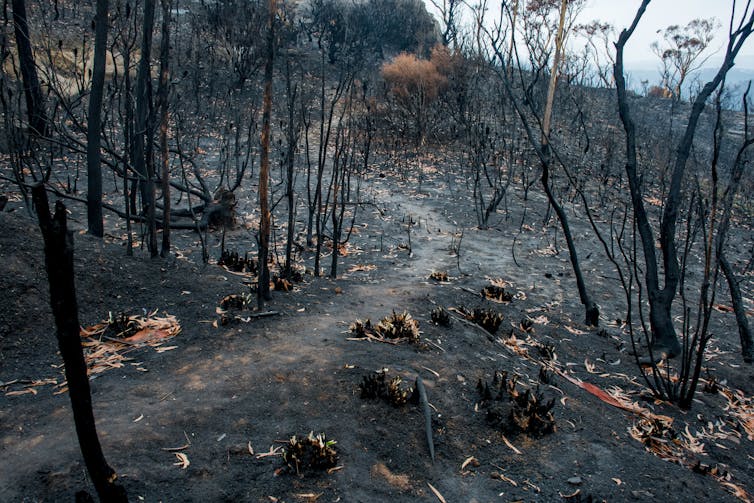
Climate change poses grave risks to many Australian homes, lives and livelihoods through, for example, worsening floods, heatwaves and bushfires.
Australia’s new climate change law legislates emissions reduction of 43% below 2005 levels by 2030, and reaching net-zero by 2050. It also requires climate policy benefits to be assessed each year.
But we don’t know exactly how the assessments will be conducted, and the law does not explicitly mention measuring the social cost of carbon.
Weighing Up The Social Cost Of Projects
Accounting for the social cost of carbon would lead to investment and policy decisions that support emissions reduction. It would also deter support for projects that increase emissions, such as new coal mines.
Decision-makers often use a cost-benefit analysis to assess and compare projects. If a project increases emissions, the social cost of carbon multiplied by the expected emissions should be added to the overall costs of the project.
Projects that decrease emissions, such as a new offshore wind farm, should have these benefits included in the assessment, bringing the overall net cost of the project down. Infrastructure Australia’s guide to economic appraisal mentions such an approach.
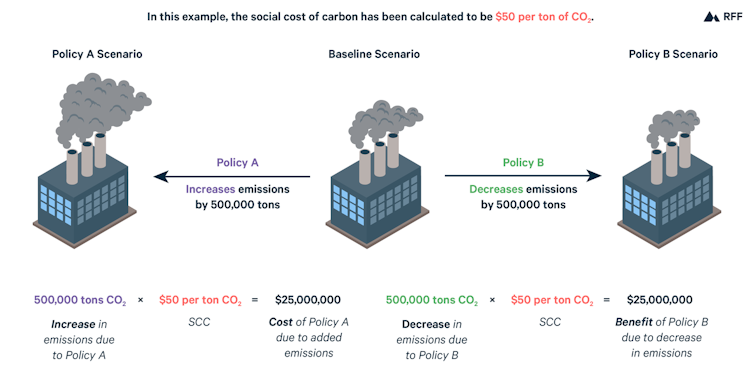
The United States and Canada already include the social cost of carbon in assessments of federal regulatory proposals and investments. Some 14 US states, including California and New York, also use the measure.
Last year, the Biden administration announced it would increase the social cost of carbon to A$76 per tonne of CO₂, which is much higher than the A$10 per tonne of CO₂ used by the Trump administration.
Also in 2021, the Australian Capital Territory became the first and only Australian jurisdiction to adopt the social cost of carbon. It was set at an interim A$20 per tonne of CO₂ and will be reviewed in future.
What We’re Calling For
A key component of calculating the social cost of carbon is a damage function that typically uses a single equation to estimate a global GDP loss.
However, as we argue in our letter, regional and sub-national damage functions would better capture the diverse range of climate change impacts, especially for human health and agriculture.
For example, losses in agricultural and labour productivity from heat stress differ by country. Economic losses range from less than 2% per year to over 28% per year in 2100, depending on the country and emissions scenario used.
Also, climate zones are a key determinate of the number of deaths associated with extremely hot and cold temperatures.
Our arguments are echoed by a US Interagency Working Group on the social cost of carbon. In 2017, it recommended separating market and non-market climate damages by region and sector.
Australia’s new annual climate change statement should also explicitly examine the health benefits of climate policies. These are likely to include fewer respiratory illnesses as a result of cleaner air, and increases in exercise associated with active travel options such as walking and cycling.
Understanding these health benefits will also improve decision-making and could change our approach to dealing with climate change.
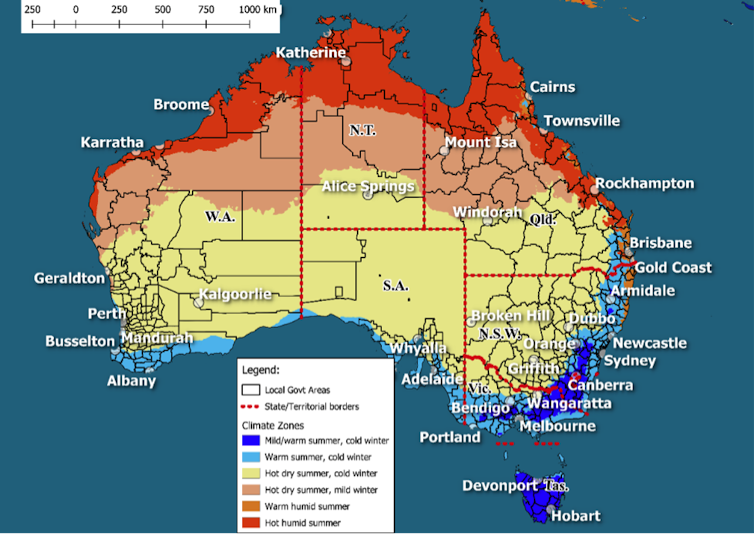
Better Climate Decision-Making
Climate change and related extreme events are already being felt in Australia. Back-to-back floods this year and the devastating Black Summer bushfires are just a few examples of our vulnerability to extreme weather events.
Governments must account for the impacts of these events when making decisions. Annual assessments of climate change policies are a decent start. Establishing a robust method to explicitly measure the social cost of carbon would go one better.![]()
Thomas Longden, Fellow, Crawford School of Public Policy, Australian National University; Richard Norman, Associate Professor in Health Economics, Curtin University; Sotiris Vardoulakis, Professor of Global Environmental Health, The Australian National University, and Tom Kompas, Professor of Environmental Economics and Biosecurity, The University of Melbourne
This article is republished from The Conversation under a Creative Commons license. Read the original article.
The Southern Ocean absorbs more heat than any other ocean on Earth, and the impacts will be felt for generations
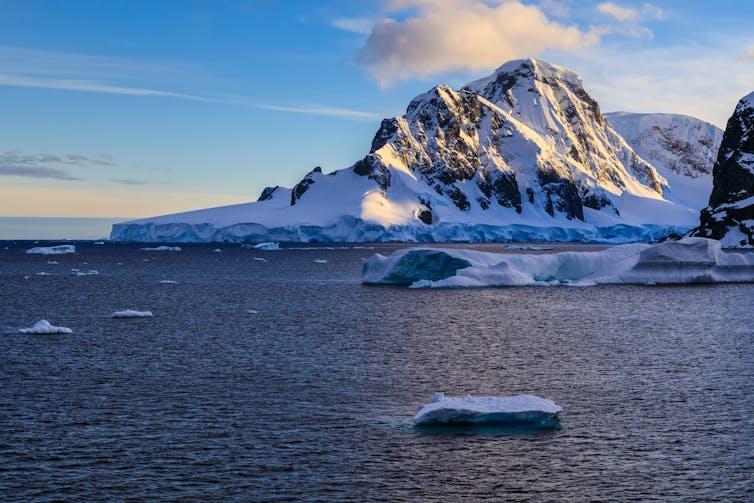
Over the last 50 years, the oceans have been working in overdrive to slow global warming, absorbing about 40% of our carbon dioxide emissions, and over 90% of the excess heat trapped in the atmosphere.
But as our research published today in Nature Communications has found, some oceans work harder than others.
We used a computational global ocean circulation model to examine exactly how ocean warming has played out over the last 50 years. And we found the Southern Ocean has dominated the global absorption of heat. In fact, Southern Ocean heat uptake accounts for almost all the planet’s ocean warming, thereby controlling the rate of climate change.
This Southern Ocean warming and its associated impacts are effectively irreversible on human time scales, because it takes millennia for heat trapped deep in the ocean to be released back into the atmosphere.
This means changes happening now will be felt for generations to come – and those changes are only set to get worse, unless we can stop carbon dioxide emissions and achieve net zero.
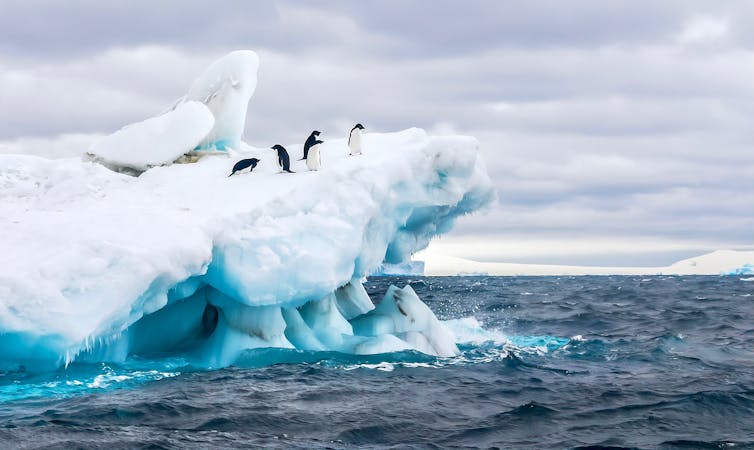
It’s Important Yet Difficult To Measure Ocean Heating
Ocean warming buffers the worst impacts of climate change, but it’s not without cost. Sea levels are rising because heat causes water to expand and ice to melt. Marine ecosystems are experiencing unprecedented heat stress, and the frequency and intensity of extreme weather events is changing.
Yet, we still don’t know enough about exactly when, where and how ocean warming occurs. This is because of three factors.
First, temperature changes at the ocean surface and in the atmosphere just above track each other closely. This makes it difficult to know exactly where excess heat is entering the ocean.
Second, we don’t have measurements tracking temperatures over all of the ocean. In particular, we have very sparse observations in the deep ocean, in remote locations around Antarctica and under sea ice.
Last, the observations we do have don’t go back very far in time. Reliable data from deeper than 700 metres depth is virtually non-existent prior to the 1990s, apart from observations along specific research cruise tracks.
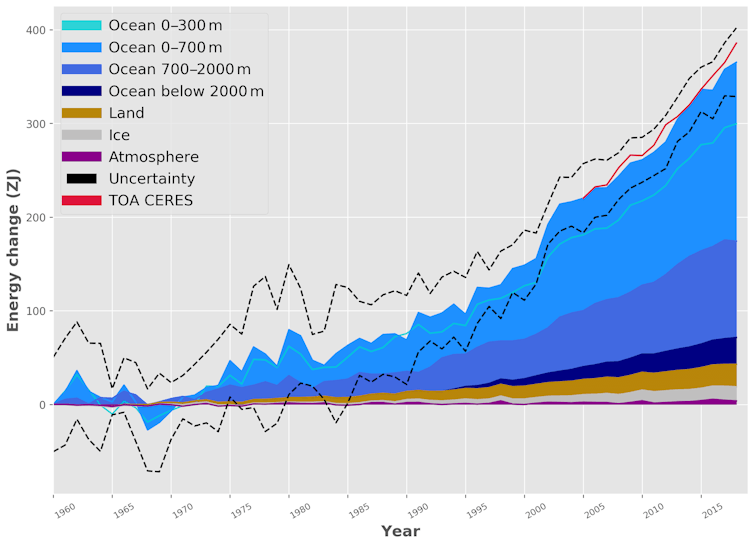
Our Modelling Approach
To work out the intricacies of how ocean warming has played out, we first ran an ocean model with atmospheric conditions perpetually stuck in the 1960s, prior to any significant human-caused climate change.
Then, we separately allowed each ocean basin to move forward in time and experience climate change, while all other basins were held back to experience the climate of the 1960s.
We also separated out the effects of atmospheric warming from surface wind-driven changes to see how much each factor contributes to the observed ocean warming.
By taking this modelling approach, we could isolate that the Southern Ocean is the most important absorber of this heat, despite only covering about 15% of the total ocean’s surface area.
In fact, the Southern Ocean alone could account for virtually all global ocean heat uptake, with the Pacific and Atlantic basins losing any heat gained back into the atmosphere.
One significant ecological impact of strong Southern Ocean warming is on Antarctic krill. When ocean warming occurs beyond temperatures they can tolerate, the krill’s habitat contracts and they move even further south to cooler waters.
As krill is a key component of the food web, this will also change the distribution and population of larger predators, such as commercially viable tooth and ice fish. It will also further increase stress for penguins and whales already under threat today.
So Why Is The Southern Ocean Absorbing So Much Heat?
This largely comes down to the geographic set-up of the region, with strong westerly winds surrounding Antarctica exerting their influence over an ocean that’s uninterrupted by land masses.
This means the Southern Ocean winds blow over a vast distance, continuously bringing masses of cold water to the surface. The cold water is pushed northward, readily absorbing vast quantities of heat from the warmer atmosphere, before the excess heat is pumped into the ocean’s interior around 45-55°S (a latitude band just south of Tasmania, New Zealand, and the southern regions of South America).
This warming uptake is facilitated by both the warmer atmosphere caused by our greenhouse gas emissions, as well as wind-driven circulation which is important for getting heat into the ocean interior.
And when we combine the warming and wind effects only over the Southern Ocean, with the remaining oceans held back to the climate of the 1960s, we can explain almost all of the global ocean heat uptake.
But that’s not to say the other ocean basins aren’t warming. They are, it’s just that the heat they gain locally from the atmosphere cannot account for this warming. Instead, the massive heat uptake in the Southern Ocean is what has driven changes in total ocean heat content worldwide over the past half century.
We Have Much To Learn
While this discovery sheds new light on the Southern Ocean as a key driver of global ocean warming, we still have a lot to learn, particularly about ocean warming beyond the 50 years we highlight in our study. All future projections, including even the most optimistic scenarios, predict an even warmer ocean in future.
And if the Southern Ocean continues to account for the vast majority of ocean heat uptake until 2100, we might see its heat content increase by as much as seven times more than what we have already seen up to today.
This will have enormous impacts around the globe: including further disturbances to the Southern Ocean food web, rapid melting of Antarctic ice shelves, and changes in the ocean conveyor belt.
To capture all of these changes, it’s vital we continue and expand our observations taken in the Southern Ocean.
One of the most important new data streams will be new ocean floats that can measure deeper ocean temperatures, as well as small temperature sensors on elephant seals, which give us essential data of oceanic conditions in winter under Antarctic sea ice.
Even more important is the recognition that the less carbon dioxide we emit, the less ocean change we will lock in. This will ultimately limit the disruption of livelihoods for the billions of people living near the coast worldwide.![]()
Maurice Huguenin, PhD Candidate, UNSW Sydney; Matthew England, Scientia Professor and Deputy Director of the ARC Australian Centre for Excellence in Antarctic Science (ACEAS), UNSW Sydney, and Ryan Holmes, Research fellow, University of Sydney
This article is republished from The Conversation under a Creative Commons license. Read the original article.
From microbes to forest bathing, here are 4 ways healing nature is vital to our recovery from COVID-19
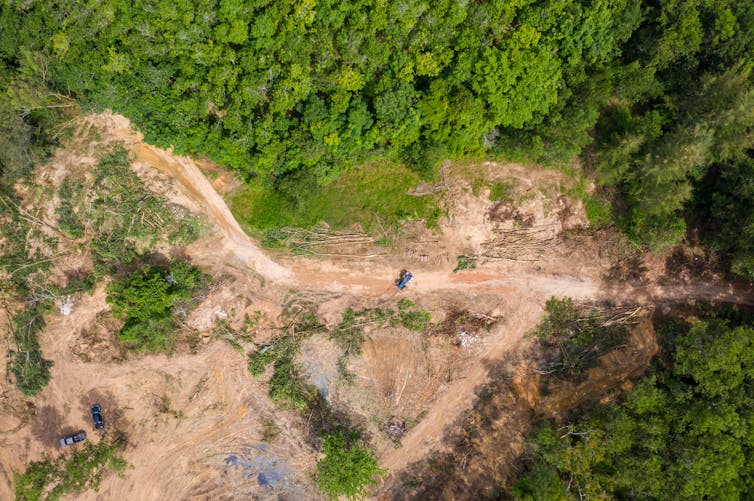
It’s been more than two years since the World Health Organization declared the COVID-19 pandemic. Each of us vividly recalls the first confirmed cases being reported in our home towns. COVID-19 spread across the planet at lightning speed, and the confirmed death toll is approaching 6.5 million. Communities and economies around the world have been devastated, and many societies need a recovery plan.
A growing number of scientists, including us in an article published today in The Lancet Planetary Health, argue protecting and restoring nature can help societies recover from the COVID-19 pandemic and even help prevent future pandemics. Thriving ecosystems are vital for humans and the rest of nature.
The ongoing destruction of nature is a recipe for disaster. Research points to direct links between the destruction of nature and infectious disease outbreaks such as COVID-19.
For instance, the removal of rainforests for agriculture and new towns increases our contact with wildlife that host novel viruses – the kind that “jump the species barrier”. Some cause major disease outbreaks like COVID-19.
In our Lancet Planetary Health paper, we use COVID-19 as a case study to demonstrate how restoring ecosystems can help to combat the health and social problems associated with pandemics.
We Are Running Out Of Time To Restore Ecosystems
Ecosystem restoration is the repair of natural systems – such as forests, grasslands and coral reefs – that have been damaged or destroyed. Unfortunately, human activities such as urbanisation, deforestation and pollution could leave 95% of the planet’s land severely damaged by 2050.
The UN has declared 2021 to 2030 the Decade on Ecosystem Restoration. The declaration reflects the growing urgency and scale of ecosystem restoration that we must undertake.
There are several ways in which protecting and restoring nature are vital to humanity’s recovery from COVID-19.
1. Enhancing The Immune System
The environment is brimful of microscopic life forms: dense clouds of bacteria, tiny fungi, algae and other life forms live in the soil, plants, water and air. Growing evidence suggests exposure to a diverse range of these invisible critters from an early age is vital to our health.
This exposure “primes” our immune systems and allows them to build strong armies of cells that protect us from pathogens. Indeed, having a healthy immune system is important in combating diseases such as COVID-19.
However, the diversity of these beneficial microbes is often much lower in degraded ecosystems than in more natural and diverse areas, such as forests with many different species of plants and animals. Therefore, restoring degraded ecosystems is important for both wildlife and our immune systems.
Furthermore, research suggests exposure to chemicals emitted by some plants – called phytoncides – can boost our immune system and help us fight off viral infections.
2. Letting Nature Be Thy Medicine
Spending time in natural environments is widely recognised as important for our health and wellbeing. After all, we are part of nature!
Evidence shows engaging with natural spaces such as forests, meadows and lakes can improve our mental health, reduce blood pressure and enhance our recovery from stress. In Japan, forest bathing – shinrin-yoku – is officially endorsed as a form of nature therapy.
In another of our studies, we showed spending time in nature helped people cope with the COVID-19 pandemic.
However, many people don’t have easy access to high-quality, biodiverse environments. Restoring these environments in urban areas is fundamental to people’s ability to cope with current and future pandemics. And some cities are doing just that; the Adelaide National Park City is a case in point.
3. Reducing The Risk Of Future Pandemics
Restoring wild places and reducing human-wildlife interactions could keep diseases at bay and minimise the risk of spillover events. These events occur when a pathogen in one species jumps to another, such as humans. This pathogen can then wreak havoc on human populations and lead to the next pandemic.
It’s important to prevent further encroachment by humans into these wild places for our own sake!
4. Improving Social Equity
The pandemic shone a spotlight on social inequity and its impacts on public health. Many people in deprived areas:
were more easily infected by the SARS-CoV-2 virus
suffered from more severe COVID-19 symptoms
had fewer opportunities to enhance their general wellbeing.
Our paper discusses the importance of ensuring equal access to biodiverse environments. Restoring ecosystems can improve people’s living environments and create “green job” opportunities in deprived areas. Actions such as tree planting, ecotherapy and environmental management are emerging areas of job growth.
However, we also have a warning: creating green spaces in urban areas can lead to deprived residents being displaced by more affluent ones. Effective safeguards against this gentrification are needed.
Ecosystem restoration should be viewed as a public health intervention. Urgent policy action is required at all levels, from local government to intergovernmental platforms, to transform social, economic and financial models to deliver a simultaneous healthy recovery of ecosystems and humanity.![]()
Jake M Robinson, Ecologist and Researcher, Flinders University; Christopher Daniels, Professor of Biology, University of South Australia, and Martin Breed, Senior Lecturer in Biology, Flinders University
This article is republished from The Conversation under a Creative Commons license. Read the original article.
Heat pumps can cut your energy costs by up to 90%. It’s not magic, just a smart use of the laws of physics

Heat pumps are becoming all the rage around a world that has to slash carbon emissions rapidly while cutting energy costs. In buildings, they replace space heating and water heating – and provide cooling as a bonus.
A heat pump extracts heat from outside, concentrates it (using an electric compressor) to raise the temperature, and pumps the heat to where it is needed. Indeed, millions of Australian homes already have heat pumps in the form of refrigerators and reverse-cycle air conditioners bought for cooling. They can heat as well, and save a lot of money compared with other forms of heating!
Even before the restrictions on Russian gas supply, many European countries were rolling out heat pumps – even in cold climates. Now, government policies are accelerating change. The United States, which has had very cheap gas in recent years, has joined the rush: President Joe Biden has declared heat pumps are “essential to the national defence” and ordered production be ramped up.
The ACT government is encouraging electrification of buildings using heat pumps, and is considering legislation to mandate this in new housing developments. The Victorian government recently launched a Gas Substitution Roadmap and is reframing its incentives programs towards heat pumps. Other states and territories are also reviewing policies.
Just How Big Are The Energy Cost Savings?
Relative to an electric fan heater or traditional electric hot water service, I calculate a heat pump can save 60-85% on energy costs, which is a similar range to ACT government estimates.
Comparisons with gas are tricky, as efficiencies and energy prices vary a lot. Typically, though, a heat pump costs around half as much for heating as gas. If, instead of exporting your excess rooftop solar output, you use it to run a heat pump, I calculate it will be up to 90% cheaper than gas.
Heat pumps are also good for the climate. My calculations show a typical heat pump using average Australian electricity from the grid will cut emissions by about a quarter relative to gas, and three-quarters relative to an electric fan or panel heater.
If a high-efficiency heat pump replaces inefficient gas heating or runs mainly on solar, reductions can be much bigger. The gap is widening as zero-emission renewable electricity replaces coal and gas generation, and heat pumps become even more efficient.

How Do Heat Pumps Work?
Heat pumps available today achieve 300-600% efficiency - that is, for each unit of electricity consumed, they produce three to six units of heat. Heat pumps can operate in freezing conditions too.
How is this possible, when the maximum efficiency of traditional electric and gas heaters is 100%, and cold air is cold?
It’s not magic. Think about your fridge, which is a small heat pump. Inside the fridge is a cold panel called an evaporator. It absorbs heat from the warm food and other sources, because heat flows naturally from a warmer object to a cooler object. The electric motor under the fridge drives a compressor that concentrates the heat to a higher temperature, which it dumps into your kitchen. The sides and back of a typical fridge get warm as this happens. So your fridge cools the food while heating the kitchen a bit.
A heat pump obeys the laws of thermodynamics, which allow it to operate at efficiencies from 200% to over 1,000% in theory. But the bigger the temperature difference, the less efficient the heat pump is.
If a heat pump needs to draw heat from the environment, how can it work in cold weather? Remember your fridge keeps the freezer compartment cold while pumping heat into your kitchen. The laws of physics are at play. What we experience as a cold temperature is actually quite hot: it’s all relative.
Outer space is close to a temperature known as absolute zero, zero degrees Kelvin, or –273℃. So a temperature of 0℃ (at which water freezes), or even the recommended freezer temperature of -18℃, is actually quite hot relative to outer space.
The main problem for a heat pump in “cold” weather is that ice can form on its heat exchanger, as water vapour in the air cools and condenses, then freezes. This ice blocks the air flow that normally provides the “hot” air to the heat pump. Heat pumps can be designed to minimise this problem.
How Do You Choose The Right Heat Pump For Your Home?
Selecting a suitable heat pump (more commonly known as a reverse-cycle air conditioner) can be tricky, as most advisers are used to discussing gas options. Resources such as yourhome.gov.au, choice.com.au and the popular Facebook page My Efficient Electric Home can help.
All household units must carry energy labels (see energyrating.gov.au): the more stars the better. The independent FairAir web calculator allows you to estimate heating and cooling requirements of a home and the size needed to maintain comfort.
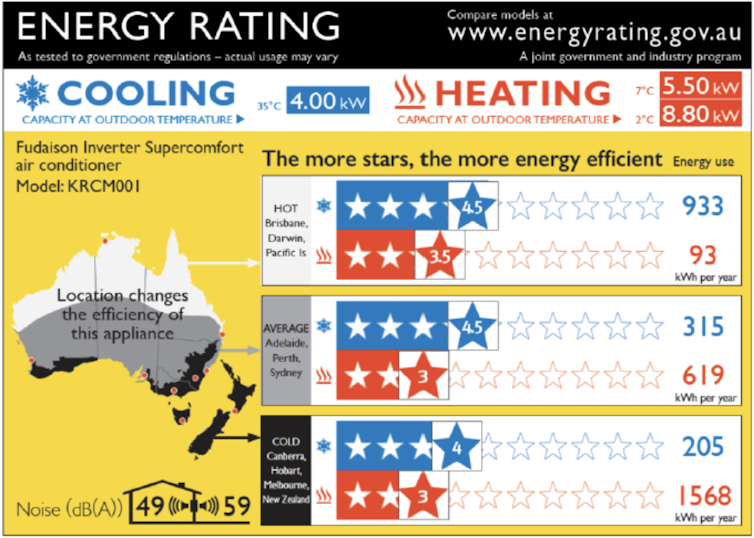
Bigger heat pumps are more expensive, so unnecessary oversizing can cost a lot more. Also, insulating, sealing drafts and other building efficiency measures allow you to buy a smaller, cheaper heat pump that will use even less energy and provide better comfort.
When using a heat pump, it is very important to clean its filter every few months. A blocked filter reduces efficiency and the heating and cooling output. If you have an older heat pump that no longer delivers as much heat (or cooling), it may have lost some refrigerant and need a top-up.![]()
Alan Pears, Senior Industry Fellow, RMIT University
This article is republished from The Conversation under a Creative Commons license. Read the original article.
With better standards, we could make plastics endlessly useful – and slash waste. Here’s how

If you flip over a plastic food container, you’ll see tiny writing on it – something like “AS 2070”. This means the product meets the Australian standard for plastics safe to use for food.
These often unrecognised standards are a part of daily life. Australia has a set of exacting standards which set quality benchmarks for many products. They act as guidelines for design and manufacture of plastic items, shaping the specific polymers used, the ability to use recycled content, and compostability.
There’s a real opportunity to do more here. The issues of plastic waste in our seas and the effects on wildlife are catalysing major public concern. Part of the problem of plastic waste is the difficulty of reusing many types of plastics as the feedstock for new products. We also need stronger incentives to reduce plastic in manufacturing and design.
That’s where standards can come in. The European Union has used standards and legislation to nudge the plastics industry towards a true circular economy. This means minimising the use of plastic where possible, while ensuring old plastics can be turned into new products rather than turning into waste which could end up in our seas. We can do the same, harnessing standards to reduce plastic waste. How? By requiring companies to minimise plastic packaging and setting guidelines for products to be made of specific polymers while avoiding others.
Our new research found a total of 95 standards. Nine of these are Australian. This means there is a great opportunity for Australian experts to get involved in the national and international standards development process.
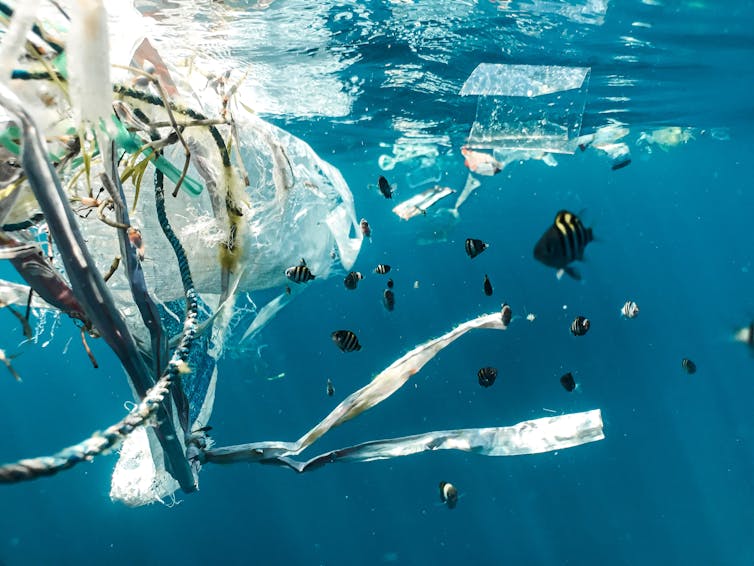
Why Do Standards Matter?
Think of standards as guidelines and codes of practice. Standards give product manufacturers a framework for the minimum quality and safety required to be able to sell them in Australia. They also help to provide a common language and enhance compatibility and efficiency across markets.
Globally, standards affect an estimated 80% of the world trade. They have real impact. If a product cannot meet the applicable standard in the country or jurisdiction it is intended for, it won’t be accepted.
Plastic recyclers can use standards to ensure their products meet specific requirements, and so provide quality assurance for manufacturers who buy the recycled plastics to make other products.
Standards for plastic reuse can ensure certain products can be used over and over. Labelling standards can also help us as consumers know which items we can and can’t recycle.
Both industry and government may choose to introduce standards. Standards can also increase consumer confidence, promote social acceptance of recycled products and maintain or increase the value of recycled plastics – a vital step towards a circular economy.
By bringing in new standards for other stages of the plastics supply chain, we could leverage this powerful tool and help standardise parts of the emerging international circular economy in plastics.
Standards could help us reduce waste at all stages of a product’s lifecycle, from design to manufacture to recycling to reuse.

What Did We Find?
We worked with Standards Australia to map existing plastics standards around the world. We also went looking for missing links which, if filled, could help to better manage plastic waste.
The majority of existing plastic standards – both Australian and international – are focused on recycling and recovery or waste disposal parts of plastic’s lifecycle.
To create a true circular economy for plastics, we’ll need to update existing standards and develop more which specifically focus on the early stages of plastic production, such as design or creation of the basic building blocks of plastics.
Think of nurdles, the pea-sized plastic beads produced in their trillions as a key first step to making many plastics. When nurdles spill into the sea, they’re very bad news for wildlife. If we create standards focused on these steps, we can help reduce their impact.
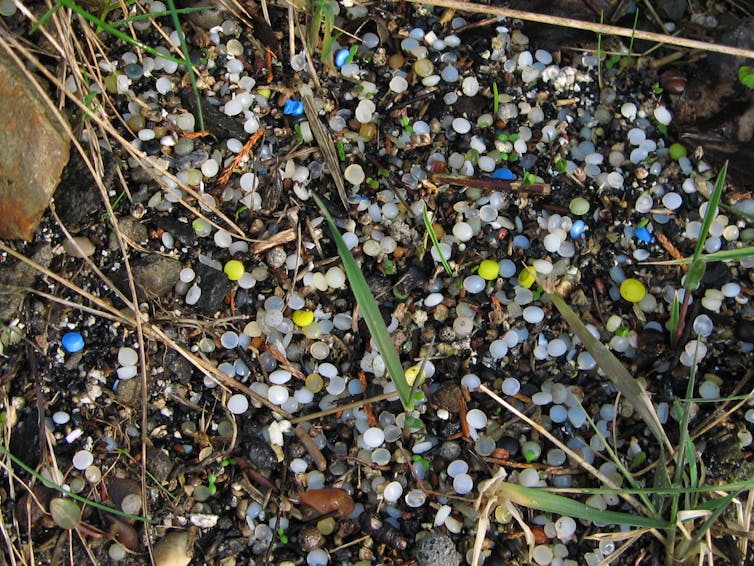
Adding more standards could also help us tackle the challenges around making products reusable and recyclable, as well as cutting how much packaging is needed for products.
We can also use them to help assess biodegradable products, to ensure they don’t make existing waste or recycling streams harder to process.
And importantly, standardising the labelling of products could help us as consumers. Imagine if labels on plastic products included the amount of recycled plastics, as well as a rating of how recyclable or compostable the product was.
This would give manufacturers incentives to make simpler products better able to be recycled. It would also avoid specific problems such as multi-layer plastics which are not cost effective to recycle.
In short, plastic standards are an often overlooked way for us to improve how we use and reuse these extraordinarily versatile modern materials.
Plastics don’t have to become environmentally destructive waste. They can be almost endlessly useful – if we require it. ![]()
Qamar Schuyler, Research Scientist, Oceans and Atmospheres, CSIRO
This article is republished from The Conversation under a Creative Commons license. Read the original article.
Poorly ventilated buildings are allowed under Australia rules – it’s time to fix it

If COVID-19 had taught us anything it surely must be that poorly ventilated buildings can be a health hazard. Yet due to a weakness in current rules they continue to be built.
Under Australia’s National Construction Code it is possible to build a nightclub for 1,000 people with no ventilation. And it is possible to build a school for 600 people with no ventilation, or an aged care centre for 300 people with no ventilation.
This is because the construction code requires windows that can be opened for natural ventilation, but nothing requires them to be opened in service.
And where the code requires mechanical ventilation (fans or air conditioning) it is possible to build a hospital where the air that is supplied to patient rooms travels back to the air conditioning unit via corridors. A recent design in Footscray is typical.
This means visitors, patients and health care workers have to travel through airborne effluent from unwell people to reach them.
Rules For Water, Few For Air
The code has rules for ensuring the purity of water delivered through plumbing, but no rules for ensuring the purity of air, or requirement to deliver a minimum standard of ventilation in buildings accessed by the public.
The code’s revised Indoor Air Quality Handbook is now out for consultation.
The handbook is a guide for practice that is meant to go beyond the bare bones of the code.
The handbook revisions do not include provisions that would ensure indoor air is free from particulates, carcinogenic gases such as nitrogen oxide and benzine, pathogens such as bacteria, mould and fungal spores, or viruses – such as COVID-19.
The code says buildings can be “deemed to satisfy” air quality requirements if they provide one of two things:
“natural ventilation” using openable windows measuring 5% of the floor area
“mechanical ventilation” complying with Australian Standard 1668.2.
But no law or regulation prevents the construction of a naturally ventilated building that is operated with its windows shut.
In a home, opening and shutting windows is within the control of the occupant.
But in a publicly accessible building, occupants normally are unable to control windows, and in winter or summer they are often shut to control the temperature.
Airborne Particles Kill Millions
Worldwide, pre-COVID, acute respiratory illnesses such as colds and influenza caused an estimated 18 billion upper airway infections and 340 million lower respiratory infections every year, resulting in more than 2.7 million deaths and economic losses in the billions.
More broadly, tiny particles with widths as small as small as 2.5 microns (PM 2.5) were responsible for more than four million deaths each year.
One single airborne viral disease, COVID-19, has now claimed between 17 million and 25 million lives worldwide. Most transmission occurred indoors.
Good ventilation and high-efficiency particulate air (HEPA) filtration could have prevented much of it.
This ought to be fixed at the top, with national indoor air quality standards that progressively apply to all buildings accessed by the public.
No Parts-Per-Million Standard
Ideally, the standards would include upper limits for all contaminants, down to and including a width of 2.5 microns.
These contaminants include bacteria, viruses, pollen and spores as well as particulates from bushfire smoke, vehicles and combustion processes.
Ventilation should also be sufficient to ensure gaseous contaminants generated by building contents and indoor activities stay at safe levels.
Relatively inexpensive and reasonably accurate handheld devices are now available to measure contaminants and could be used to monitor compliance.

Schools ought to be the first priority.
Many schools operated by state and Catholic education systems suffer from a massive shortfall in capital spending, contrasting with Rolls-Royce provisions at many high-fee private schools.
Nearly all state and low-fee schools operate in buildings in which heating, ventilation and air conditioning is an overlay on a natural ventilation.
Usually, these systems just recirculate air or worse, in the case of unflued gas heaters, pollute it. Teachers ought not to be placed in the position of having to choose between thermal comfort and good ventilation.
This should not mean windows are set so they are always open. It should mean the building is safe even if the windows are shut.
This will cost money, but the benefits to children are likely to outweigh the costs.
The revision of the Indoor Air Quality Handbook is an opportunity for the Building Codes Board to start reforming the code so it takes health into proper account, rather than continuing to kick the can down the road.![]()
Geoff Hanmer, Adjunct professor of architecture, University of Adelaide
This article is republished from The Conversation under a Creative Commons license. Read the original article.
Migration boost is bad news for Australia’s environment – we mustn’t ignore that

An increase in the permanent migrant intake to 195,000 this year is one of the jobs summit outcomes announced by the federal government on Friday. The business community pushed for this change, saying shortages of skilled employees are holding back the economy.
The downsides of increasing migration, which will almost certainly worsen our environmental problems, weren’t mentioned. We can expect public debate about lifting migration to pre-pandemic levels. It’s essential for this debate to consider the whole picture: the economic, social and environmental issues.
Migration has environmental impacts because it increases our population, with proportional increases in resource use and waste products. Our population has grown by 50% since 1990, from 17 million to almost 26 million today. Our energy use has risen from 4,000 petajoules a year to 6,200, increasing our greenhouse gas emissions by around 50%.
The demands of the human population are causing, directly or indirectly, all of Australia’s serious environmental problems.
Pressures On The Environment Are Growing
Since 1996, there have seen six independent State of the Environment reports to the Australian government. I chaired the advisory council that produced the first.
This 1996 report found much of Australia’s environment was in good condition by international standards. But we also had serious problems: loss of biodiversity, the state of inland rivers, degradation of productive land, pressures on the coastal zone, and increasing greenhouse gas emissions.
The five reports since then have documented the worsening of those problems. The most recent report said our environment is in poor condition and deteriorating. It found “many species and ecosystems are increasingly threatened” and noted “abrupt changes in ecological systems” in recent years.
As the 1996 report said, no single government or commercial sector is to blame for our environmental problems. In a sense, we are all indirectly responsible. The issues are the cumulative consequences of the growth and distribution of our population, our lifestyle choices, the technologies we use and the demands we make on our natural resources.
The latest report observes:
“Humans drive many of the pressures on our environment. Our activities, settlements and use of resources all affect the environment and its assets in different ways.”
The report notes the particular pressures of population growth on the coastal zone, where most Australians live. Australian cities are growing faster than those in most other affluent countries, it says.
That growth has increased demand for resources such as water and energy as well as increasing impacts such as “urban heat, congestion, pollution and waste”. The demands of a growing population have led to land clearing, reduced green space, more pollution and the loss of biodiversity.
Today’s Decisions Shape Tomorrow’s Australia
The decisions being made now have a substantial effect on what Australia will look like in the future. As a report I wrote with Jane O'Sullivan and Peter Cook in February this year said, with net migration below 60,000 a year the population would stabilise around 30-35 million by 2050. The newly announced 195,000 a year could lift it to about 40 million.
It is sometimes claimed migration simply shifts environmental impacts from one country to another and so does no extra damage to the planet. This would be true if migrants all came from countries with the same resource demands as us. But most economic migrants come to Australia precisely because our material standard of living is higher and they want to enjoy those benefits.
Pre-pandemic figures from 2016-17, for example, showed about 170,000 migrants coming from countries with much lower resource use. About 50,000 came from affluent countries in which resource use is typically about half that in Australia. Only about 5,000 were from places where material demand is similar to ours.
No doubt we could do many things to reduce the impacts of our growing population. We could, for instance, improve urban planning. We could also shift more rapidly to cleaner energy systems that embrace efficiency improvements recommended nearly 20 years ago to the Howard government. And we could adopt legally enforceable national environmental standards, as recommended by the 2020 Samuel review, which found our environmental laws are ineffective.
The fundamental need, though, is to upgrade our decision-making so environmental issues are always part of the calculus. Current thinking seems to presume the economy has over-riding importance and the environment just has to cope with the impacts.
Even The Economic Benefits Are Debated
Even the view that increasing migration produces economic benefits is not universal among economists. A 2016 Lowy Institute report, citing published research and a Productivity Commission report, claimed “a sustained high rate of net immigration […] appears to be necessary to stave off long-term population decline and is likely to result in higher GDP per capita and labour productivity”.
On the other hand, a 2014 OECD review referred to a study of impacts of migration to OECD countries. It concluded “the impact of the cumulative waves of migration that arrived over the past 50 years […] is on average close to zero”. It was positive in some cases, negative in others, “rarely exceeding 0.5 per cent of GDP”.
Even those who believe increasing migration has economic benefits, such as the Lowy Institute report authors, concede that “accompanying policies are necessary to ensure that these net benefits are distributed fairly and that the social and environmental effects of increased population are managed properly”.
Increasing public hostility to high levels of migration is a direct consequence of failure to manage the social impacts. Urban infrastructure has not kept pace with increasing demands. As a result, the three in four Australians who live in our major cities see their quality of life getting worse.
We Can’t Ignore The Big Picture
Unless we reduce our demands per person, our growing population inevitably increases pressures on our environment. We need to look beyond simplistic economic assumptions and consider the whole picture.
As the latest State of the Environment report concludes:
“Our health, living standards, cultural and spiritual fulfilment and connection to country are all interconnected and are negatively impacted by our deteriorating environment.”
Note: A quote by John Quiggin has been removed from the original version of this article because it didn’t accurately represent his views.![]()
Ian Lowe, Emeritus Professor, School of Science, Griffith University
This article is republished from The Conversation under a Creative Commons license. Read the original article.
Microplastics are common in homes across 29 countries. New research shows who’s most at risk

The evidence is clear: microplastics have contaminated every corner of the globe. We can’t escape exposure to these tiny bits of plastic (less than 5mm across) in the environment, which includes the homes where people spend most of their time.
Recent research has discovered microplastics in the blood of humans. However, the question of harm to humans remains unresolved. Despite concerns that some substances in microplastics could cause cancer or damage our DNA, we still have a poor grasp of the true risks of harm.
Our study of global microplastics exposure inside homes across 29 countries, published today, shows people living in lower-income countries and young children are at greater risk of exposure. But our analysis of the chemical composition of microplastics in the home shows the specific health risk is surprisingly low. The study covered all the continents, including Australia.
The current challenge in understanding health risks from microplastics is the very limited data on toxic effects of the petrochemicals used in plastics production.
A recurrent theme in the environmental health research literature is that early concerns about suspect chemicals and related compounds, including those found in plastics, were eventually justified. The effects of suspect substances only become clear after extensive toxicological and epidemiological research.
What Did The New Study Look At?
Our study investigated three main questions relating to exposure to microplastics inside homes:
what are the impacts in different countries across the world?
who is most at risk?
what are the specific health risks?
We reached out to residents across 29 countries to collect their indoor atmospheric dust over a one-month period. At 108 homes sampled across these countries, we also collected information about households and behaviours. This helped us to better understand possible sources and causes of microplastics in dust. These data included:
how often floors were cleaned
flooring type
presence or absence of children
number of people living in each home
percentage of full-time workers.
In each home, atmospheric dust particles were collected in specially cleaned and prepared glass Petri dishes. We measured the levels of microplastics in the collected dust using a suite of microscopic techniques and instruments. We used infrared spectroscopy – which identifies substances by how they interact with light – to determine the chemical composition of these microplastics.
What Did The Study Find?
The household dust contained a wide variety of synthetic polymer fibres. The most common were:
polyester (as polyethylene terephthalate) at 9.1%, which is used in clothing fabrics
polyamide (7.7%), which is mainly used in textiles
polyvinyls (5.8%), which are used in floor varnishes
polyurethane (4.4%), which is used in surface coatings of furniture and in bedding
polyethylene (3.6%), a common polymer used in food containers and reusable bags.
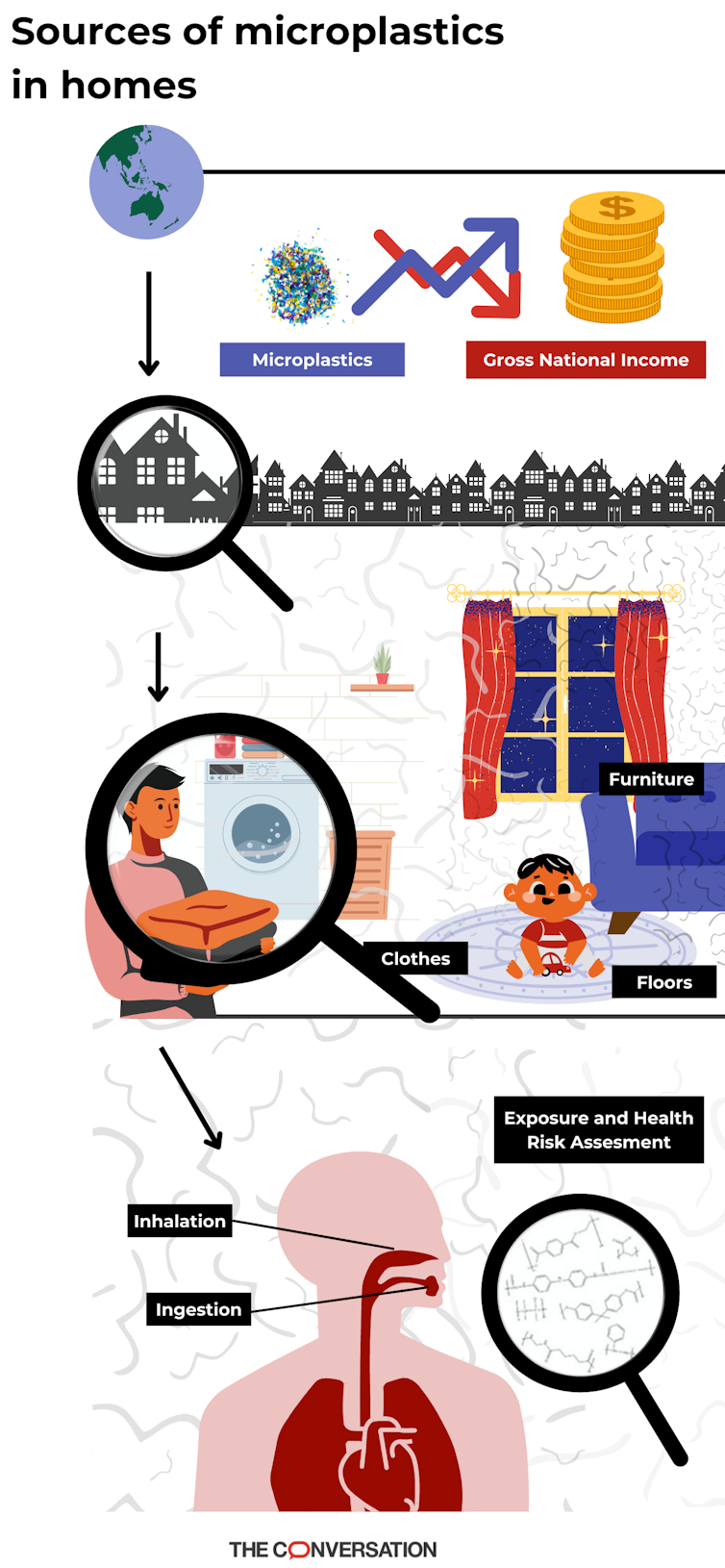
We examined the prevalence and risk of microplastics according to the gross national income of each country, grouped as low, medium and high-income (such as Australia). Overall, we found lower-income countries have higher loads of microplastics, which were deposited at an average daily rate of 3,518 fibres per square metre. The rates for medium-income and high-income countries were 1,268 and 1,257 fibres/m²/day.
In low-income countries, the most prevalent synthetic polymer fibres were made of polyurethane (11.1% of all fibres in samples). In high-income countries, polyamide and polyester were the most prevalent microplastic types (11.2% and 9.8% respectively).
So What Are The Health Risks?
For the first time we could attribute the health risk across countries according to incomes. Our analyses showed lower-income countries are at higher risk from microplastic pollution. This aligns with research findings on other toxic exposures – poorer countries and people are most at risk from pollution.
Nevertheless, we found the overall risk from microplastics exposure was low. We used the US Environmental Protection Agency’s toxicity information on polymers in the microplastics to calculate health risk based on the types and levels we detected.
Low-income countries had a higher lifetime risk of cancers due to indoor microplastic exposure at 4.7 people per million. High-income countries were next at 1.9 per million, with medium-income countries at 1.2 per million.
We attributed these differences in cancer risk to the different percentages of carcinogenic substances in the microplastics found in household dust.
We calculated the sum of the carcinogenic risk from inhalation and ingestion of the following chemicals in the microplastic fibres: vinyl chloride (polyvinyl chloride), acrylonitrile (polyacrylics) and propylene oxide (polyurethane). Because toxicity data for polymers are limited, the assessment was a minimum estimate of true risk.
Children are at greater risk irrespective of income, which is true for many types of environmental exposures. This is because of their smaller size and weight, and tendency to have more contact with the floor and to put their hands in their mouths more often than adults.
Our analysis indicated that the microplastics came mainly from sources inside the home, and not from outside. Synthetic polymer-based materials are used widely in high-income countries in products such as carpets, furniture, clothing and food containers. We anticipated levels of microplastic shedding in the home might be greater in these countries.
However, analysis of the data showed the only factor obviously linked with levels of microplastics in deposited dust was how often they were vacuumed. Frequent vacuuming reduces microplastic levels.
Vacuuming was more frequent in higher-income countries. Factors that influence the type of cleaning include people’s preference for sweeping and mopping versus vacuuming, as well as their access to and capacity to afford electronic vacuum cleaners.

What Can We Do To Reduce The Risks?
Based on this and our previous study data, it is clear vacuuming regularly, instead of sweeping, is associated with less airborne microplastics indoors. Other obvious actions – such as choosing natural fibres for clothing, carpets and furnishings instead of petrochemical-based polymer fibres – can reduce the shedding of microplastics indoors.
Future research needs to focus on developing more complete profiles of the harmful effects of each of the toxic petrochemical-based synthetic polymers that can produce microplastics. This will give us a better understanding of the risks of exposure to these ubiquitous pollutants.![]()
Mark Patrick Taylor, Chief Environmental Scientist, EPA Victoria; Honorary Professor, School of Natural Sciences, Macquarie University; Neda Sharifi Soltani, Academic Casual, School of Natural Sciences, Macquarie University, and Scott P. Wilson, Chief Scientist, Earthwatch Australia, Honorary Senior Research Fellow, School of Natural Sciences, Macquarie University
This article is republished from The Conversation under a Creative Commons license. Read the original article.
Pittwater Reserves: Histories + Notes + Pictorial Walks
A History Of The Campaign For Preservation Of The Warriewood Escarpment by David Palmer OAM and Angus Gordon OAM
America Bay Track Walk - photos by Joe Mills
An Aquatic June: North Narrabeen - Turimetta - Collaroy photos by Joe Mills
Angophora Reserve Angophora Reserve Flowers Grand Old Tree Of Angophora Reserve Falls Back To The Earth - History page
Annie Wyatt Reserve - A Pictorial
Avalon's Village Green: Avalon Park Becomes Dunbar Park - Some History + Toongari Reserve and Catalpa Reserve
Bairne Walking Track Ku-Ring-Gai Chase NP by Kevin Murray
Bangalley Headland Bangalley Mid Winter
Banksias of Pittwater
Barrenjoey Boathouse In Governor Phillip Park Part Of Our Community For 75 Years: Photos From The Collection Of Russell Walton, Son Of Victor Walton
Barrenjoey Headland: Spring flowers
Barrenjoey Headland after fire
Bayview Baths
Bayview Wetlands
Beeby Park
Bilgola Beach
Botham Beach by Barbara Davies
Bungan Beach Bush Care
Careel Bay Saltmarsh plants
Careel Bay Birds
Careel Bay Clean Up day
Careel Bay Playing Fields History and Current
Careel Creek
Careel Creek - If you rebuild it they will come
Centre trail in Ku-ring-gai Chase National Park
Chiltern Track- Ingleside by Marita Macrae
Clareville Beach
Clareville/Long Beach Reserve + some History
Coastal Stability Series: Cabbage Tree Bay To Barrenjoey To Observation Point by John Illingsworth, Pittwater Pathways, and Dr. Peter Mitchell OAM
Cowan Track by Kevin Murray
Curl Curl To Freshwater Walk: October 2021 by Kevin Murray and Joe Mills
Currawong and Palm Beach Views - Winter 2018
Currawong-Mackerel-The Basin A Stroll In Early November 2021 - photos by Selena Griffith
Currawong State Park Currawong Beach + Currawong Creek
Deep Creek To Warriewood Walk photos by Joe Mills
Drone Gives A New View On Coastal Stability; Bungan: Bungan Headland To Newport Beach + Bilgola: North Newport Beach To Avalon + Bangalley: Avalon Headland To Palm Beach
Duck Holes: McCarrs Creek by Joe Mills
Dunbar Park - Some History + Toongari Reserve and Catalpa Reserve
Dundundra Falls Reserve: August 2020 photos by Selena Griffith - Listed in 1935
Elsie Track, Scotland Island
Elvina Track in Late Winter 2019 by Penny Gleen
Elvina Bay Walking Track: Spring 2020 photos by Joe Mills
Elvina Bay-Lovett Bay Loop Spring 2020 by Kevin Murray and Joe Mills
Fern Creek - Ingleside Escarpment To Warriewood Walk + Some History photos by Joe Mills
Iluka Park, Woorak Park, Pittwater Park, Sand Point Reserve, Snapperman Beach Reserve - Palm Beach: Some History
Ingleside
Ingleside Wildflowers August 2013
Irrawong - Ingleside Escarpment Trail Walk Spring 2020 photos by Joe Mills
Irrawong - Mullet Creek Restoration
Katandra Bushland Sanctuary - Ingleside
Lucinda Park, Palm Beach: Some History + 2022 Pictures
McCarrs Creek
McCarr's Creek to Church Point to Bayview Waterfront Path
McKay Reserve
Mona Vale Beach - A Stroll Along, Spring 2021 by Kevin Murray
Mona Vale Headland, Basin and Beach Restoration
Mount Murray Anderson Walking Track by Kevin Murray and Joe Mills
Mullet Creek
Narrabeen Creek
Narrabeen Lagoon Catchment: Past Notes Present Photos by Margaret Woods
Narrabeen Lagoon State Park
Narrabeen Lagoon State Park Expansion
Narrabeen Rockshelf Aquatic Reserve
Nerang Track, Terrey Hills by Bea Pierce
Newport Bushlink - the Crown of the Hill Linked Reserves
Newport Community Garden - Woolcott Reserve
Newport to Bilgola Bushlink 'From The Crown To The Sea' Paths: Founded In 1956 - A Tip and Quarry Becomes Green Space For People and Wildlife
Pittwater spring: waterbirds return to Wetlands
Pittwater's Lone Rangers - 120 Years of Ku-Ring-Gai Chase and the Men of Flowers Inspired by Eccleston Du Faur
Pittwater's Parallel Estuary - The Cowan 'Creek
Resolute Track at West Head by Kevin Murray
Resolute Track Stroll by Joe Mills
Riddle Reserve, Bayview
Salvation Loop Trail, Ku-Ring-Gai Chase National Park- Spring 2020 - by Selena Griffith
Seagull Pair At Turimetta Beach: Spring Is In The Air!
Stapleton Reserve
Stapleton Park Reserve In Spring 2020: An Urban Ark Of Plants Found Nowhere Else
Stony Range Regional Botanical Garden: Some History On How A Reserve Became An Australian Plant Park
The Chiltern Track
The Resolute Beach Loop Track At West Head In Ku-Ring-Gai Chase National Park by Kevin Murray
Topham Track Ku-Ring-Gai Chase NP, August 2022 by Joe Mills and Kevin Murray
Towlers Bay Walking Track by Joe Mills
Trafalgar Square, Newport: A 'Commons' Park Dedicated By Private Landholders - The Green Heart Of This Community
Tranquil Turimetta Beach, April 2022 by Joe Mills
Turimetta Beach Reserve by Joe Mills, Bea Pierce and Lesley
Turimetta Beach Reserve: Old & New Images (by Kevin Murray) + Some History
Turimetta Headland
Warriewood Wetlands and Irrawong Reserve
Whale Beach Ocean Reserve: 'The Strand' - Some History On Another Great Protected Pittwater Reserve
Wilshire Park Palm Beach: Some History + Photos From May 2022
Winji Jimmi - Water Maze

New Shorebirds WingThing For Youngsters Available To Download
A Shorebirds WingThing educational brochure for kids (A5) helps children learn about shorebirds, their life and journey. The 2021 revised brochure version was published in February 2021 and is available now. You can download a file copy here.
If you would like a free print copy of this brochure, please send a self-addressed envelope with A$1.10 postage (or larger if you would like it unfolded) affixed to: BirdLife Australia, Shorebird WingThing Request, 2-05Shorebird WingThing/60 Leicester St, Carlton VIC 3053.

 Shorebird Identification Booklet
Shorebird Identification Booklet
The Migratory Shorebird Program has just released the third edition of its hugely popular Shorebird Identification Booklet. The team has thoroughly revised and updated this pocket-sized companion for all shorebird counters and interested birders, with lots of useful information on our most common shorebirds, key identification features, sighting distribution maps and short articles on some of BirdLife’s shorebird activities.
The booklet can be downloaded here in PDF file format: http://www.birdlife.org.au/documents/Shorebird_ID_Booklet_V3.pdf
Paper copies can be ordered as well, see http://www.birdlife.org.au/projects/shorebirds-2020/counter-resources for details.
Download BirdLife Australia's children’s education kit to help them learn more about our wading birdlife
Shorebirds are a group of wading birds that can be found feeding on swamps, tidal mudflats, estuaries, beaches and open country. For many people, shorebirds are just those brown birds feeding a long way out on the mud but they are actually a remarkably diverse collection of birds including stilts, sandpipers, snipe, curlews, godwits, plovers and oystercatchers. Each species is superbly adapted to suit its preferred habitat. The Red-necked Stint is as small as a sparrow, with relatively short legs and bill that it pecks food from the surface of the mud with, whereas the Eastern Curlew is over two feet long with a exceptionally long legs and a massively curved beak that it thrusts deep down into the mud to pull out crabs, worms and other creatures hidden below the surface.
Some shorebirds are fairly drab in plumage, especially when they are visiting Australia in their non-breeding season, but when they migrate to their Arctic nesting grounds, they develop a vibrant flush of bright colours to attract a mate. We have 37 types of shorebirds that annually migrate to Australia on some of the most lengthy and arduous journeys in the animal kingdom, but there are also 18 shorebirds that call Australia home all year round.
What all our shorebirds have in common—be they large or small, seasoned traveller or homebody, brightly coloured or in muted tones—is that each species needs adequate safe areas where they can successfully feed and breed.
The National Shorebird Monitoring Program is managed and supported by BirdLife Australia.
This project is supported by Glenelg Hopkins Catchment Management Authority and Hunter Local Land Services through funding from the Australian Government’s National Landcare Program. Funding from Helen Macpherson Smith Trust and Port Phillip Bay Fund is acknowledged.
The National Shorebird Monitoring Program is made possible with the help of over 1,600 volunteers working in coastal and inland habitats all over Australia.
The National Shorebird Monitoring program (started as the Shorebirds 2020 project initiated to re-invigorate monitoring around Australia) is raising awareness of how incredible shorebirds are, and actively engaging the community to participate in gathering information needed to conserve shorebirds.
In the short term, the destruction of tidal ecosystems will need to be stopped, and our program is designed to strengthen the case for protecting these important habitats.
In the long term, there will be a need to mitigate against the likely effects of climate change on a species that travels across the entire range of latitudes where impacts are likely.
The identification and protection of critical areas for shorebirds will need to continue in order to guard against the potential threats associated with habitats in close proximity to nearly half the human population.
Here in Australia, the place where these birds grow up and spend most of their lives, continued monitoring is necessary to inform the best management practice to maintain shorebird populations.
BirdLife Australia believe that we can help secure a brighter future for these remarkable birds by educating stakeholders, gathering information on how and why shorebird populations are changing, and working to grow the community of people who care about shorebirds.
To find out more visit: http://www.birdlife.org.au/projects/shorebirds-2020/shorebirds-2020-program
Aussie Bread Tags Collection Points

A window to the brain: the retina gives away signs of Alzheimer’s disease and could help with early detection

The retina has long been poeticised as the window to the soul, but research now shows it could be a window to the brain and act as an early warning system for cognitive decline.
A growing body of research suggests the retina is thinner in people with Alzheimer’s disease, reflecting the cell loss that is a hallmark of the neurodegenerative disease.
We investigated a group of middle-aged people who are part of the Dunedin Study, a comprehensive longitudinal project that has continued for five decades. We found people with thinner retinal nerve fibre layers (one of the cell layers in the retina) had slower mental processing speed. This is one of the first cognitive processes to decline in Alzheimer’s disease.
The people in our study were 45 years old, which is young for investigating age-related neurological diseases like Alzheimer’s. But treatments and interventions are most effective when administered during the earliest stages of Alzheimer’s and it is crucial to find ways of identifying people’s risk as early as possible. Easy risk identification will also help with clinical trials for Alzheimer’s disease treatments.
Why The Retina Is A Good Biomarker For The Brain

The retina (the back of your eye) is part of the central nervous system, and some of its cells connect directly to the brain.
Many of the processes that happen in the brain also occur in retinal ganglion cells, another layer of cells that make up the retina. This includes some of the abnormal processes common in Alzheimer’s disease, such as the abnormal deposition of amyloid beta protein and cell loss.
Retinal imaging has many advantages over other imaging technologies. It’s fast, with each scan taking only a few seconds, non-invasive, painless and relatively cheap.
It’s also already widely available. In Aotearoa, every hospital eye department has an optical coherence tomography (OCT) device for imaging the retina, and these devices are increasingly available in primary care clinics and retail optometrists.
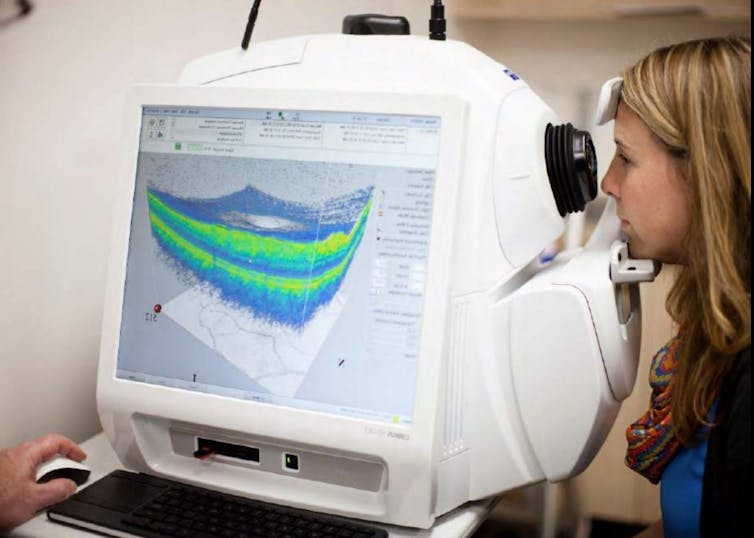
Retinal imaging also lends itself to being interpreted by artificial intelligence applications. This means assessment of Alzheimer’s disease risk from the retina could be quick, easy and widely available.
For these reasons, researchers are beginning to investigate how early the retina starts to thin in Alzheimer’s disease. The disease has an insidious onset, with a gradual decline in cognitive processes such as memory, but the underlying pathology tends to be fairly far along by the time people notice the symptoms and seek medical treatment.
If we can detect retinal thinning before the symptoms become apparent, it could be possible to identify people who are in the earliest stages of Alzheimer’s disease.
Retinal Thinning And Cognitive Decline In Middle Age
The people we studied are all part of the unique Dunedin Study, which tracked the development of a thousand babies born in Ōtepoti Dunedin between April 1972 and March 1973.
They’ve been assessed repeatedly every few years since, on a wide range of topics including mental health, risk-taking behaviours, respiratory and cardiovascular function, social support and dental health, among others.
They’ve also repeatedly undergone cognitive tests since they were children, each time using similar formats and standardised tests. This means we can compare their cognitive performance in middle age with their own results from childhood.
Most cognitive tests used in Alzheimer’s studies are blunt tools designed to detect large drops in cognition. But the detailed cognitive data we have allow us to detect even small cognitive changes.
Using statistical techniques, we used each person’s cognitive scores in childhood to predict what we’d expect their cognitive score to be at age 45, and measured how far away they were from what we’d predicted.
A number of study members’ scores were substantially lower than what we’d expect, indicating they were experiencing cognitive decline, even in middle age.

Why This Matters
While there are a number of potential causes of cognitive decline, papers from our research group are building up a picture of the factors associated with this outcome. We found people experiencing cognitive decline by 45 have older looking brains and more tiny bleeds and lesions, known as hyperintensities, in their white matter (measured using MRI).
Our research found people with thinner retinas had older looking brains and other structural brain abnormalities. This suggests cognitive decline, detected in its earliest stages, is associated with cell loss in the brain and the retina.
To investigate this question even further, we are now focusing on measuring study members’ levels of a specific type of protein (phosphorylated tau pTau181) which is abundant in neurons and deposited in cells in several neurodegenerative diseases. This is thought to be one of the earliest indicators of Alzheimer’s disease, and it will help us to understand whether the changes we are observing are specific to Alzheimer’s disease and how early they can be detected.
Developing treatments for advanced stages of Alzheimer’s disease has been ineffective so far, and it seems likely future pharmaceutical treatments will be most effective in the earliest stages of the disease.
Also, lifestyle-based interventions may help to mitigate symptomatic cognitive decline. This makes early identification of people who would benefit from these interventions extremely important.![]()
Ashleigh Barrett-Young, Postdoctoral Fellow in Psychology, University of Otago
This article is republished from The Conversation under a Creative Commons license. Read the original article.
4.7 Million Australians To Receive Government Payment Increases
COTA Australia Mature Workforce Survey
- ageist attitudes and behaviour are entrenched in many Australian workplaces
- discrimination based on age can profoundly impact on whether and to what extent people aged 45 years and over participate in paid employment and/or be invited to participate in upskilling opportunities
- workplaces should be free of age-based stereotypes – a person’s age shouldn’t determine their employment status
New Safe Haven For Vulnerable Older Women In East Gosford
Men's Sheds Grants And Movember Improving Men's Health
COVID-19 Oral Antiviral Treatment For Older Australians In Residential Aged Care
- seeking advance consent from residents or their representatives for antiviral treatment in the event of contracting COVID-19
- lining up General Practitioners to assess positive residents at short notice for the purposes of prescribing an antiviral oral treatment
- confirming there is a supply of oral antivirals held at the service
Biggest Increase To Age Pension In 12 Years But Timing Is Everything
Driving Your Pension Dollar Further
- Council rate rebates: Pensioners are entitled to up to $250 a year off their council rates. But depending on where you live, you can get an even bigger discount.
- Electricity rebate: The Low Income Household Rebate will shave up to $285 a year off your electricity bill for households with a retail provider.
- Gas rebate: This rebate will give you a discount of up to $110 a year.
- Water rates: Eligible pensioners can access a quarterly rebate, shaving hundreds of dollars a year off a typical household bill.
- Gold Opal: Unlimited travel for no more than $2.50 a day on public transport across Sydney, the Blue Mountains, Central Coast, Hunter, Illawarra and Southern Highlands.
- Toll relief: For the first time, pensioners can access toll relief from January thanks to the recent NSW Budget which delivers up to $750 a year cash back. Pensioners need to spend a minimum of $375 a year on tolls to be eligible for cash back.
- Travel vouchers: Pensioners are entitled to four Pensioner Travel Vouchers each calendar year. They can be used for two return or four single trips, giving access to free or discounted travel in economy class on NSW TrainLink Regional services within regional NSW.
- Free car rego: Pensioners in NSW don’t pay registration fees or motor vehicle tax on one of their cars. They also receive free driver’s licences, free driving tests and concessions on the cost of Mobility Parking Scheme permits.
- Free glasses: You can get yourself one pair of single vision glasses or one pair of bifocal glasses in a two-year period under the NSW Spectacles Program.
- Seniors Card: The NSW Seniors Card is packed with discounts for thousands of retailers and services across the state from groceries to tradespeople and insurance.
Dementia Action Week
19 – 25 September 2022
- Give a little support to a person living with dementia.
- Give a little support to a carer, friend or family member of a person living with dementia.
- Help healthcare professionals make their practice more dementia-friendly.
Celebrities Combine Forces And Voices To Support People Impacted By Dementia + National Dementia Helpline Now 24/7
The Webb telescope has released its very first exoplanet image – here’s what we can learn from it

Did you ever want to see an alien world? A planet orbiting a distant star, light years from the Sun? Well, the James Webb Space Telescope (JWST) has just returned its first-ever picture of just that – a planet orbiting a distant star.
The new images reveal JWST will be a fantastic tool for astronomers aiming to improve their knowledge of exoplanets (planets around other stars) – even better than we had hoped it would be!
But for those who’ve grown up on a diet of Star Trek, Star Wars, and myriad other works of science fiction, the images may be underwhelming. No wonderful swirling clouds, in glorious or muted colours. Instead, we just see a blob – a single point of light.
So why do these observations have astronomers buzzing with excitement? And what might we learn in the months and years to come?
Observing Hidden Worlds
Over the past three decades, we have lived through a great revolution – the dawn of the Exoplanet Era. Where we once knew of no planets orbiting distant stars, and wondered whether the Solar System was unique, we now know planets are everywhere.
At the time of writing, the number of known exoplanets stands at 5,084, and the count grows larger with every week.
But the overwhelming majority of those exoplanets are detected indirectly. They orbit so close to their host stars that, with current technology, we simply cannot see them directly. Instead, we observe their host stars doing something unexpected, and infer from that the presence of their unseen planetary companions.
Of all those alien worlds, only a handful have been seen directly. The poster child for such systems is HR 8799, whose four giant planets have been imaged so frequently that astronomers have produced a movie showing them moving in their orbits around their host star.
Enter HIP 65426b
To gather JWST’s first direct images of an exoplanet, astronomers turned the telescope towards the star HIP 65426, whose massive planetary companion HIP 65426b was discovered using direct imaging back in 2017.
HIP 65426b is unusual in several ways – all of which act to make it a particularly “easy” target for direct imaging. First, it is a long way from its host star, orbiting roughly 92 times farther from HIP 65426 than the distance between Earth and the Sun. That puts it around 14 billion kilometres from its star. From our point of view, this makes for a “reasonable” distance from the star in the sky, making it easier to observe.
Next, HIP 65426b is a behemoth of a world – thought to be several times the mass of the Solar System’s biggest planet, Jupiter. On top of that, it was also previously found to be remarkably hot, with temperature at its cloud tops measuring at least 1,200℃.
This combination of the planet’s size and temperature means it is intrinsically bright (for a planet).

How Were The Images Taken, And What Do They Show Us?
Under normal circumstances, the light from HIP 65426 would utterly overwhelm that from HIP 65426b, despite the distance between them.
To get around this problem, JWST carries several “coronagraphs”, instruments that let the telescope block the light from a bright star to look for fainter objects beside it. This is a bit like blocking the headlights of a car with your hand to see whether your friend has climbed out to say hello.
Using these coronagraphs, JWST took a series of images of HIP 65426b, each taken at a different wavelength of infrared light. In each image, the planet can be clearly seen – a single bright pixel offset from the location of its obscured stellar host.
The images are far from your standard science fiction fare. But they show that the planet was easily detected, standing out like a sore thumb against the dark background of space.
The researchers who led the observations (detailed on the preprint server arXiv) found that JWST is performing around ten times better than expected – a result that has astronomers around the globe excited to see what comes next.
Using their observations, they determined the mass of HIP 65426b (roughly seven times that of Jupiter). Beyond that, the data reveal the planet is hotter than previously thought (with cloud tops close to 1,400℃), and somewhat smaller than expected (with a diameter about 92% that of Jupiter).
These images paint a picture of an utterly alien world, different to anything in the Solar System.
A Signpost To The Future
The observations of HIP 65426b are just the first sign of what JWST can do in imaging planets around other stars.
The incredible precision of the imaging data suggests JWST will be able to obtain direct observations of planets smaller than previously expected. Rather than being limited to planets more massive than Jupiter, it should be able to see planets comparable to, or even smaller than, Saturn.
This is a really exciting. You see, a basic rule of astronomy is that there are lots more small things than big things. The fact JWST should be able to see smaller and fainter planets than expected will greatly increase the number of possible targets available for astronomers to study.
Beyond that, the precision with which JWST carried out these measurements suggests we will be able to learn far more about their atmospheres than expected. Repeated observations with the telescope could even reveal details of how those atmospheres vary with time.
In the coming years, then, expect to see many more images of alien worlds, taken by JWST. While those pictures might not look like those in science fiction, they will still revolutionise our understanding of planets around other stars.![]()
Jonti Horner, Professor (Astrophysics), University of Southern Queensland
This article is republished from The Conversation under a Creative Commons license. Read the original article.
Schools Celebrate Excellence + Innovation: Local Recipients Of 2022 Awards
 Students, teachers and parents have been acknowledged for their outstanding achievements, resilience and contribution to public education at the 2022 NSW Minister’s and Secretary’s Awards for Excellence.
Students, teachers and parents have been acknowledged for their outstanding achievements, resilience and contribution to public education at the 2022 NSW Minister’s and Secretary’s Awards for Excellence.- Minister’s Award for Excellence in Student Achievement
- Minister’s Award for Excellence in Teaching
- Secretary’s Award for Excellent Service
- Secretary’s Award for an Outstanding School Initiative
- Secretary’s School Achievement Award
- Public School Parent of the Year
Canberra’s Top Sites On Offer At The Click Of A Mouse
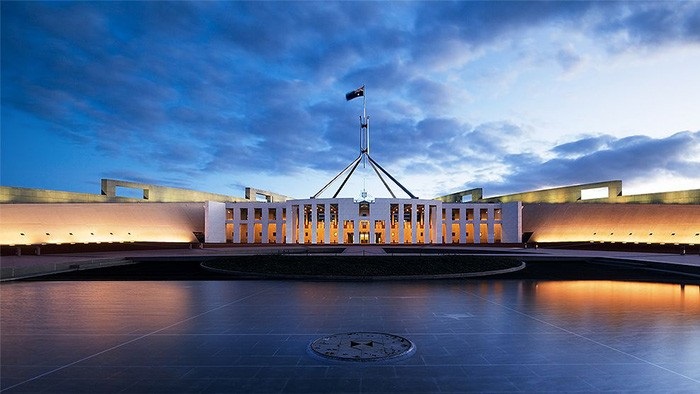
State Athletics Championship Back At Olympic Park
 One of state schools’ biggest sporting events is back in business with the Sydney Athletic Centre hosting the NSW Combined High Schools Sports Association (NSWCHSSA) Secondary Athletics Championship.
One of state schools’ biggest sporting events is back in business with the Sydney Athletic Centre hosting the NSW Combined High Schools Sports Association (NSWCHSSA) Secondary Athletics Championship.Securing A Brighter Future For Disadvantaged Youth
HSC Online Help Guides
Stay Healthy - Stay Active: HSC 2022

Woy Woy The Venice Of Australia
Be The Boss: I Want To Be A Cabinet Maker
- Communicate with clients to determine specific job requirements
- Match furnishing styles and materials to clients' needs
- Deliver and monitor service to clients
- Estimate job costs
- Measure and draw site layouts for manufactured furniture
- Read and interpret work documents in order to prepare accurate cutting lists for jobs
- Program and control computer-aided design (CAD) and computer numerical control (CNC) machines
- Understand and select timber and timber products for furniture production
- Fabricate custom furniture
- Prepare and assemble cabinets for installation
- Select and install hardware to furnishings, such as handles and hinges
- Perform on-site repairs and adjustments of cabinets
- Clean and maintain work areas, including machinery and tools, to ensure a safe working environment.
- Making frames for chairs and couches.
- Fitting hinges, locks, catches, drawers and shelves.
- May repair and refurbish furniture and antiques.
- Selecting and working with materials such as timber, veneers, particle board and synthetic wood.
- Marking out, cutting and shaping wood.
- Assembling parts to form sections of furniture and completed articles.
- Working from drawings and specifications to make furniture.
- Making fittings for boats, caravans and other items where fine detail is required.
- Examining drawings, work orders and sample parts to determine specifications.


Also Available:
- Be The Boss: I Want To Be An Automotive Mechanic
- Be The Boss: I Want To Be A Biotechnologist
- Be The Boss: I Want To Be A Pilot
- Be The Boss: I Want To Be A Music Producer
- Be The Boss: I Want To Be A Gardener
- Be The Boss: I Want To Be A Builder
- Be The Boss: I Want To Be A Confectioner
- Be The Boss: I Want To Be A Ship's Captain
The Queen In Australia - Trailer
Word Of The Week: Queen
noun
1. the female ruler of an independent state, especially one who inherits the position by right of birth. 2. the most powerful chess piece that each player has, able to move in any direction along a rank, file, or diagonal on which it stands. 3. the wife or widow of a king, the wife or widow of a tribal chief. 4. a female monarch. 5. a female chieftain. 6. a woman eminent in rank, power, skills or attractions; 'a movie queen'. 7. a goddess or a thing personified as female and having supremacy in a specified realm. 8. playing card marked with a stylized figure of a queen. 9. the fertile fully developed female of social bees, wasps, ants, and termites whose function is to lay eggs. 10. a mature female cat kept especially for breeding. 11. a drag queen.
From 12th century Middle English quene, from Old English cwēn woman, wife, queen; akin to Goth qens wife, Greek gynē woman, Sanskrit jani
Queen Elizabeth II's top ten favourite songs were
- Oklahoma - Howard Keel
- Anything You Can Do (Annie Get Your Gun) - Dolores Gray and Bill Johnson
- Sing - Gary Barlow and the Commonwealth Band featuring the Military Wives
- Cheek To Cheek- Fred Astaire
- The White Cliffs Of Dover - Vera Lynn
- Leaning On A Lamppost - George Formby
- Praise, My Soul, The King Of Heaven
- The Lord Is My Shepherd
- Lester Lanin Medley
- Regimental March "Milanollo"
The late Queen Elizabeth II's affinity for the "Oklahoma!" musical soundtrack apparently goes back to a London opening night performance of the Broadway hit during her 1947 courtship with the late Prince Philip. "Oklahoma!," the popular debut musical by Richard Rodgers and Oscar Hammerstein, first played at the Drury Lane theatre in London's West End on April 30th, 1947. Hotly anticipated, "Oklahoma!" was the first Broadway musical to reach London after World War II, with hundreds of performances selling out repeatedly.
The royal family, which included 21-year-old then-Princess Elizabeth, were the guests of honour on opening night, and Prince Philip was also accompanying them, according to TIME magazine. The two had first met as children in 1934, before reconnecting in 1939, after which Elizabeth fell in love with Philip while exchanging letters during his wartime service for the Royal Navy.
In a special 2016 BBC 2 radio programme 'Our Queen: 90 Musical Years', broadcast on June 12th 2016 it was reported that the monarch's correspondence secretary once asked whether, as head of the Armed Forces and head of the Church of England, it was appropriate for her to say yes to becoming President of the George Formby Appreciation Society.
The Queen was said to have replied, "Well, I do see that, but you see I love George Formby... I know all his songs and I can sing them."
According to the website of the same society Her Majesty did not become President of the George Formby Appreciation Society, although it was a well-known fact that George Formby visited the Royal family to give a private performance when the Queen was a child.
The Queen's cousin Lady Elizabeth Anson told that 2016 programme: "We did a lot of singing at Kensington Palace.
"Nobody thought it was odd after dinner if we put on a record and all sang Doing The Lambeth Walk, so music has always been part of her life.
"The Queen loves the theatre and musicals like Showboat, Oklahoma! and Annie Get Your Gun... The Queen is a fantastic dancer. She's got great rhythm."
"Leaning on a Lamp-post" is a popular song written by Noel Gay and best known in the version by George Formby. Formby recorded the song for Regal Zonophone Records on 5 September 1937, and it became one of his most popular and best-remembered songs.
George Formby, OBE (born George Hoy Booth; 26 May 1904 – 6 March 1961) was an English actor, singer-songwriter and comedian who became known to a worldwide audience through his films of the 1930s and 1940s. On stage, screen and record he sang light, comical songs, usually playing the ukulele or banjolele, and became the United Kingdom's highest-paid entertainer. During the Second World War he worked extensively for the Entertainments National Service Association (ENSA), and entertained civilians and troops. By 1946 it was estimated that he had performed in front of three million service personnel.
Shortly after Formby's death a small group of fans formed the George Formby Society, which had its inaugural meeting at the Imperial Hotel Blackpool. George Harrison was a fan of Formby, a member of the Society and an advocate of the ukulele. The rest of the Beatles were also fans—they improvised with ukuleles during the recording breaks on Let It Be—and Formby's influence can be heard in the song "Her Majesty".
In 2011 the society celebrated its 50th anniversary, and today it has more than 1,200 members worldwide. On April 21st 2018, the Society played at the Royal Albert Hall at The Queen's Birthday Party with guest artists Frank Skinner, Ed Balls and Harry Hill.
George Formby - Leaning On A Lampost
Her Majesty - The Beatles
Abba - Dancing Queen
If your landlord wants to increase your rent, here are your rights

Inflation is pushing up interest rates. Interest rates are pushing up mortgage costs. There’s talk of a rental supply crisis. This means there’s a good chance your landlord wants to increase your rent.
So what are your rights as a renter? That depends on where you live, because residential tenancy laws are determined by state and territory governments. There are, however, many commonalities. Here’s a rundown.
When Can Your Landlord Raise The Rent?
In every state and territory there are limits on when and how often your landlord can raise the rent.
If you are on a fixed-term lease your rent cannot be increased during the lease period, unless the lease itself specifically provides for such an increase. This makes it worthwhile to negotiate a longer fixed-term lease if you can.
If you are on a periodic (month-to-month) lease, state and territory laws set limits on the frequency with which the rent can be increased. For the Northern Territory, Queensland and Western Australia, rent can be raised every six months. Elsewhere, it is every 12 months.
What Must The Landlord Inform Me Of?
Landlords do not need to provide a reason for increasing the rent.
They are, however, required to strictly follow notification procedures – informing you in writing, using forms that are specified in relevant regulations, and giving you advance notice of the increase.
Minimum notice periods for increasing rent differ, from 30 days in the Northern Territory to 90 days in New South Wales. For the other state and territories it is about 60 days (see the table above).
If your landlord does not comply with these requirements, you are not obliged to pay the higher rent.
Is There Any Limit On How Much My Rent Can Increase?
The Australian Capital Territory is the only jurisdiction that puts a cap on rent increases. They are limited to no more than 10% above the Consumer Price Index for Canberra. Any larger increase must be approved by the ACT Civil and Administrative Tribunal.
In all jurisdictions, however, you can appeal to the tribunal or court that oversees residential tenancy laws if you believe a rent increase is excessive.
These bodies have the power to reduce or refuse the increase. They can also order landlords to reduce the rent in some circumstances (such as if disrepair or damage makes the property less fit for living).
No state and territory residential tenancy legislation defines what makes rent “excessive”. But they do include similar lists of things a tribunal or court may consider to determine whether rent is excessive.
These include the rent of comparable premises, and the property’s value and condition. You will need to provide this evidence, because the burden of proving your rent is excessive is on you.
Can I Be Evicted So The Landlord Can Charge More Rent?
A landlord can terminate a fixed-term lease at its expiry for any reason (as long as they follow the notice provisions).
They cannot terminate a fixed-term lease earlier than its expiry just so they can raise the rent for new tenants. They must have a legitimate reason, for instance if you are continually breaching the terms of the lease, or making the property uninhabitable. They must provide the reason in writing.
With the exception of Victoria, a landlord can terminate a periodic lease for any reason. The only requirement is a minimum notice period. In Victoria, your landlord must give and substantiate a valid reason. Wanting to lease out the property at a higher rent is not a valid reason.
In Short, What To Check?
1) Check your lease. If it’s a fixed-term lease, look to see if the terms allow for a rent increase.
2) Check your landlord has used the correct form for the notice and given you at least the minimum notice period.
3) Seek advice from your local tenants’ advisory service or relevant government tribunal or agency if you are in doubt. The organisations in the following table are a good place to start.
![]()
Brendan Grigg, Senior Lecturer in Law, Flinders University and Hossein Esmaeili, Associate professor, Flinders University
This article is republished from The Conversation under a Creative Commons license. Read the original article.
What happens to Australia’s money now the Queen has died? And why are leaders’ faces on coins anyway?

Since the introduction of decimal coinage in 1966, about 15 billion Australian coins have been minted with an image of Queen Elizabeth II.
Many of us fondly associate her image with Australian coins, and for most of us it’s all we have ever known (on one side of our money, at least).
Of all the changes that lie ahead now the queen has died, one of the most conspicuous, and to some the most jarring, will be that our new coins will soon be adorned with a portrait of King Charles III.
What Happens Now?
Tradition holds that each British monarch’s portrait on coins should face in the opposite direction to their predecessor. George IV faced left, Elizabeth II faced right, and thus we expect Charles III will face left.
The design of Charles’ portrait (or “effigy”) is yet to be determined, but it will be supplied by the United Kingdom’s Royal Mint, and Australia’s new coins will be in circulation from 2023.
Traditionally, the reigning monarch is also portrayed on the smallest denomination banknote, but the Reserve Bank of Australia has indicated it will be some time before we see King Charles III on our $5 note. Until then, don’t worry, it will be business as usual. All Australian money bearing a portrait of Queen Elizabeth II remains legal tender, and is likely to circulate for many years to come.
Ideologically speaking, the next chapter in Australian coinage is open. What message will the portrait and imagery of Charles III communicate? Will it be one of unity, diversity, leadership, strength, openness, or something else? How will the message be communicated?
Hopefully, we can anticipate a meaningful portrait of King Charles III circulating on our coinage, which captures something of our collective past traditions and future aspirations.
Six Progressively Ageing Portraits
In total we have seen six progressively ageing portraits of Queen Elizabeth II on Australian coins.


Australians first saw Elizabeth on their coins in pre-decimal times: 1953, to be exact, the year of her coronation. At that time, our money was based on British pounds, shillings and pence.
Thirteen years later, on February 14 1966, Australians awoke to a new currency, the Australian dollar, featuring a decimal system.
Cue the collective sigh of relief and joyful cheers of primary school students who no longer had to suffer the complex mathematical calculations of 12 pence to the shilling, and 20 shillings to the pound.
The visual element that was unchanged in the transition from Australian pounds to Australia dollars in 1966 was the portrait of Queen Elizabeth II, which continued to adorn the “heads” side of the coin.
In preparation for the 1966 currency change, media outlets of the day broadcast this educational ditty, set to the tune of “Click go the Shears”:
In come the dollars and in come the cents
To replace the pounds and the shillings and the pence
Be prepared, folks, when the coins begin to mix
On the fourteenth of February, Nineteen Sixty-Six.
Why Do We Have Leaders’ Faces On Our Coins Anyway?
The invention of coinage stretches back over 2,500 years. During the seventh and sixth centuries BCE, city states in Asia Minor (modern-day Turkey) began minting coins from gold and silver and using them as a means of economic exchange.
But coins were not only important as units of currency. They had (and have) the capacity to communicate ideas and stories graphically.
Initially, the design of coinage used symbols and depictions of gods and goddesses. It was only two centuries later, around 445-395 BCE, that a human face (Tissaphernes, a Persian soldier and statesman) first appeared on a coin, and even then it was a humanised deity.
In the ensuing centuries, rulers have celebrated and reinforced their rule through honorific portraiture on coinage. As one scholar has noted, “coins and statues allowed for the diffusion of the likeness of the ruler in the realm, rendering him omnipresent and his face familiar to his subjects”.

Julius Caesar was the first living Roman to depict a portrait of himself on a coin. Accompanied by the inscription “CAESAR DICT PERPETVO” (Caesar, dictator for life), the coin made a bold statement about the apparent length of his rule. Ironically, however, this coin was one of the catalysts for cutting short his life through assassination.
The Roman people had officially overthrown the monarchy of its founders in 509 BCE, but occasionally flirted with centralised power. Caesar’s kingly act of putting his portrait on coinage, along with other ways he concentrated his power, was deemed more than mere flirtation. It was seen as a direct threat to 500 years of Roman tradition.
As we consider the implications of Queen Elizabeth II’s passing for our own country, its governance and symbols that represent it, we should not neglect the significance of the symbols that define our culture. Or, at the very least the images that accompany us in our daily routines, even the apparently mundane.![]()
Michael P. Theophilos, Associate Professor, Australian Catholic University
This article is republished from The Conversation under a Creative Commons license. Read the original article.
Doomscrolling is literally bad for your health. Here are 4 tips to help you stop

Doomscrolling can be a normal reaction to living through uncertain times. It’s natural to want to understand dramatic events unfolding around you and to seek out information when you’re afraid. But becoming absorbed in bad news for too long can be detrimental.
A newly published study has found that people with high levels of problematic news consumption are also more likely to have worse mental and physical health. So what can you do about it?
We spoke to Australians in the state of Victoria about their lengthy lockdown experiences and found how they managed to stop doomscrolling. Here are some tips to help you do the same.
Doomscrolling – Unhelpful And Harmful
“Doomscrolling” describes what happens when someone continues to consume negative news and information online, including on social media. There is increasing evidence that this kind of overconsumption of bad news may have negative impacts.
Research suggests doomscrolling during crises is unhelpful and even harmful. During the early COVID-19 pandemic, consuming a lot of news made people feel overwhelmed. One study found people who consumed more news about the pandemic were also more anxious about it.
Research into earlier crises, like 9/11 and the Boston Marathon bombings, also found that sustained exposure to news about catastrophes is linked to negative mental health outcomes.
Choosing To Take Control
During the peak of COVID-19 spread, many found themselves doomscrolling. There was lots of bad news and, for many people, lots more spare time. Several studies, including our own, have found that limiting news exposure helped people to cope.
Melbourne, the state capital of Victoria, experienced some of the longest-running lockdowns in the world. Wanting to know how Victorians were managing their news consumption during this time, we launched a survey and held interviews with people who limited news consumption for their own wellbeing.
We found that many people increased their news consumption when the lockdowns began. However, most of our participants gradually introduced strategies to curb their doomscrolling because they realised it was making them feel anxious or angry, and distracted from daily tasks.
Our research found these news-reduction strategies were highly beneficial. People reported feeling less stressed and found it easier to connect with others. Here are some of their strategies, which you might want to try.
1. Make A Set Time To Check News
Rather than checking news periodically across the day, set aside a specific time and consider what time of day is going to have the most positive impacts for you.
One participant would check the news while waiting for her morning cup of tea to brew, as this set a time limit on her scrolling. Other participants preferred saving their news engagement for later in the day so that they could start their morning being settled and focused.
2. Avoid Having News ‘Pushed’ To You
Coming across news unexpectedly can lure you into a doomscrolling spiral. Several participants managed this by avoiding having news “pushed” to them, allowing them to engage on their own terms instead. Examples included unfollowing news-related accounts on social media or turning off push notifications for news and social media apps.
3. Add ‘Friction’ To Break The Habit
If you find yourself consuming news in a mindless or habitual way, making it slightly harder to access news can give you an opportunity to pause and think.
One participant moved all her social media and news apps into a folder which she hid on the last page of her smartphone home screen. She told us this strategy helped her significantly reduce doomscrolling. Other participants deleted browser bookmarks that provided shortcuts to news sites, deleted news and social media apps from their phones, and stopped taking their phone into their bedroom at night.
4. Talk With Others In Your Household
If you’re trying to manage your news consumption better, tell other people in your household so they can support you. Many of our participants found it hard to limit their consumption when other household members watched, listened to, or talked about a lot of news.
In the best cases, having a discussion helped people come to common agreements, even when one person found the news comforting and another found it upsetting. One couple in our study agreed that one of them would watch the midday news while the other went for a walk, but they’d watch the evening news together.
Staying Informed Is Still Important
Crucially, none of these practices involve avoiding news entirely. Staying informed is important, especially in crisis situations where you need to know how to keep safe. Our research shows there are ways of balancing the need to stay informed with the need to protect your wellbeing.
So if your news consumption has become problematic, or you’re in a crisis situation where negative news can become overwhelming, these strategies can help you strike that balance. This is going to remain an important challenge as we continue to navigate an unstable world.![]()
Kate Mannell, Research Fellow in Digital Childhoods , Deakin University and James Meese, Research Fellow, Technology, Communication and Policy Lab, RMIT University
This article is republished from The Conversation under a Creative Commons license. Read the original article.
World’s earliest evidence of a successful surgical amputation found in 31,000-year-old grave in Borneo
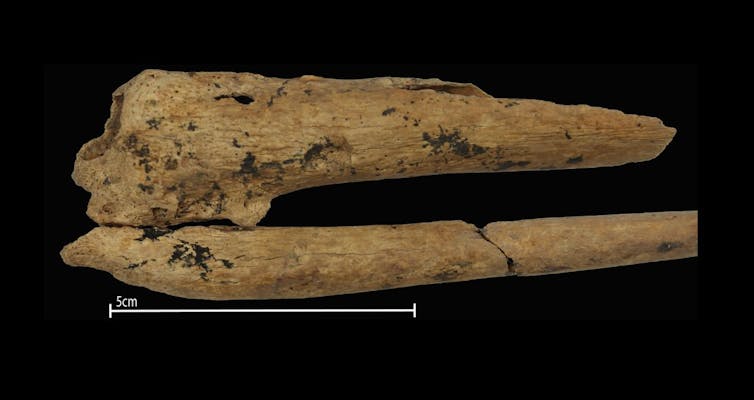
Modern medicine seems to advance with time thanks to research breakthroughs. Hence it’s often thought that further into the past, only simpler medical practices existed.
The medical expertise of foraging communities such as hunter-gatherers has been thought to be rudimentary and unchanging. It’s been argued that shifts towards settled agricultural life within the past 10,000 years were what created new health problems and advances in medical culture; this includes surgery.
Published today in the journal Nature, we report a discovery shattering this longstanding trope of popular imagination – the skeleton of a young adult from Borneo whose lower left leg was amputated in childhood by a prehistoric surgeon 31,000 years ago.

This finding pre-dates the previous oldest known evidence for amputation surgery by a staggering 24,000 years. It suggests that human medical knowledge and surgical procedures were far more advanced in the distant past of our species than previously thought.
The Borneo Discovery
In 2018, some of the earliest known rock art was found in caves of East Kalimantan, Borneo, dating to 40,000 years ago.
The following year, archaeologists from Griffith University, University of Western Australia, and Indonesian institutions of archaeology and conservation (Arkeologi, Bahasa dan Sastra, Pusat Riset Arkeometri BRIN / Balai Pelestarian Cagar Budaya Kalimantan Timur) searched remote caves in dense rainforest for archaeological finds that could shed light on the lifeways of these early artists.
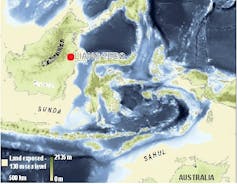
Led by local Dayak colleagues, the team travelled to a remote camp via a multi-day canoe and hiking journey. It was accessible only by boat at certain times of the year.
During these field trips, in early 2020 the team conducted archaeological excavation within Liang Tebo cave. There, they uncovered a complete human burial, with grave goods of brightly coloured red ochre pigments and stone burial markers.
Upon closer analysis of the leg bones of the remains, an unexpected discovery emerged.
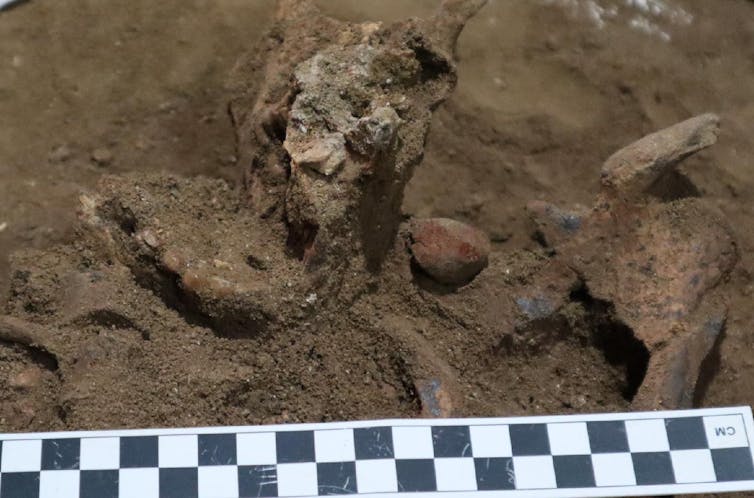
Evidence For Amputation At 31,000 Years
Multiple dating techniques (radiocarbon, uranium-series, and electron-spin-resonance) confirmed the burial had taken place 31,000 years ago, making it Southeast Asia’s oldest known grave. Skeletal analyses confirmed the lower left limb had been surgically amputated; the way the bone tissue had changed over time (known as “bone remodelling”) matched clinical cases of successful amputation that hadn’t become infected.
The healed bone confirms an injury that wasn’t fatal to the patient, implying the surgeon or surgeons likely understood the need to manage and treat it. They were able to prevent infection after the invasive surgery, allowing the person to survive into adulthood.
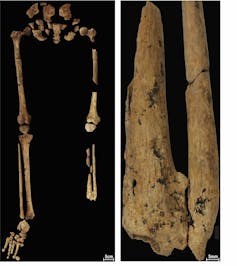
Medical Developments In Tropical Rainforests
In the tropical rainforests of Borneo, hot and humid conditions create the perfect breeding ground for various microbes, and therefore increase the chances of getting a wound infected. But the rainforests also have astonishingly rich plant species diversity. This vast “natural pharmacy” may have prompted early flourishing in the use of botanical resources.
The surgeons treating the amputation patient could have drawn upon locally available botanical resources before, during, and after the procedure. Such medicinal plants could have provided anaesthetics and antimicrobial remedies preventing infection.
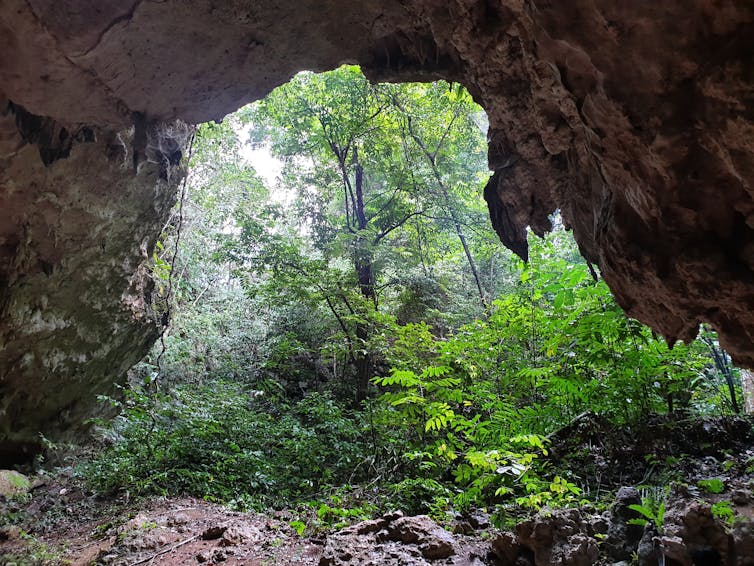
Surviving a childhood amputation and living into adulthood among rainforest caves of Borneo also suggests a high degree of community care. A community that painted complex figurative art had also seemingly mastered the complexities of surgical amputation 31,000 years ago.
Sea levels being much lower at this time, Borneo was still connected to Asia. This means the survivor of this surgery also lived close to the potential departing shorelines of ice-age Asia, from where the world’s first mariners departed earlier still, eventually reaching what is now Australia.
This new finding adds to a growing body of evidence that the first modern human groups to reach our part of the world tens of thousands of years ago had medical knowledge and skills beyond what was previously thought.![]()
Tim Ryan Maloney, Research fellow, Griffith University; Adam Brumm, Professor, Griffith University; Adhi Oktaviana, PhD Candidate, Griffith University; India Ella Dilkes-Hall, Forrest Foundation Prospect Fellow, The University of Western Australia; Maxime Aubert, Professor, Griffith University; Melandri Vlok, Postdoctoral research associate, University of Sydney, and Renaud Joannes-Boyau, Associate Professor, Southern Cross University
This article is republished from The Conversation under a Creative Commons license. Read the original article.
A giant ‘bullseye’ on the Nullarbor Plain was created by ancient sea life
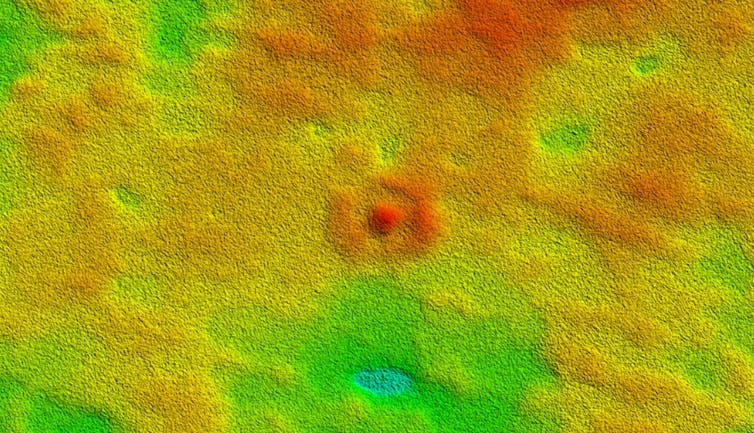
Environments across the planet are changing dramatically in response to human population growth and climate change. Some scientists even say human activity has pushed Earth into a new geological epoch: the Anthropocene.
Amid this rapid transformation some special places, protected by fortuitous geography and geology, change so slowly they preserve evidence of Earth’s past over unfathomable timescales.
One such place is the flat, dry expanse of the Nullarbor Plain in southern Australia, where traces still remain of events millions of years in the past. Using high-resolution satellite imaging we have begun to map out some of these traces.
In new research published today in Earth Surface Processes and Landforms, we report the discovery of an enigmatic “bullseye” structure more than a kilometre across. We believe it is the remains of an ancient reef, created by microbes some 14 million years ago when the Nullarbor was at the bottom of the ocean.
No Trees, No Water, But Not Boring
Named the Nullarbor Plain (meaning “treeless”) during colonisation, and Oondiri (meaning “waterless”) by some of the First Nations people of the area, the region is notoriously dry, flat and barren. The exceptional overall flatness of the plain (the average slope is much, much less than 1°) is one of the first indicators of the region’s stability.
The rocks beneath the Nullarbor Plain are made of limestone that originally formed in shallow marine seagrass meadows. Such rocks can dissolve in weakly acidic rain and groundwater.
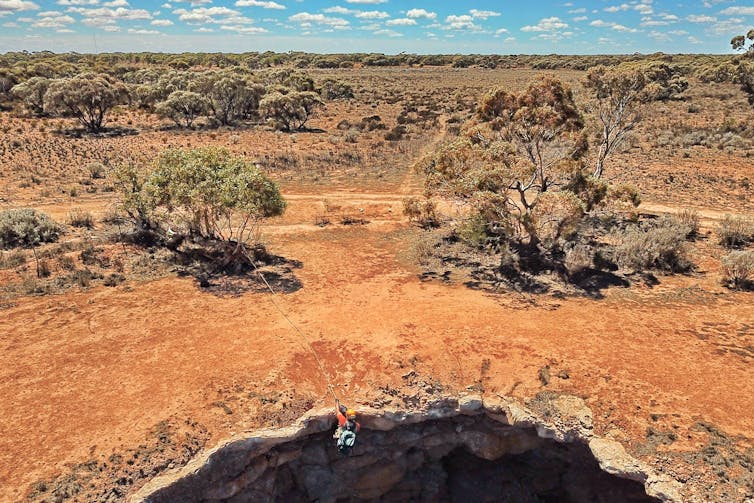
Due in part to its dryness, the region has not been intensively dissolved, or eroded by rivers or glaciers in the millions of years since it emerged from the ocean. This is in stark contrast to the classic ruggedness of much younger tropical landscapes (such as the volcanic Hawaiian islands), which are far wetter and more geologically active.
The plain covers some 200,000 km² and, like the curvature of the Earth, landscape features on the Nullarbor Plain are almost imperceptible to the human eye. Despite this subtlety, the area is not as featureless as you might think.
Careful scientific study and high-resolution satellite data are increasingly revealing the secrets of the Nullarbor Plain’s past.
Mummified Marsupials And Ancient Dunes
Isolated caves do punctuate the Nullarbor Plain. Within their dry chambers, remarkably preserved fossils yield glimpses of Australia’s extinct animals that would rival the most wondrous zoo menagerie.
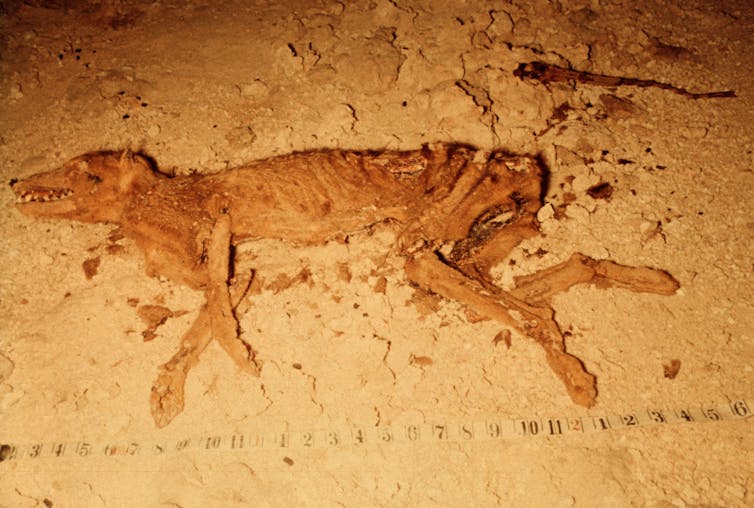
Mummified thylacine (Tasmanian tiger) remains and complete thylacoleo (marsupial lion) skeletons from thousands of years ago capture striking snapshots of changing ecosystems.
Older still are gentle linear ridges that cross the Nullarbor Plain. Recently, we showed these ridges are relics of a long-vanished landscape. Ancient sand dunes controlled the gentle dissolution of the underlying limestone to leave a subtle imprint of windblown patterns from millions of years ago.
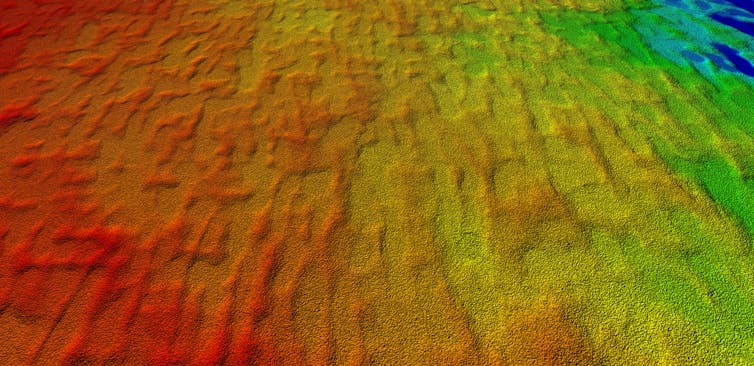
The Bullseye
For our most recent work, we used landscape data from the TanDEM-X Digital Elevation Model produced by the German Aerospace Centre, which has a resolution of around 12 metres.
Studying these images of the Nullarbor revealed a previously unnoticed “bullseye” feature: a ring-shaped hill with a central dome, just over a kilometre wide and only a few metres high.
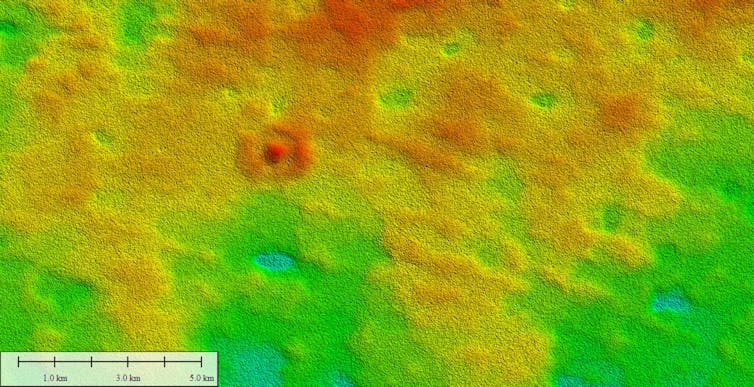
Initially, we thought we had found the first meteorite impact crater to be discovered on the Nullarbor Plain. The area is famous for meteorites that can help us understand the history of our solar system, but to date no definitive craters caused by meteorites have been found.
However, when we took a closer look at the bullseye we saw none of the chemical or high-pressure indicators of an impact.
We uncovered the real explanation for the bullseye after cutting and polishing samples of rock thin enough to let light shine through, and inspecting them under a microscope. Unlike the limestone seen at hundreds of other sites across the plain, here we saw evidence for tiny microbial organisms holding the sediment together.
Supported by similar “doughnut” structures formed by algae on the Great Barrier Reef, we interpreted the bullseye as an ancient isolated “reef”. This biogenic mound formed on the seabed long ago but degraded so slowly after the land was lifted above the waves that it is still recognisable roughly 14 million years later.
How Understanding The Past Can Help The Future
Our findings add to increasing recognition of the region as an exceptional archive of environmental change that we must better understand and protect.
The emergence of the Nullarbor Plain has been an important driver of the evolution of plants and animals. Ancient fossils and even DNA preserved due to the stable conditions will help us more accurately reconstruct its vanished ecosystems.
More complete understanding of how landscapes and ecosystems were transformed in the past will in turn help us conserve the animals, plants and environments we have today, and minimise the negative impacts of future anthropogenic climatic change.![]()
Milo Barham, Senior Lecturer, Earth and Planetary Sciences, Curtin University and Matej Lipar, Research Associate, Physical Geography, ZRC SAZU
This article is republished from The Conversation under a Creative Commons license. Read the original article.
House of Dragons – an introduction to the stories and British history that inspired the beasts of Westeros

Dragons have inspired awe and wonder since the beginning of human imagination. Most recently, these fire-spitting flying creatures – in modern western culture at least – have come alive in Game of Thrones and its new spin off, House of Dragons.
These winged beasts are particularly important in the new series. Set 200 years before Game of Thrones, the series follows the Targaryen family who rules Westeros with the help of their dragons.
In the medieval west, dragons feature both in literature and in political history and prophecy. They reached their heyday in Arthurian stories, most notably in Merlin’s legendary prophecies of two dragons fighting for the sovereignty of two warring peoples. This story was later used and reused for centuries for political gain by real historical people.
The beasts of Westeros, the fictional land in which these series are set, owe a debt to these tales. So, for those who want to stand out from the crowd in online debates about the new series, here is an introduction to the dragons of Westeros that takes in Arthurian legend, a handful of battles and wars, the Tudors and the story of a contested heir.

This article is part of Quarter Life, a series about issues affecting those of us in our twenties and thirties. From the challenges of beginning a career and taking care of our mental health, to the excitement of starting a family, adopting a pet or just making friends as an adult. The articles in this series explore the questions and bring answers as we navigate this turbulent period of life.
You may be interested in:
Lord of the Rings: Rings of Power – a cheat’s guide to Middle-earth before you watch the new show
Salman Rushdie: where to start with this pioneering and controversial author
Five dating tips from the Georgian era
Dragons In Western Literature
The dragon’s roots in medieval lore go back to their image as menacing animals, such as the dragon at the end of the Germanic story of Beowulf. In this epic poem, Beowulf, a Scandinavian hero defeats Grendel, an outcast creature of gigantic stature in order to defend the Geats. After years of peace, Beowulf dies in combat against a new enemy, a dragon that holds power and a hoard of precious treasures – possibly in an act that symbolises the faults of a bad king in early culture.
Early Christian authors gave dragons human characteristics such as greed and in literature, dragons signalled the sin of avarice – they were creatures to fear and defeat. In later medieval Europe, however, red and white dragons featured in the pre-history of the legendary King Arthur of the Pendragon dynasty.

According to Geoffrey of Monmouth’s Historia Regum Britanniae (History of the Kings of Britain), first written in the 12th century, Arthur’s father, Uther Pendragon, gets his surname from witnessing a comet in the sky (the “pen” in his name meaning “head”) that resembles a fire-spitting dragon.
Prior to Uther’s reign, it is Vortigern, a Celtic leader (said to have invited the Saxons into Britain) who finds that his building of a tower at Dynas Emrys in North Wales is prevented by the underground struggle between a white and red dragon. The red dragon symbolises the Welsh and the white the Saxons. This Arthurian prophecy of these battling beasts was used to tell of a time when a leader would come to liberate the Welsh. This prophecy endured for centuries.
Dragons And Prophecy
By the time Arthur was written into medieval history books, however, his Welsh ancestry had all but been forgotten, and he had been assimilated into English culture. This erasure led generations of English kings to claim descent from Arthur, if tenuously. This was particularly so during the Wars of the Roses (1455-87) when the white rose and red rose, representing the houses of York and Lancaster, clashed in a dynastic war that decimated the aristocracy. When it came to an end, with Henry Tudor bringing together in his descent the two dynasties and the Welsh line, the fighting white and red dragon could be said to have gone to rest.
Shakespeare’s dramatic rendering of the infamous Machiavellian-style politics during the Wars of the Roses in his series of history plays gave Game of Thrones’s creator, George R.R. Martin, a powerful source of inspiration for his books. Dynastic wars dominate Game of Thrones but the presence of dragons and their political significance comes to the fore in House of Dragons.
In the second episode of House of Dragons, king Viseryis reveals to his heir, princess Rhaenyra, that the Targaryen dynasty has only really held its position thanks to controlling the power dragons yield. The political power struggle that unravels is reminiscent of the period of English history known as The Anarchy (c. 1138-53), when the only male heir of King Henry I of England died and Matilda, the king’s daughter, was designated heir – the first female in England.
Stephen of Blois, the king’s nephew, contested Matilda’s claim and bitter struggles ensued. It can easily be seen that a period like this brought much anxiety and concern about the future. At this time, Geoffrey’s works, the Historia and also his Prophecies of Merlin, steeped in Arthurian legend as they were, were used to build hope in prophecy as a tool to read the future of politics while the prospect of peace was nowhere in sight.
The Anarchy in England preceded the Wars of the Roses by almost as many years as the action depicted in House of Dragons precedes the events of Game of Thrones. It is easy to see how these periods and their myths inspired Martin. In both of these historical periods of turmoil, and in Martin’s series of novels, human control over prophecy is as difficult as their control over dragons.
Prophetic texts were used to infuse politics with hope for a charismatic leader and dragons could only enhance the enticing aura of mystery around such a future. It is here that Martin’s use of dragons moves to a more modern taste for fantastical power.
Interestingly, dragons of yore had to be dominated or defeated; their occasional use in heraldry and art was meant to impress and inspire awe. The dragons of Westeros, however, are most powerful when lead, in both TV series, by young female characters who nurture rather than destroy or dominate these creatures. In the prequel, we are just getting a look at this relationship. We should expect a lot more legend and violence, but also more inspiring female-dominated politics and more dragon action.![]()
Raluca Radulescu, Professor of Medieval Literature and English Literature, Bangor University
This article is republished from The Conversation under a Creative Commons license. Read the original article.
Seaweed is high in vitamins and minerals – but that’s not the only reason westerners should eat more of it
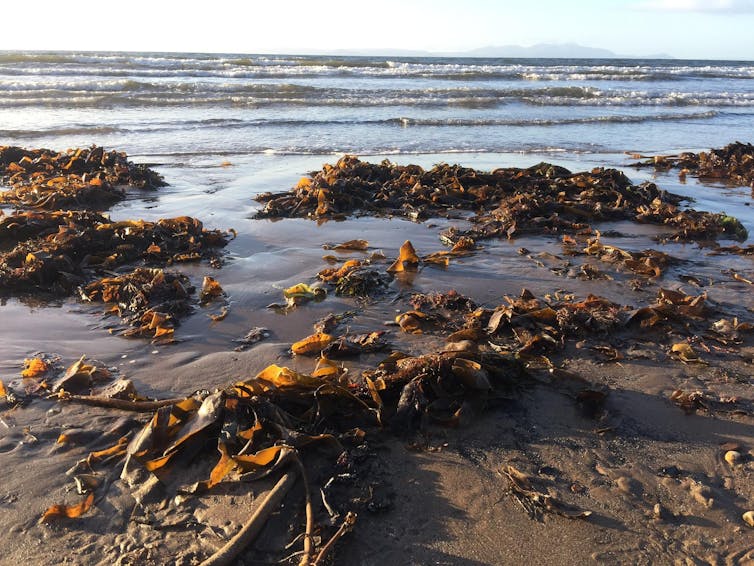
Edible seaweeds and algae - or sea vegetables - are a group of aquatic plants that are found in the ocean. Kelp, dulse, wakame and sea grapes are all types of seaweeds that are used in seaweed-based dishes.
Though eating seaweed is mostly common in Asian countries, today seaweeds are widely growing in popularity as an ingredient in a range of food and beverages. This notably includes sushi, where nori seaweed is used as an edible wrap for vegetable, fish, and rice-based fillings.
Our research suggests that people in the UK, like consumers in other western countries, are less familiar with seaweed as an ingredient. This is important because food neophobia (wanting to avoid novel foods) may prevent consumers from trying new products.
And for seaweeds in particular, first impressions may be less appealing when associated with the plant washed up on our beaches. For example, many participants in our research imagined seaweed to be “smelly”, “salty”, and “slimy” when asked.
Despite this, many European countries have a history of consuming seaweeds. This includes laverbread, a savoury puree made from laver seaweed, which is eaten alongside other seafood as part of Welsh cuisine. A sweet alternative is carrageen pudding, a jelly-like dessert made from carrageen seaweed (otherwise known as Irish moss).
However, this traditional consumption of seaweed remains somewhat niche today. And with the exception of sushi, seaweed consumption is relatively low in most western countries.
In a recent study, we explored how consumers rate seaweeds and potential food products (that could be supplemented with seaweed) when thinking about eating them. We found that people expected seaweed food products (such as seaweed burgers) to be more appealing than seaweed as a general food source.
Notably, as participants already expected seaweed products to be healthy and sustainable, these attributes were less important to their acceptance of seaweed. Taste and familiarity were the two factors that had the greatest influence on participants’ willingness to try and buy seaweed-based foods.
This is useful because seaweeds are a highly versatile and nutritious food source that can benefit our diet. Seaweeds are often rich in fibre and high in vitamins and minerals. This includes iodine and vitamin B12, which can be lacking in vegetarian and vegan diets.
And seaweeds can be added to a range of products for their taste as well as how they can be used to thicken soups or stabilise the texture of ice cream. As seaweeds have a umami flavour, many chefs also favour seaweeds as a way to enhance the depth of flavour in their dishes.
Climate-Friendly Food
Thinking about what we eat has become an important environment-related talking point. As more of us try to eat less meat and dairy, we have seen a rise in the consumption of plant-based products (including burger patties, nuggets, and sausages), plant-based milk (soya, almond, rice, and oat milk), and other dairy alternatives (such as dairy-free yoghurt and cheese).
In the current market, plant-based “meat” is typically made from soya, with other plant-based proteins including peas, mushrooms, and wheat.
Importantly, seaweeds and algae could be worthy additions to this list. Though the protein content of seaweed differs between species (particularly as it goes through the production process), protein can account for up to 25% of the dry weight for green seaweeds, and 47% for red seaweeds.
This means that seaweeds could be used to supplement the nutritional content of protein alternatives. In particular, seaweeds are often low in sodium. As the salt content of plant-based meat products can be higher than similar products, seaweeds could be used as an alternative seasoning to salt, helping to improve the healthiness of these items while enhancing taste.
Seaweeds also have the potential for sustainable farming along the UK coastline. When compared to other plant-based alternatives, this means they stand out for their ability to grow without freshwater or fertilisers and do not compete for land space.
Our research also suggests that including more taste-focused language on packaging (delicious, warm, rich) and providing recipe ideas to consumers (serve seaweed as a side dish) may be an important marketing strategy if future seaweed products are to find new audiences.
There are some additional barriers that we need to consider. For example, like other plant-based alternative foods, seaweed can be more expensive, and high street availability is limited compared to online. Also, as the nutrients in seaweeds are affected by the waters they grow in, eating too much or consuming seaweeds from unregulated sources can affect food safety.
Overall, however, there are plenty of reasons why seaweed is a great food for the future.![]()
Rochelle Embling, PhD Researcher in Psychology, Swansea University and Laura Wilkinson, Senior Lecturer in Psychology, Swansea University
This article is republished from The Conversation under a Creative Commons license. Read the original article.
How to spend time wisely – what young people can learn from retirees

For many young people, retirement is a blip on the radar, if not a total unknown. This is particularly true during our cost of living crisis, when investing and contributing more to your pension might fall down the priority list behind paying rent.
You can listen to more articles from The Conversation, narrated by Noa, here.
Despite this, more and more young people are starting to think about retirement in earlier ages, with many focusing on their future quality of life and financial independence after they leave work.
This can sometimes come at the expense of their wellbeing while they are still working, spending extremely frugally and focusing on the “hustle”, instead of enjoying the freedom and good times that could also characterise young adulthood.
For my new research, I interviewed over 200 people and surveyed hundreds more to understand how they balance time and money. I focused on people going through major life transitions: recent retirees and new parents, and people preparing for those moments. While we expect retirees to have all the time in the world, I found that in reality, retirees are often pressed for time.
Over a quarter of them feel time poor, with not enough hours left in the day for all they need to do. This is regardless of the amount of money they have. Although wealthy retirees generally have more control over their schedules, both rich and poor retirees are impacted by time poverty in older ages.

This article is part of Quarter Life, a series about issues affecting those of us in our twenties and thirties. From the challenges of beginning a career and taking care of our mental health, to the excitement of starting a family, adopting a pet or just making friends as an adult. The articles in this series explore the questions and bring answers as we navigate this turbulent period of life.
You may be interested in:
COVID: how careful do I still need to be around older and vulnerable family members?
How your Spanish holiday could be quite different this year – and why that matters
Your dream wedding might not be legal – time to update England’s old-fashioned marriage laws
It’s never too late (or too early) to start making the most of your time and living a better life. Here are some important lessons learned from my retirees’ journeys.
Don’t Chase Money, Let Money Chase You
One of the biggest regrets among my less privileged research participants was their inability to get as much education as they wanted when younger. Some left university or college early to support their families, or because they could not afford to continue. But all regretted not getting as much education as they needed to be competitive in the labour force later on.
To make enough money, pick something and follow through: whether university or skilled technical trades, get good at something. Then, the money will follow.
Worry About How You Feel – Not How You Look
When youth wanes, you are left with how you feel. In retirement, will you be in pain thanks to spending your life in hard labour or nonstop work? My interviewees made clear that when you prioritise making money over health – whether by necessity or by choice – you pay for this by having to give up your precious time in retirement.
Some of my new retirees’ health recovery efforts included spending extra time with medical providers, and spending money and time on commuting to appointments. Women were doubly disadvantaged here as, unlike men, they continued to face societal pressures to look younger than their age.
To avoid having to spend extra time and money on health recovery in later life, focus on health preservation in earlier life. Sometimes you may need to to prioritise your own wellbeing above the needs of your employer, for example by taking time off for your physical or mental health.
While this is a luxury currently not afforded to all, movements like “quiet quitting” are beginning to start a public conversation on this topic.
Make Your Time Count By Sharing It With Others
We can “buy” time by exchanging money for tasks we do not wish to do. Consuming items can also have time costs, as both shopping and learning to use new items takes time. Thanks to my retirees, I now also know that we can get more out of time when we share it with others.
Time is what social scientists would call a “network good”. In other words, how we value time depends on the number of other people we can share our time with.
All of my retired participants spoke of the need to build strong, healthy relationships while younger, to have friends we can share life with when older. Shared time leads to greater emotional wellbeing and happiness.
Identify Your Passions Early
While nearly all of my retirees spent a considerable amount of time financially planning for retirement, almost as many regretted not planning ahead when it comes to cultivating hobbies and interests. This was particularly pressing for my wealthy retirees, as they faced a drop in their social status and loss of work friends when they retired.
Starting new hobbies and interests once retired – out of necessity – can feel like extra work. Pursuing passions is necessary for wellbeing, but this should be done before retirement, while it is purely for fun.

Time Is Love
Repeatedly, my interview participants gently reminded me that giving your time to another person is the biggest act of kindness we can do. This is because once you give your time away, you can never get it back.
Be mindful of this as you give your time, to your friends, employers, acquaintances or to social media companies. Thanks to my participants, I now often ask myself: Does this company or organisation love me? Generally, the answer is no, at which point I also know they do not deserve much of my time.
At the same time, when a friend, trusted mentor, teacher or stranger donates their precious time to me, I am aware that my appreciation and kindness can only ever partially repay them.
My retired participants show that it is important to remain grateful for the time we share with each other while on this Earth. When the daily grind gets you down, remind yourself that time is love.![]()
Boróka Bó, Assistant professor in sociology, University of Essex
This article is republished from The Conversation under a Creative Commons license. Read the original article.
Gen Z smartphone addiction can boost compulsive buying – but businesses can help them kick the shopping habit

People born between the mid-1990s and early 2010s – so-called generation Z – face many financial challenges, from more expensive housing to lower wages. Many are already delaying life plans such as buying a home and saving for retirement as a result. But recent research on the connection between smartphone addiction and compulsive buying behaviour in this age group shows the potential for even more financial damage.
Gen Z makes up a third of the global population and is estimated to spend US$143 billion (£124 billion) annually, as well as having a significant influence on family spending. Members of gen Z also often share some unique financial characteristics. For example, they are financially minded, worry about their future prospects and have an entrepreneurial mindset.
Having grown up using the internet and digital technologies, this age group also tends to be online a lot more than others. In fact, some research shows 55% of gen Z use their smartphones for five or more hours a day and 31% feel uncomfortable if they are without their phone even for 30 minutes or less. Besides being a primary vehicle for social interaction, smartphones are also an increasingly popular way for this generation to shop.
Such extensive reliance on phones could be interpreted as unhealthy and smartphone addiction among gen Z has previously been shown to cause various mental health problems such as stress and anxiety, as well as being related to escapism. New research I conducted with colleagues also shows smartphone addiction among this generation of consumers is strongly related to compulsive buying behaviour.
Compulsive buying is an addiction associated with guilt, harm and a repetitive urge to buy goods that may be inexpensive and useless. These purchases are usually made without considering the financial consequences, which is troubling in normal times but particularly when consumer prices in the UK are expected to rise by more than 13% this winter.
Mood Management
The data for our research was collected via a survey of students aged between 18 and 24 years enrolled in high schools and universities. The findings suggest there are two factors that enhance the connection between smartphone addiction and compulsive buying behaviour in this age group.
First, young people with smartphone addiction may use these devices to manage unpleasant moods and deal with negative emotions. Second, we found this can lead a person into a “flow state”, which means they are totally absorbed in an activity – in this case, browsing on their phone. They experience pleasant feelings and lose track of time.
Compulsive buyers also experience a short-term improvement in their mood as they make a purchase, which acts as a positive reinforcement and encourages them to continue buying. Further, online shopping allows people to buy things without using cash and remain hidden from the scrutiny of others. These features may also trigger compulsive buying behaviour.
What this all means is that smartphones can be a very easy way for Gen Z’s compulsive buyers to satisfy an uncontrollable urge to shop. So what can be done to help them save their money for their financial futures?

Possible Solutions
Gen Z customers with compulsive buying behaviour need help to kick this habit, particularly in the current economic downturn. This help could take many forms. Public institutions, especially those involved in education, could develop ad hoc programmes aimed at educating people about the risks related to smartphone addiction.
As well as compulsive buying, it can affect performance at work and school. Proper financial education should also be standard for this generation, not to mention every other age group.
But what about companies themselves? It may seem ridiculous to expect a retail firm to sacrifice a boost in sales from smartphone-fuelled compulsive buying, but this could be an opportunity for socially responsible action.
For example, retailers could develop algorithms to identify Gen Z consumers with compulsive buying behaviour, remove them from shopping newsletters or introduce a limit on spendable money in a certain time frame. Such targeted action by online stores and brands could boost these companies in the eyes of consumers that increasingly value corporate social responsibility.
The cost of living is already a major concern for Gen Z. Implementing some ethical and socially responsible marketing to reduce the risks of compulsive buying and spread a culture of responsible spending could address some of the economic uncertainty currently faced by members of this generation.![]()
Nisreen Ameen, Senior Lecturer in Digital Marketing, Royal Holloway University of London
This article is republished from The Conversation under a Creative Commons license. Read the original article.
Male artists dominate galleries. Our research explored if it’s because ‘women don’t paint very well’ – or just discrimination

In the art world, there is a gaping gender imbalance when it comes to male and female artists.
In the National Gallery of Australia, only 25% of the Australian art collection is work by women.
This is far better than the international standard where roughly 90% of all artworks exhibited in major collections are by men. The most expensive painting by a female artist – Georgia O’Keeffe’s Jimson Weed/White Flower No. 1 – does not even rank among the 100 most expensive paintings ever sold.
Why is women’s art valued so much less than art by men?

Some economists have suggested the greater burden of child rearing and other domestic duties means women have had fewer opportunities to succeed in the art world.
Others have blamed the “quality” of women’s art. In 2013, German painter Georg Baselitz said “Women don’t paint very well. It’s a fact. The market doesn’t lie.”
We wanted to know: is work by women generally valued differently to work by men because it is of a lower artistic quality, or is it just discrimination?
Which Painting Do You Like Better?
In our new research we showed average Americans pairs of paintings, painted between 1625 and 1979, side by side. Each of the pairs are similar in style, motif and period, but one work was by a male artist and the other by a female artist.
Participants were in two groups. One group saw the artists’ names and the other didn’t. We wanted to see whether more people among those who saw artist names preferred the male painting.

If seeing the names – and thereby inferring artist gender – causes more people to prefer male paintings, then there is gender discrimination.
Before we tell you the results, think about what you would have expected. And take a look at our actual painting pairs and see if you can guess which is the male one (hint: you can’t).
We were pleasantly surprised to find our participants did not give a hoot about artist gender. In both groups, 54% preferred the painting from a woman.
We repeated this experiment, this time rewarding participants if they could accurately guess the preferences of others – the people in the first experiment.
Again, 54% of the people in each group picked the female paintings.

Which Painting Do You Think Is Worth More?
Next we wanted to find out if people picked male paintings for reasons other than personal taste. Art isn’t just bought and sold on aesthetic value: it is a speculative market, where art is treated as an investment.
We conducted two more experiments. In one, participants were rewarded if they picked the more expensive painting. In the other, they were rewarded to pick the one painted by the more famous artist.
Gender discrimination emerged in both these experiments. When asked to predict the value of and creator fame of paintings, people suddenly swung towards picking male artists. Preference for female paintings fell by 10% and 9% in these two new experiments.

Gender discrimination in art comes not from personal aesthetic preference – Baselitz’ argument that women “don’t paint very well” – but people thinking paintings are more valuable and famous when painted by male artists.
A Question Of Fame
In our fifth experiment, we again rewarded participants who could correctly guess which painting would be preferred by others. This time everyone saw the names of the artists. But only one group was told which of the two artists was objectively more famous – the male artist in 90% of cases.
The group with that information was 14% more likely to pick male paintings. People used fame information to predict the painting others liked better.

If women artists were discriminated against just because of their gender we would have seen a higher premium put on the male artists even in questions of aesthetics.
Here, discrimination only occured when our participants were asked to assign a monetary value to the art works, or when they were given information about the level of fame of the painter.
This means our art appreciators discriminated not on gender, but on something closely associated with gender: fame.
And because male artists have, historically, been given more opportunities to become artists – and therefore become famous – artwork by men is perceived as having a higher value.

Policy is slowly starting to recognise and target institutional factors that perpetuate male dominance because of historical notions of fame, like the National Gallery of Australia’s Know my Name initiative.
Discrimination in the arts exists, but it often comes from people’s beliefs about what others care to discriminate about. The task ahead is to change perceptions of people and institutions who do not discriminate – but merely conform to others’ discrimination.![]()
Robert Hoffmann, Professor of Economics, RMIT University and Bronwyn Coate, Senior Lecturer in Economics, RMIT University
This article is republished from The Conversation under a Creative Commons license. Read the original article.
Gamma rays from a dwarf galaxy solve an astronomical puzzle
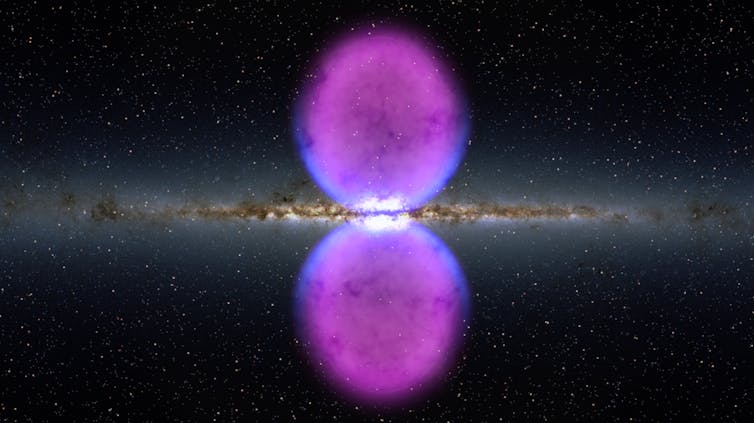
A glowing blob known as “the cocoon”, which appears to be inside one of the enormous gamma-ray emanations from the centre of our galaxy dubbed the “Fermi bubbles”, has puzzled astronomers since it was discovered in 2012.
In new research published in Nature Astronomy, we show the cocoon is caused by gamma rays emitted by fast-spinning extreme stars called “millisecond pulsars” located in the Sagittarius dwarf galaxy, which orbits the Milky Way. While our results clear up the mystery of the cocoon, they also cast a pall over attempts to search for dark matter in any gamma-ray glow it may emit.
Seeing With Gamma Rays
Thankfully for life on Earth, our atmosphere blocks gamma rays. These are particles of light with energies more than a million times higher than the photons we detect with our eyes.
Because our ground-level view is obscured, scientists had no idea of the richness of the gamma-ray sky until instruments were lofted into space. But, starting with the serendipitous discoveries made by the Vela satellites (put into orbit in the 1960s to monitor the Nuclear Test Ban), more and more of this richness has been revealed.
The state-of-the-art gamma-ray instrument operating today is the Fermi Gamma Ray Space Telescope, a large NASA mission in orbit for more than a decade. Fermi’s ability to resolve fine detail and detect faint sources has uncovered a number of surprises about our Milky Way and the wider cosmos.
Mysterious Bubbles
One of these surprises emerged in 2010, soon after Fermi’s launch: something in the Milky Way’s centre is blowing what look like a pair of giant, gamma-ray-emitting bubbles. These completely unanticipated “Fermi bubbles” cover fully 10% of the sky.
A prime suspect for the source of the bubbles is the Galaxy’s resident supermassive black hole. This behemoth, 4 million times more massive than the Sun, lurks in the galactic nucleus, the region from which the bubbles emanate.
Most galaxies host such giant black holes in their centres. In some, these black holes are actively gulping down matter. Thus fed, they simultaneously spew out giant, outflowing “jets” visible across the electromagnetic spectrum.
Thus a question researchers asked after the discovery of the bubbles: can we find a smoking gun tying them to our Galaxy’s supermassive black hole? Soon, tentative evidence did emerge: there was a hint, inside each bubble, of a thin gamma-ray jet pointing back towards the galactic centre.
With time and further data, this picture became muddied, however. While the jet-like feature in one of the bubbles was confirmed, the apparent jet in the other seemed to evaporate under scrutiny.
The bubbles looked strangely lopsided: one contained an elongated bright spot – the “cocoon” – with no counterpart in the other bubble.
The Cocoon And Where It Comes From
Our recent work in Nature Astronomy is a deep examination of the nature of the “cocoon”. Remarkably, we found this structure has nothing to do with the Fermi bubbles or, indeed, the Galaxy’s supermassive black hole.
Rather, we found the cocoon is actually something else entirely: gamma rays from the Sagittarius dwarf galaxy, which happens to be behind the southern bubble as seen from the position of Earth.
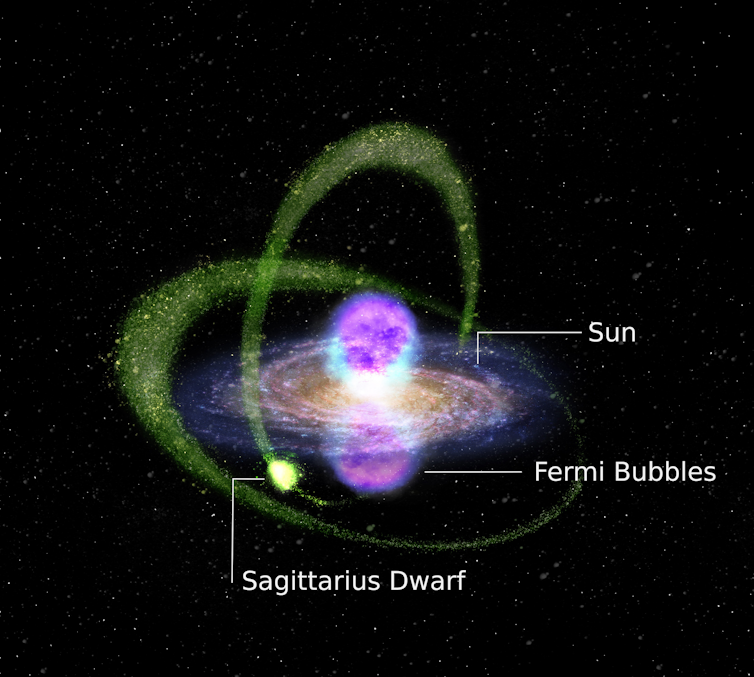
The Sagittarius dwarf, so called because its sky position is in the constellation of Sagittarius, is a “satellite” galaxy orbiting the Milky Way. It is the remnant of a much larger galaxy that the Milky Way’s strong gravitational field has literally ripped apart. Indeed, stars pulled out of the Sagittarius dwarf can be found in “tails” that wrap around the entire sky.
What’s Making The Gamma Rays?
In the Milky Way, the main source of gamma rays is when high-energy particles, called cosmic rays, collide with the very tenuous gas between the stars.
However, this process cannot explain the gamma rays emitted from the Sagittarius dwarf. It long ago lost its gas to the same gravitational harassment that pulled away so many of its stars.
So where do the gamma rays come from?
We considered several possibilities, including the exciting prospect they are a signature of dark matter, the invisible substance known only by its gravitational effects which astronomers believe makes up much of the universe. Unfortunately, the shape of the cocoon closely matches the distribution of visible stars, which rules out dark matter as the origin.
One way or another, the stars were responsible for the gamma rays. And yet: the stars of the Saggitarius dwarf are old and quiescent. What type of source amongst such a population produces gamma rays?
Millisecond Pulsars
We are satisfied there is only one possibility: rapidly spinning objects called “millisecond pulsars”. These are the remnants of particular stars, significantly more massive than the Sun, that are also closely orbiting another star.
Under just the right circumstances, such binary systems produce a neutron star – an object about as heavy as the Sun but only about 20km across – that rotates hundreds of times per second.
Because of their rapid rotation and strong magnetic field, these neutron stars act as natural particle accelerators: they launch particles at extremely high energy into space.
These particles then emit gamma rays. Millisecond pulsars in the Sagittarius dwarf were the ultimate source of the mysterious cocoon, we found.
The Hunt For Dark Matter
Our findings shed new light – pun intended – on millisecond pulsars as sources of gamma rays in other old stellar systems.
At the same time, they also cast a pall over efforts to find evidence for dark matter via observations of other satellite galaxies of the Milky Way; unfortunately, there is a stronger “background” of gamma rays from millisecond pulsars in these systems than previously realised.
Thus, any signal they produce might not be unambiguously interpreted as due to dark matter.
The hunt for dark matter signals goes on.![]()
Roland Crocker, Associate Professor of Astronomy, Australian National University
This article is republished from The Conversation under a Creative Commons license. Read the original article.
Pollution Exposure In Infancy Alters Gut Microorganisms; May Boost Disease Risk
- Avoid walking outdoors in high-traffic zones
- Consider a low-cost air-filtration system, particularly for rooms children spend a lot of time in
- If you are cooking, open the windows
- And for new moms, breastfeed for as long as possible
Multicultural Health Week Highlights Cancer Screening To Save Lives
 The importance of cancer screening for culturally and linguistically diverse (CALD) communities is the key focus of this year's Multicultural Health Week.
The importance of cancer screening for culturally and linguistically diverse (CALD) communities is the key focus of this year's Multicultural Health Week.- A one-minute video to promote Multicultural Health Week 2022 with a focus on the three cancer screening programs in Arabic, Cantonese, Korean, Mandarin, Vietnamese and English
- A 45-second radio advertisement in 20 languages
- "What is cancer screening?" factsheet, available in 38 languages
- Multicultural Health Week Poster and social media assets in 38 languages.
New Strategy Targets Obesity Rates In NSW
- Prevention programs and services to support healthy eating and active living
- Routine advice on healthy eating and active living as part of clinical care
- Social marketing to support behavioural change towards healthy eating and active living
- Healthy food and built environments to support healthy eating and active living.
Frequency Of Premenstrual Anxiety, Mood Swings A Public Health Issue
How Does Nature Nurture The Brain?
Neolithic Culinary Traditions Uncovered
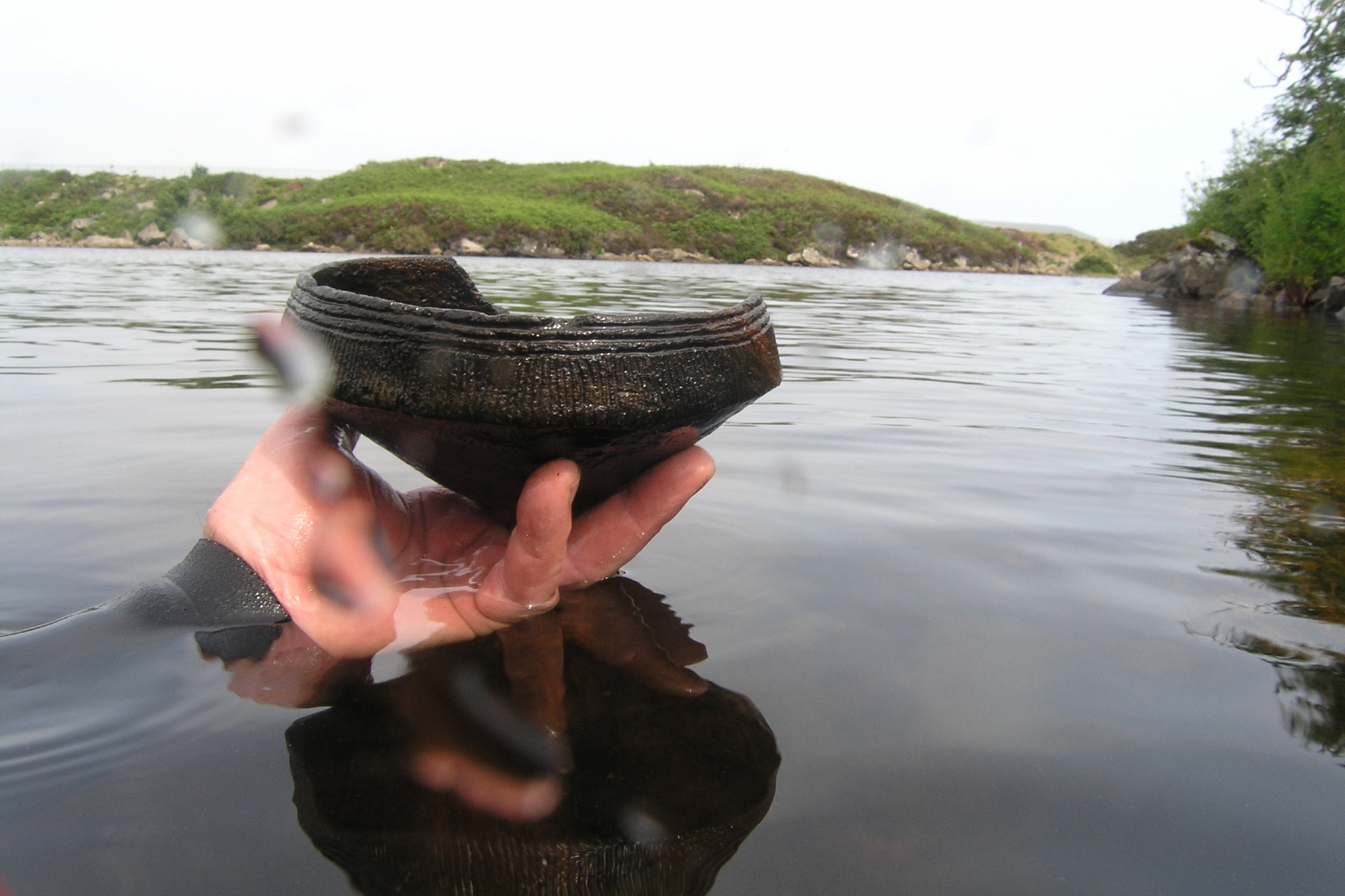
Study Calls For Change In Guidance About Eating Fish During Pregnancy
Bees Use Patterns -- Not Just Colours -- To Find Flowers
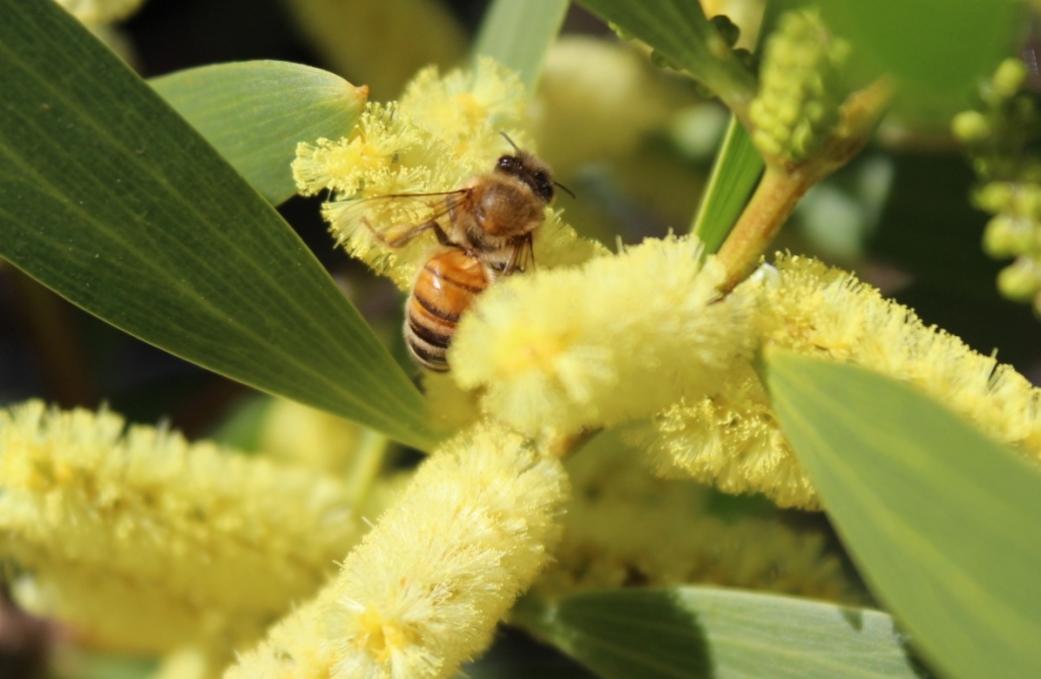
How Tardigrades Bear Dehydration
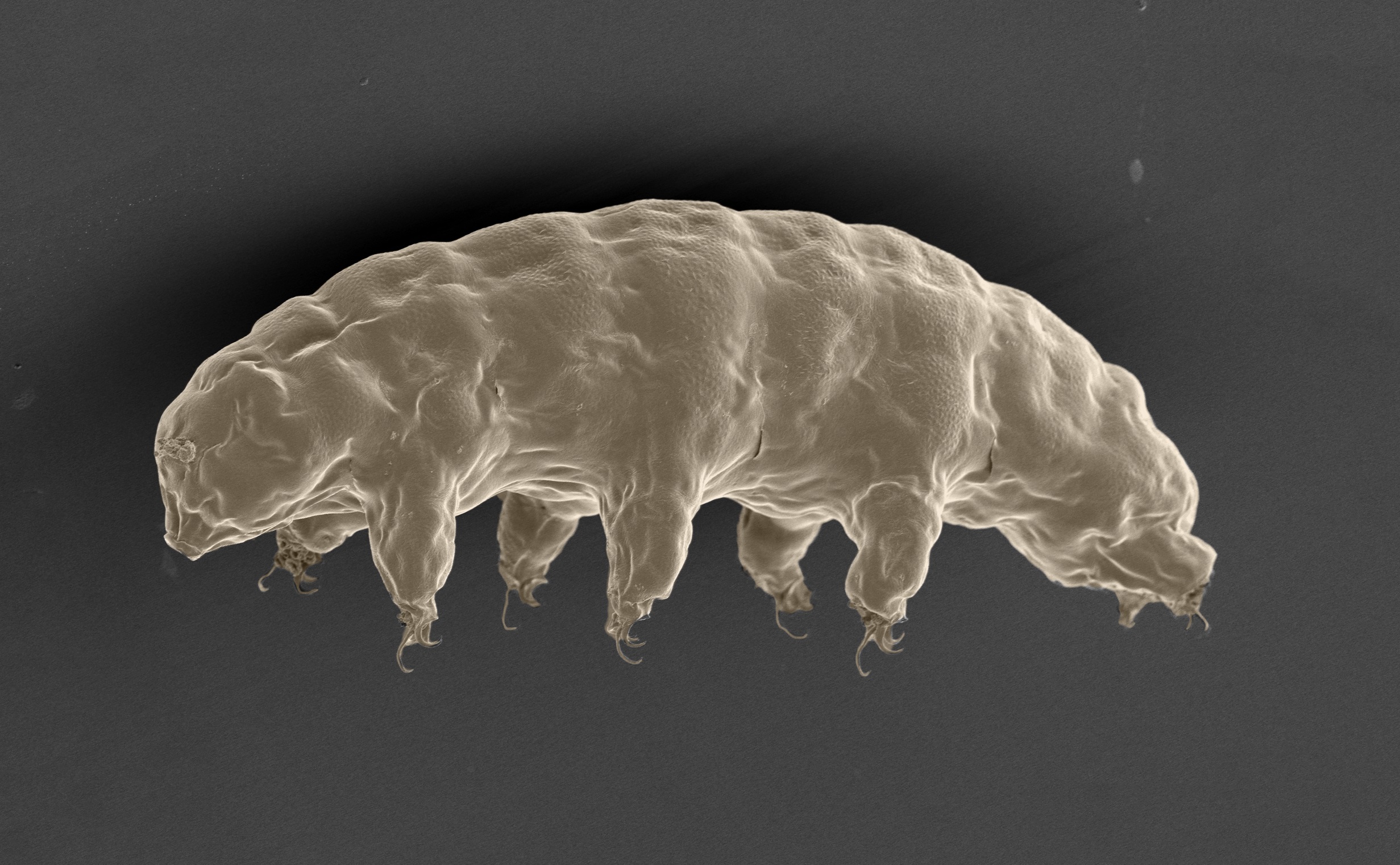
Disclaimer: These articles are not intended to provide medical advice, diagnosis or treatment. Views expressed here do not necessarily reflect those of Pittwater Online News or its staff.